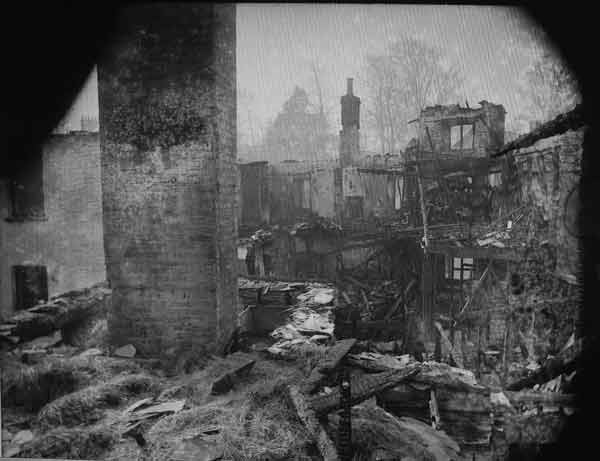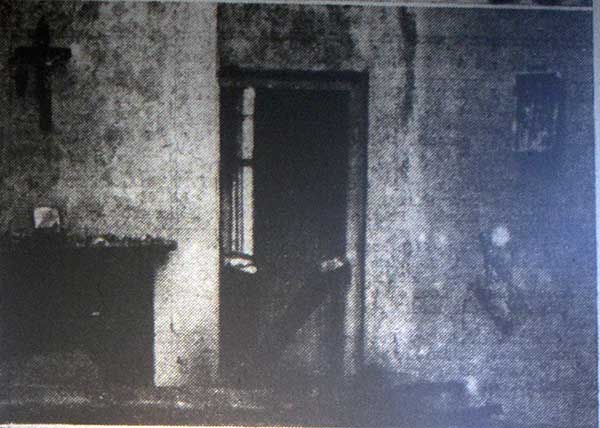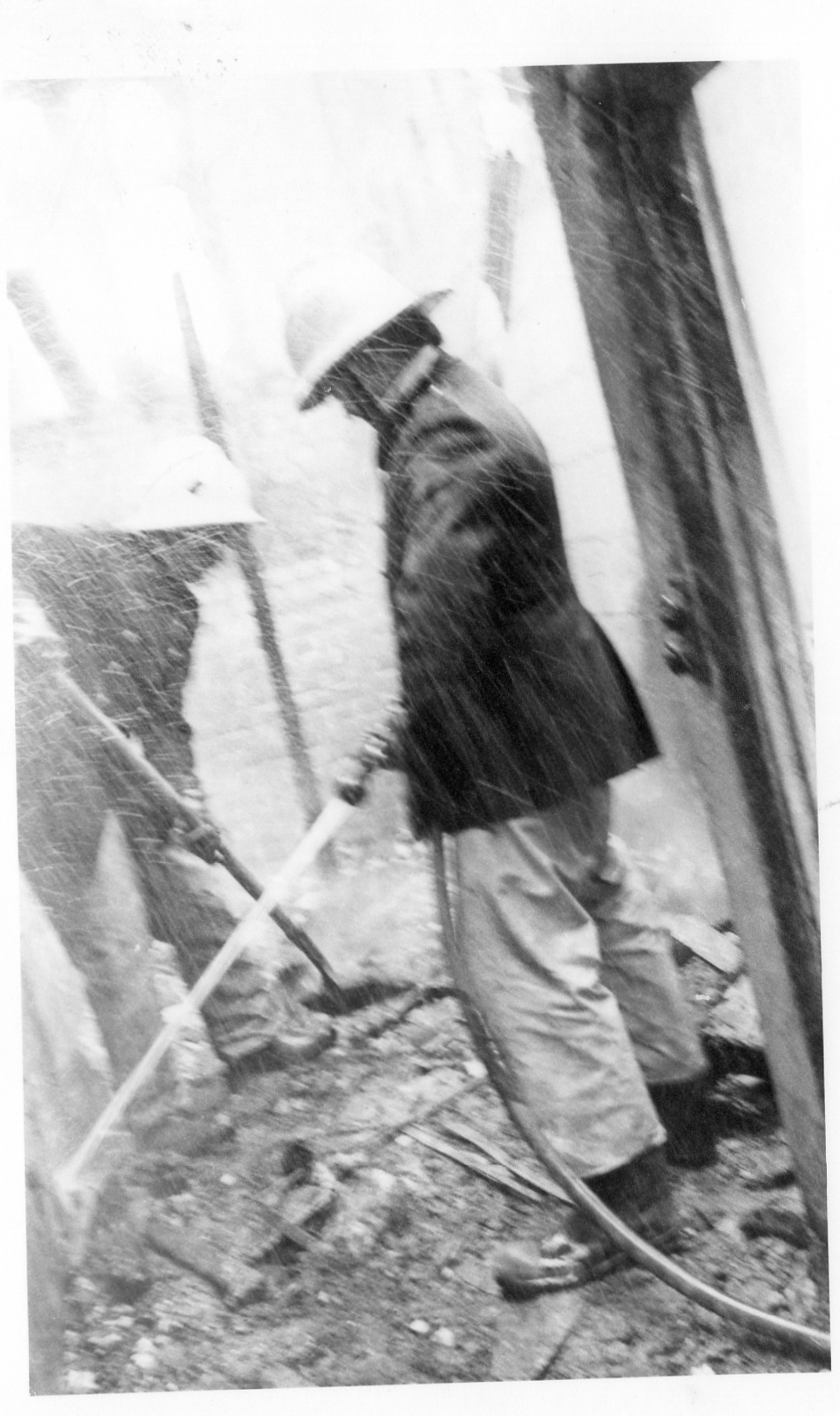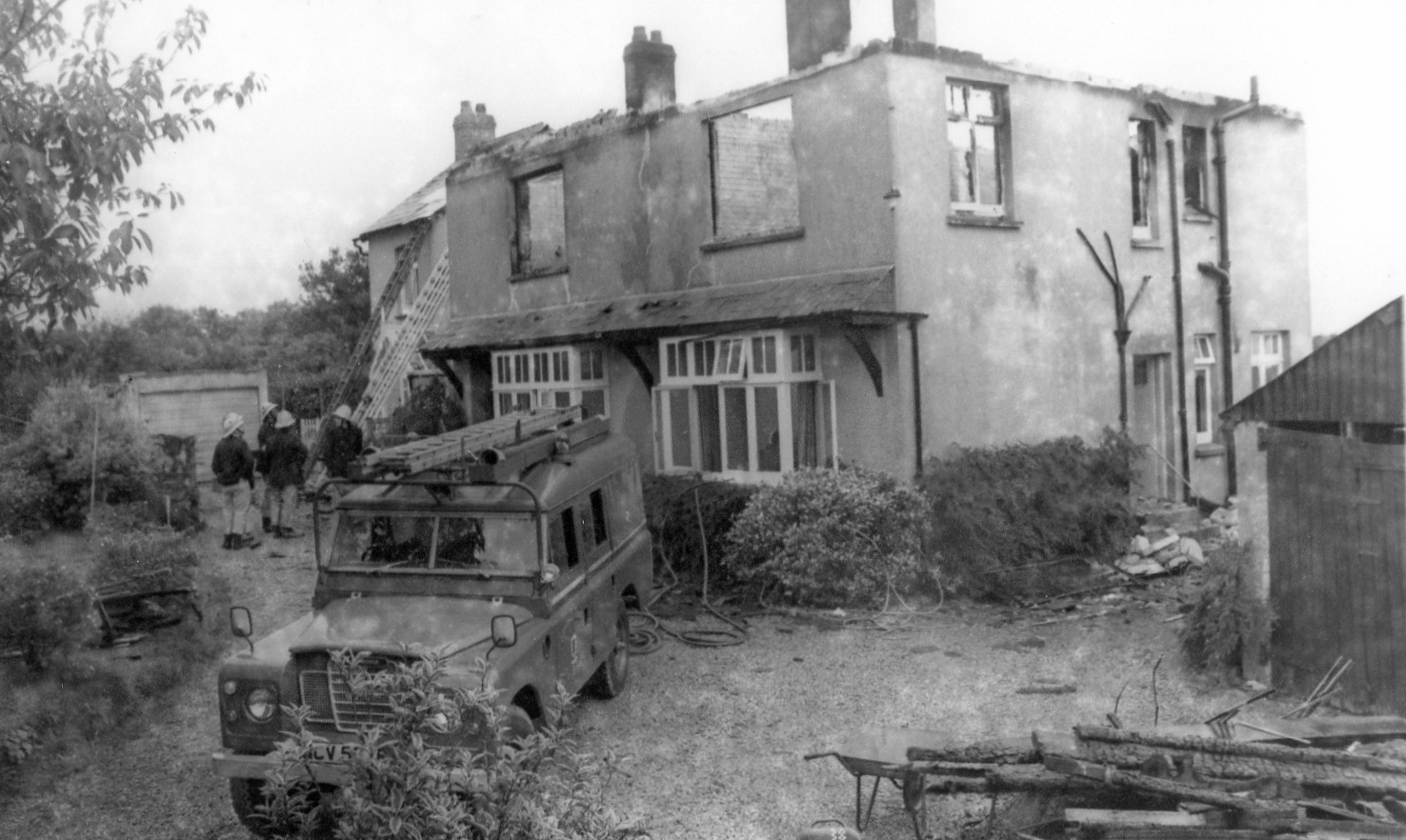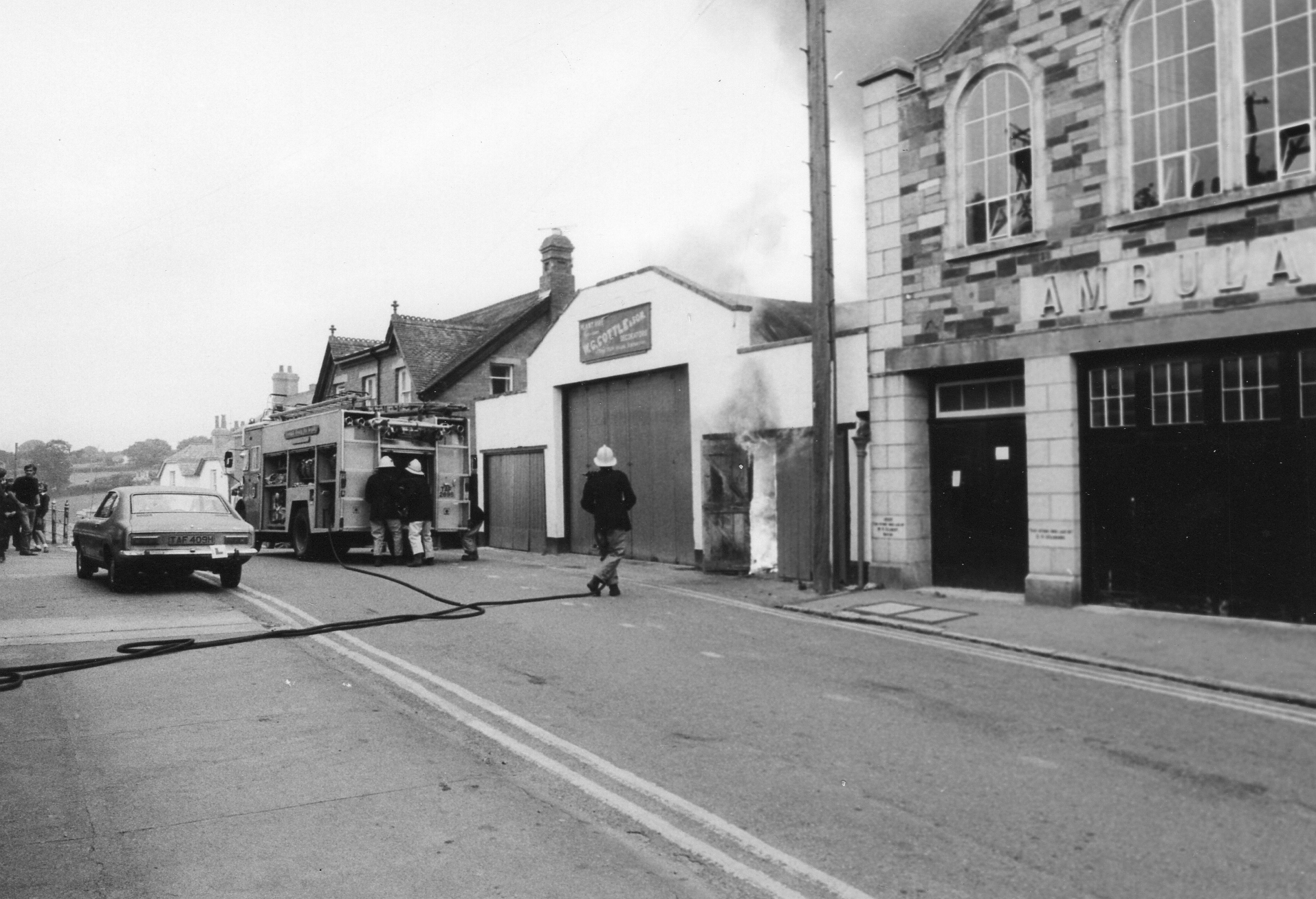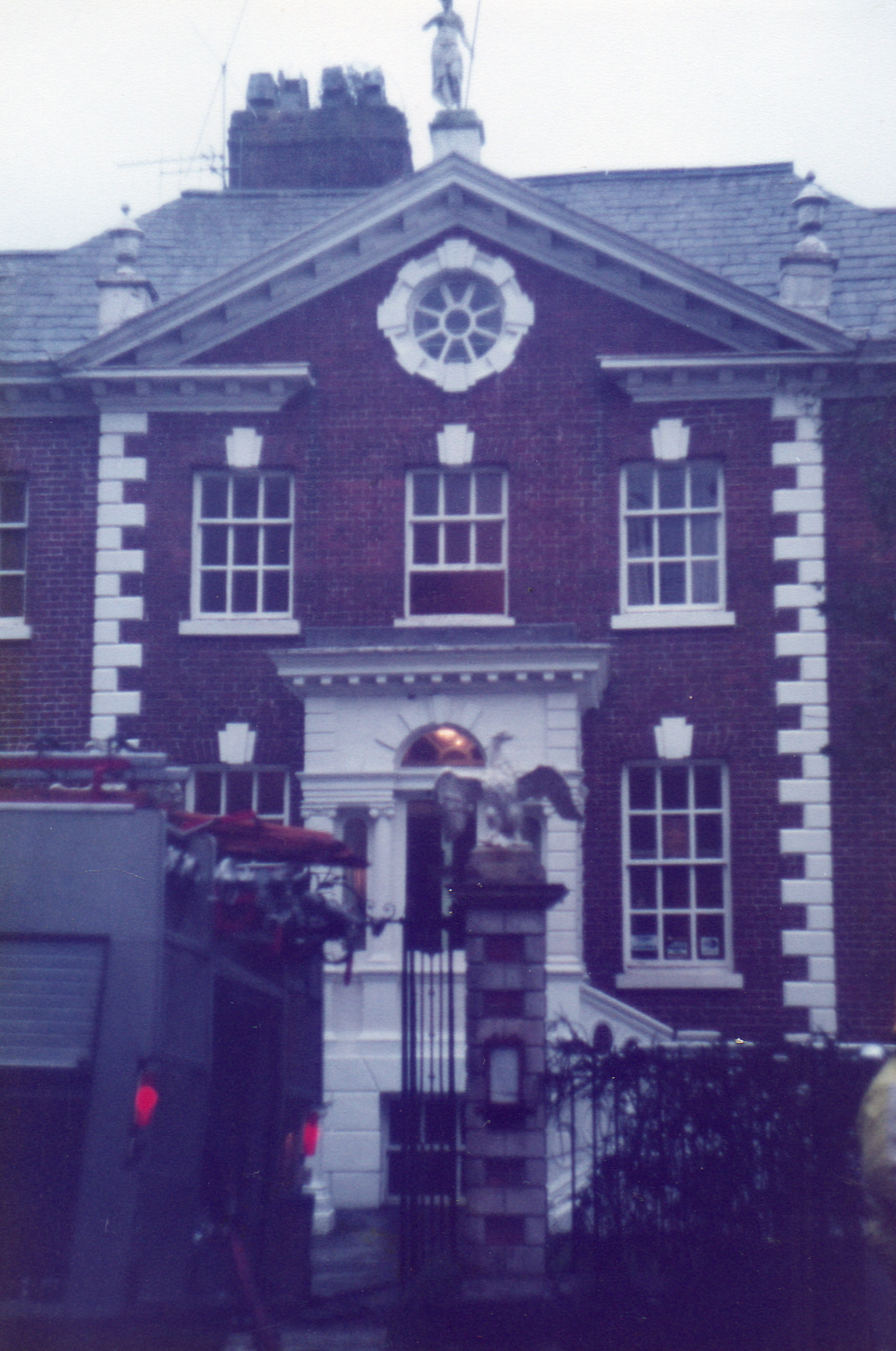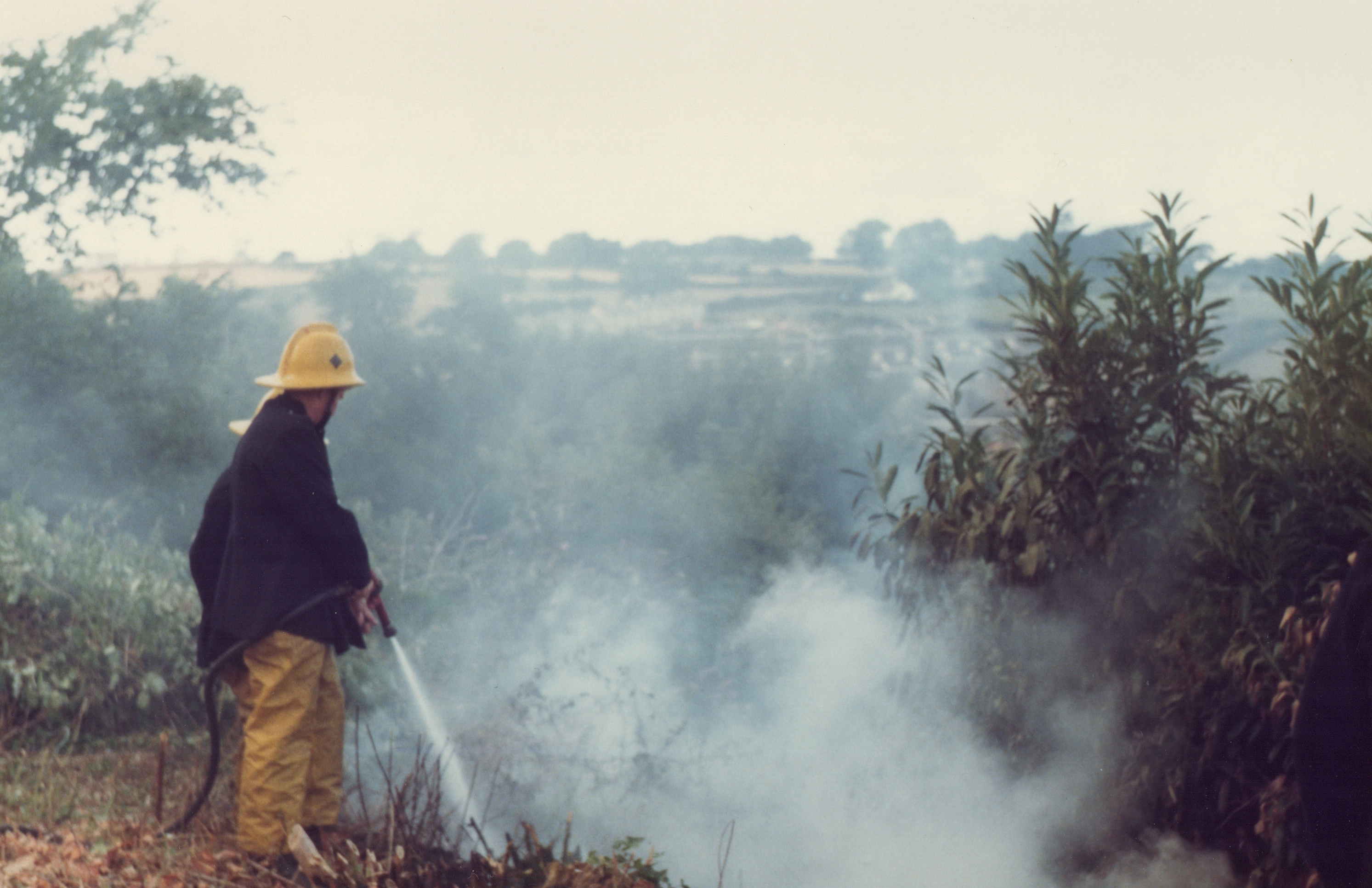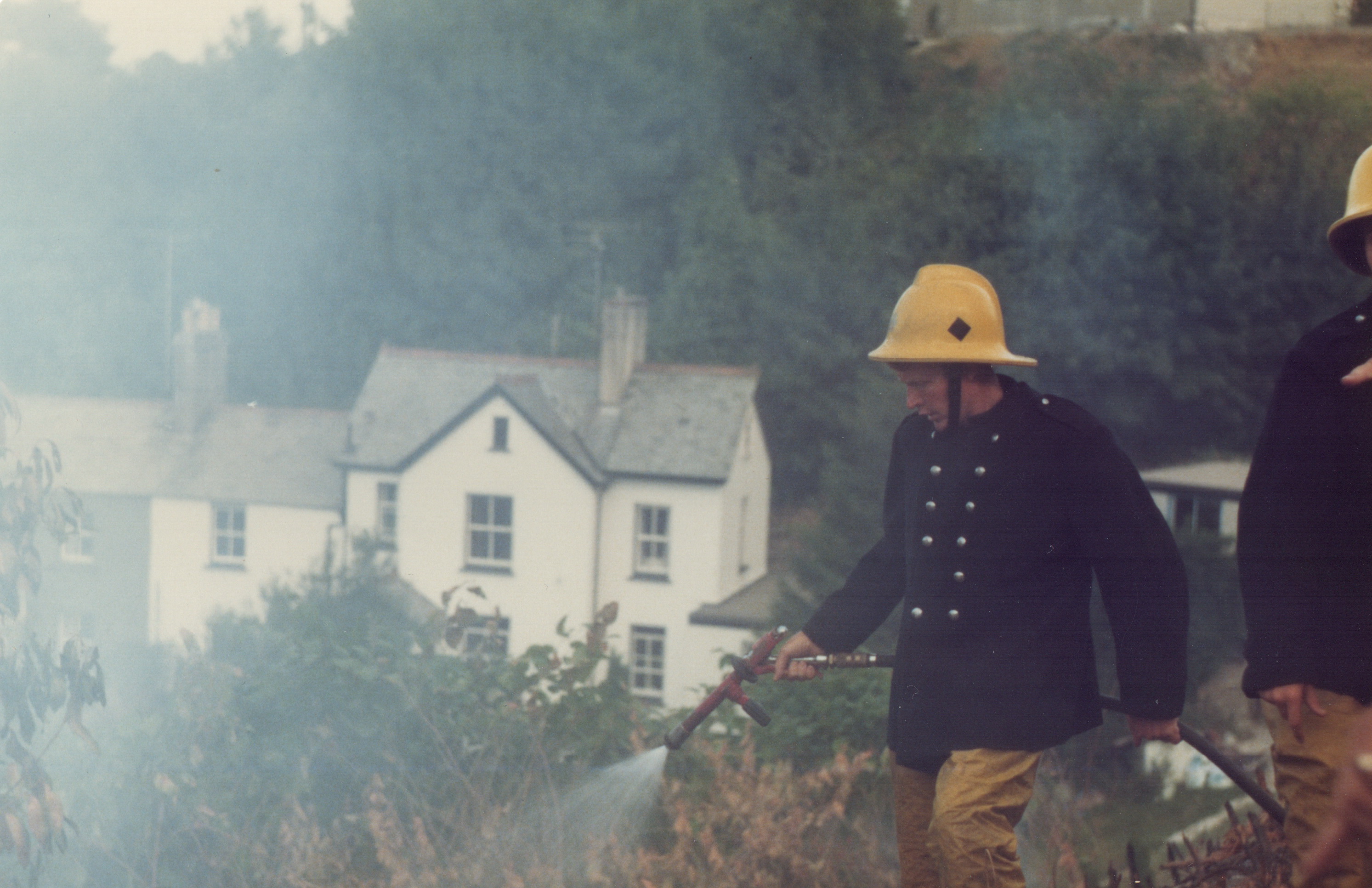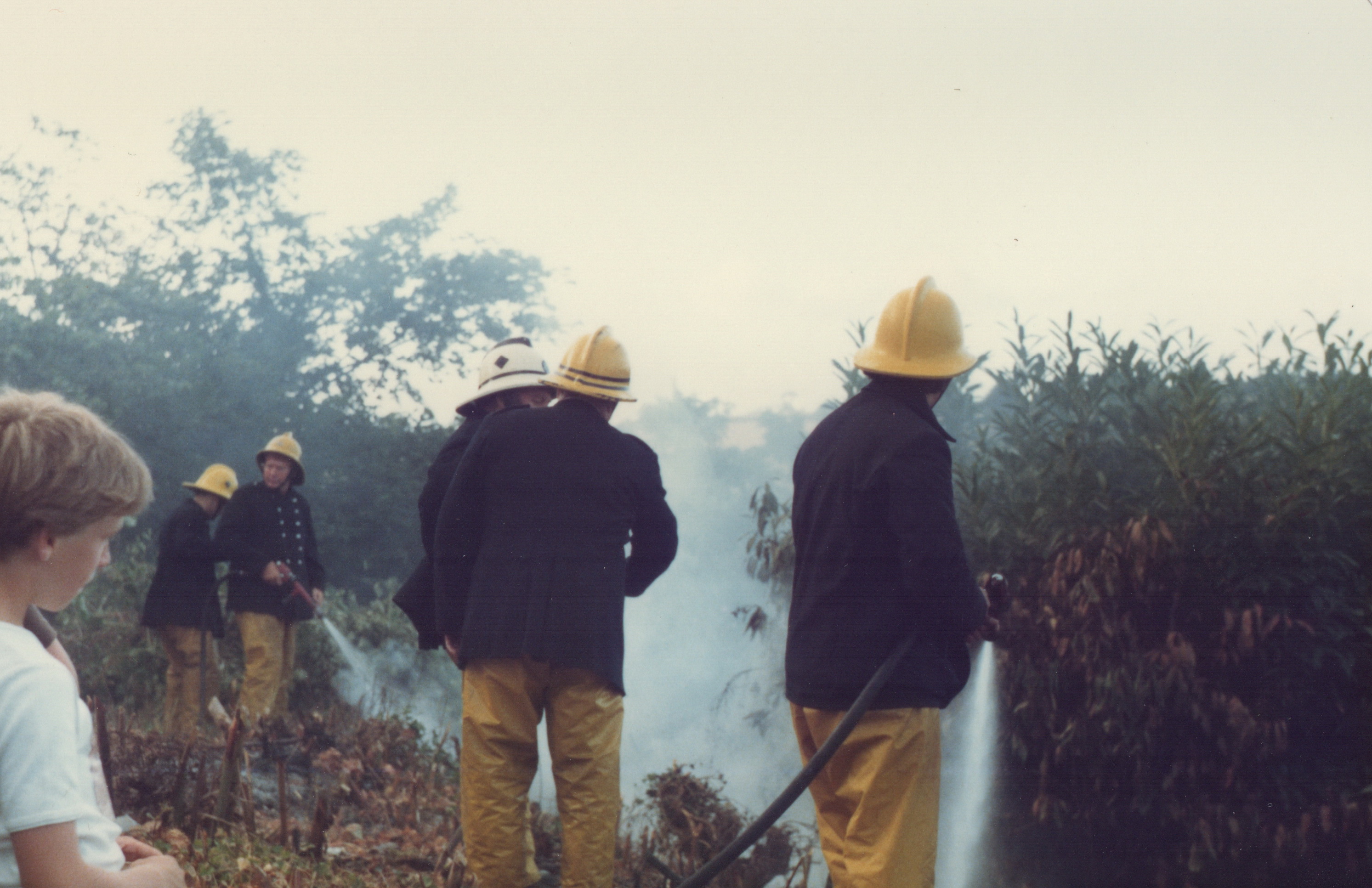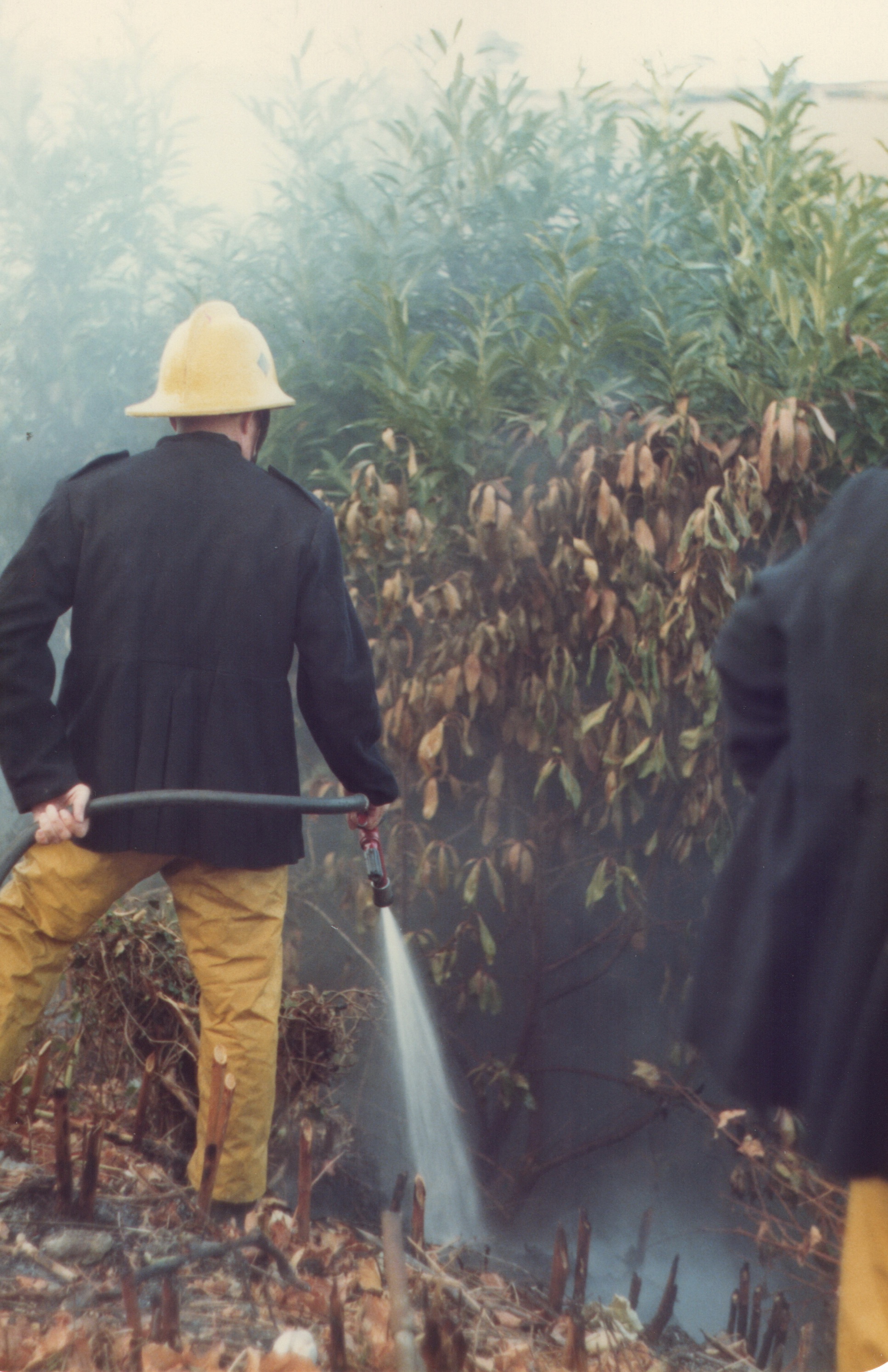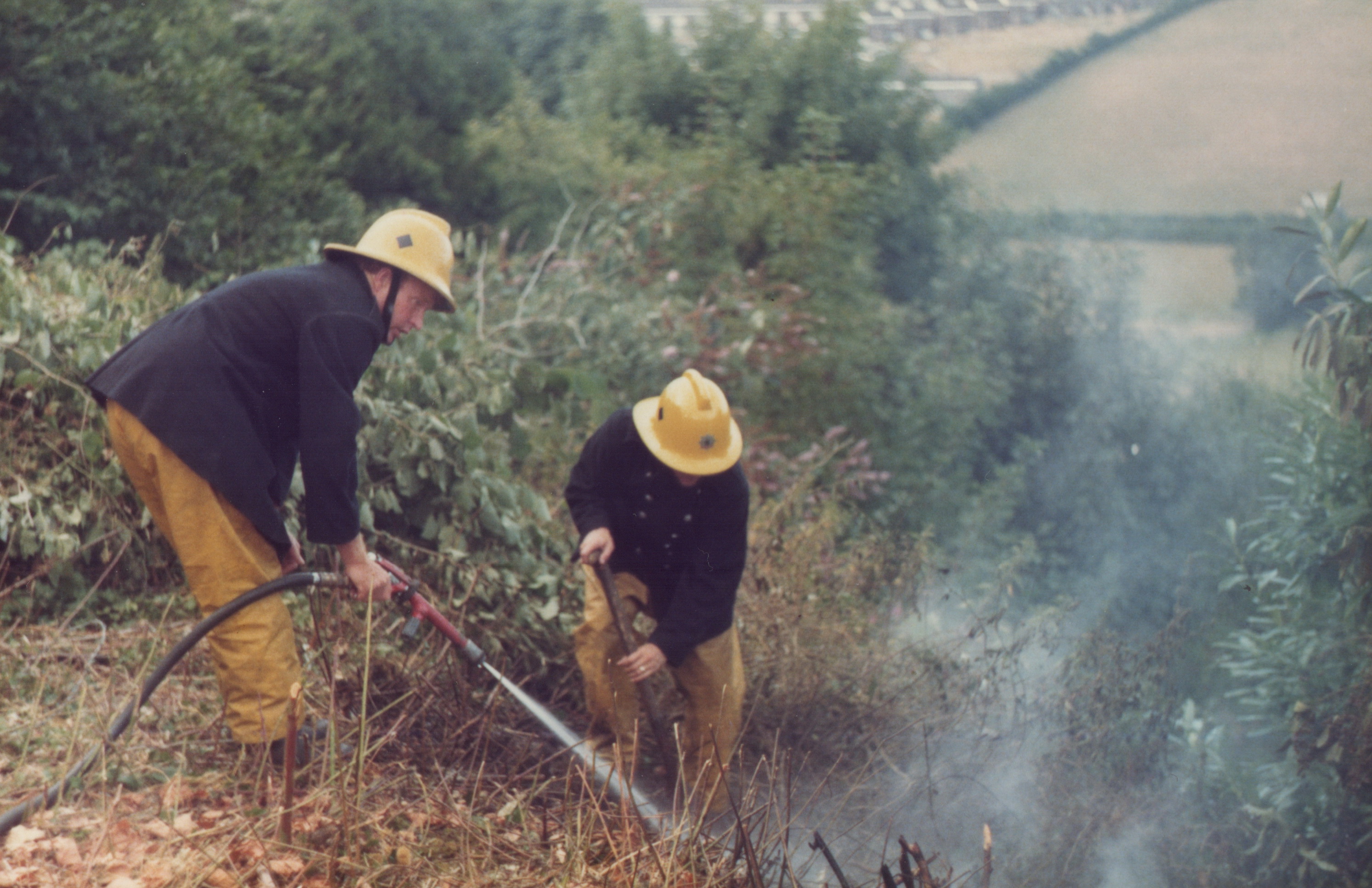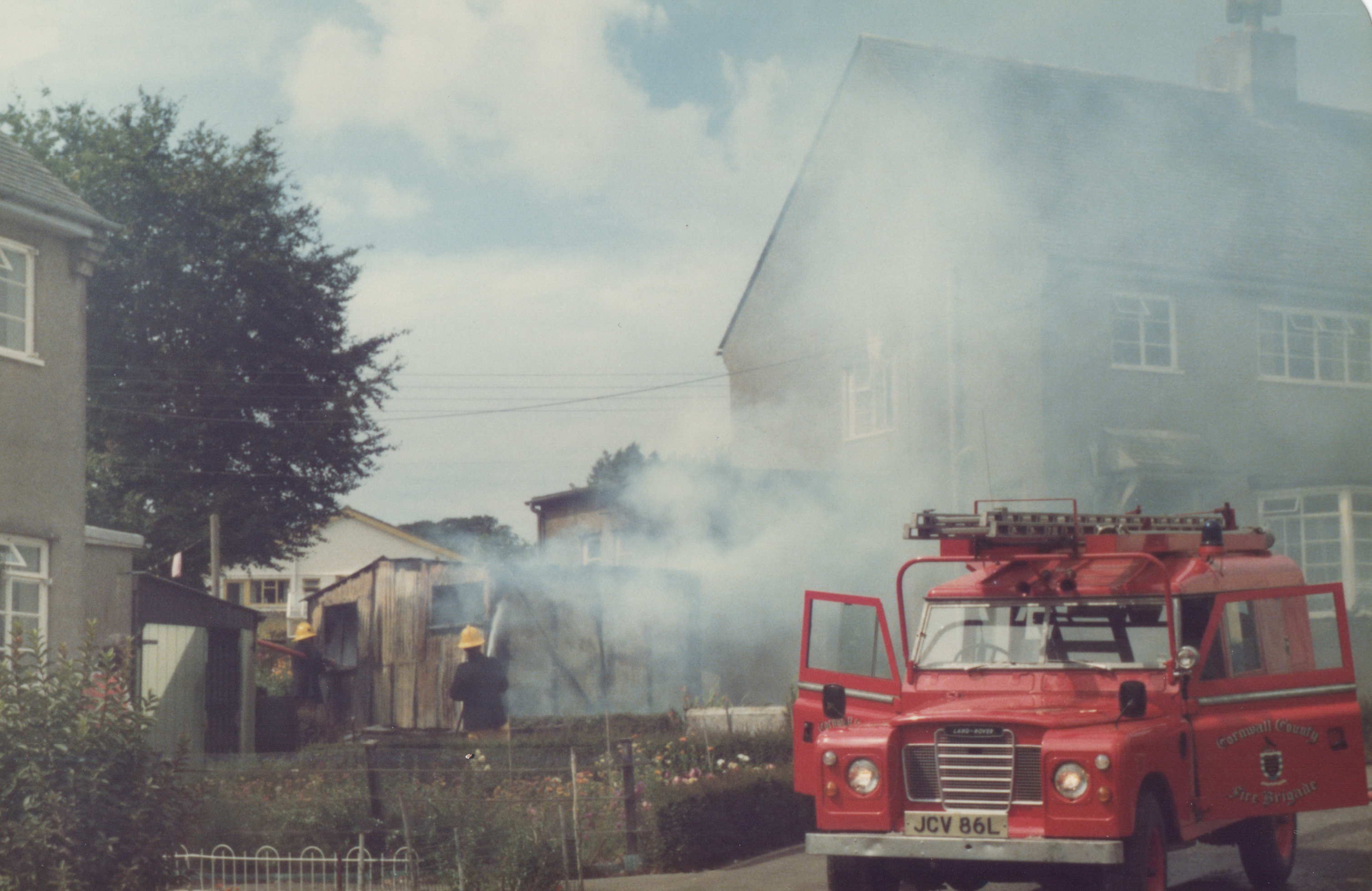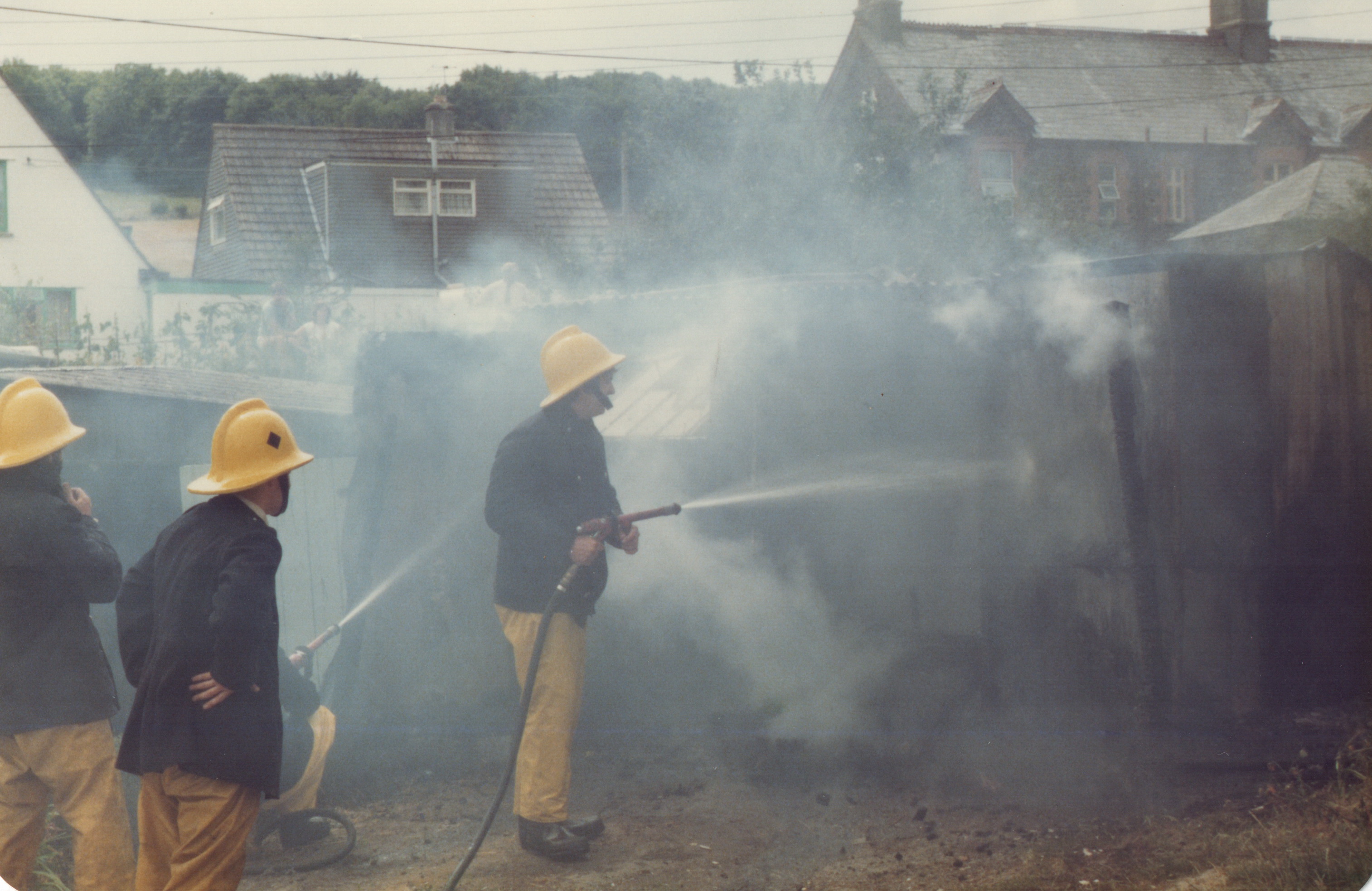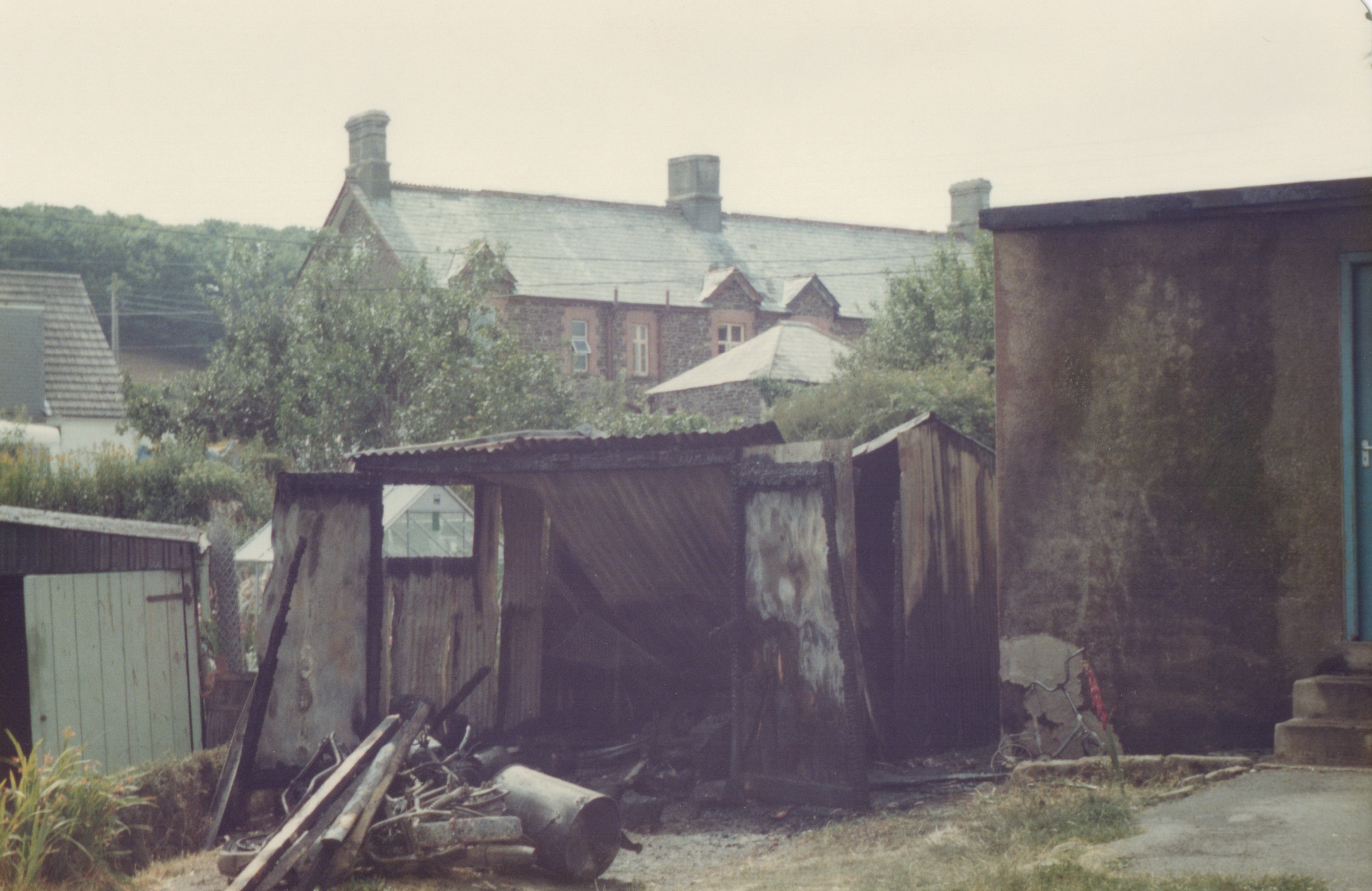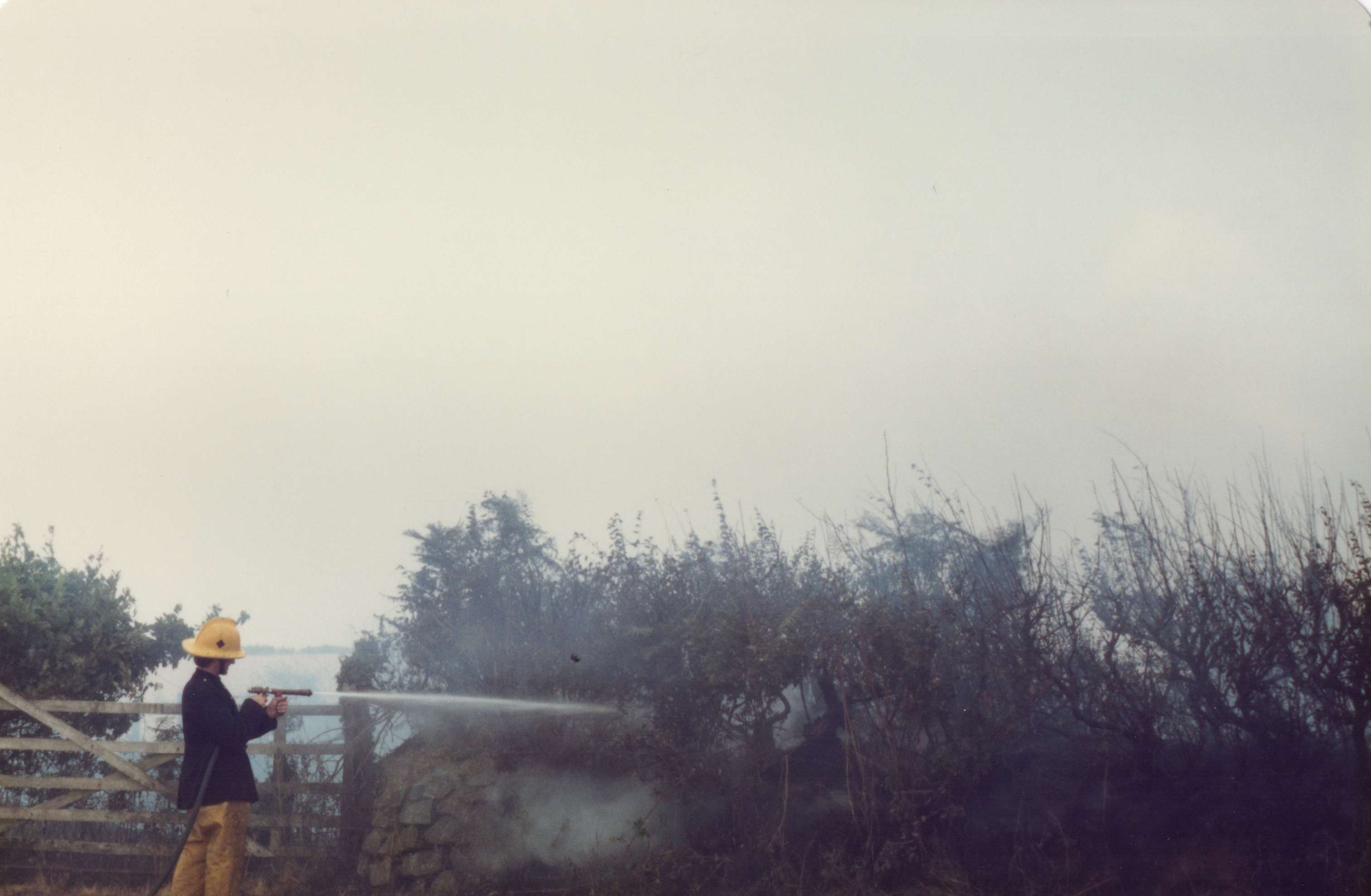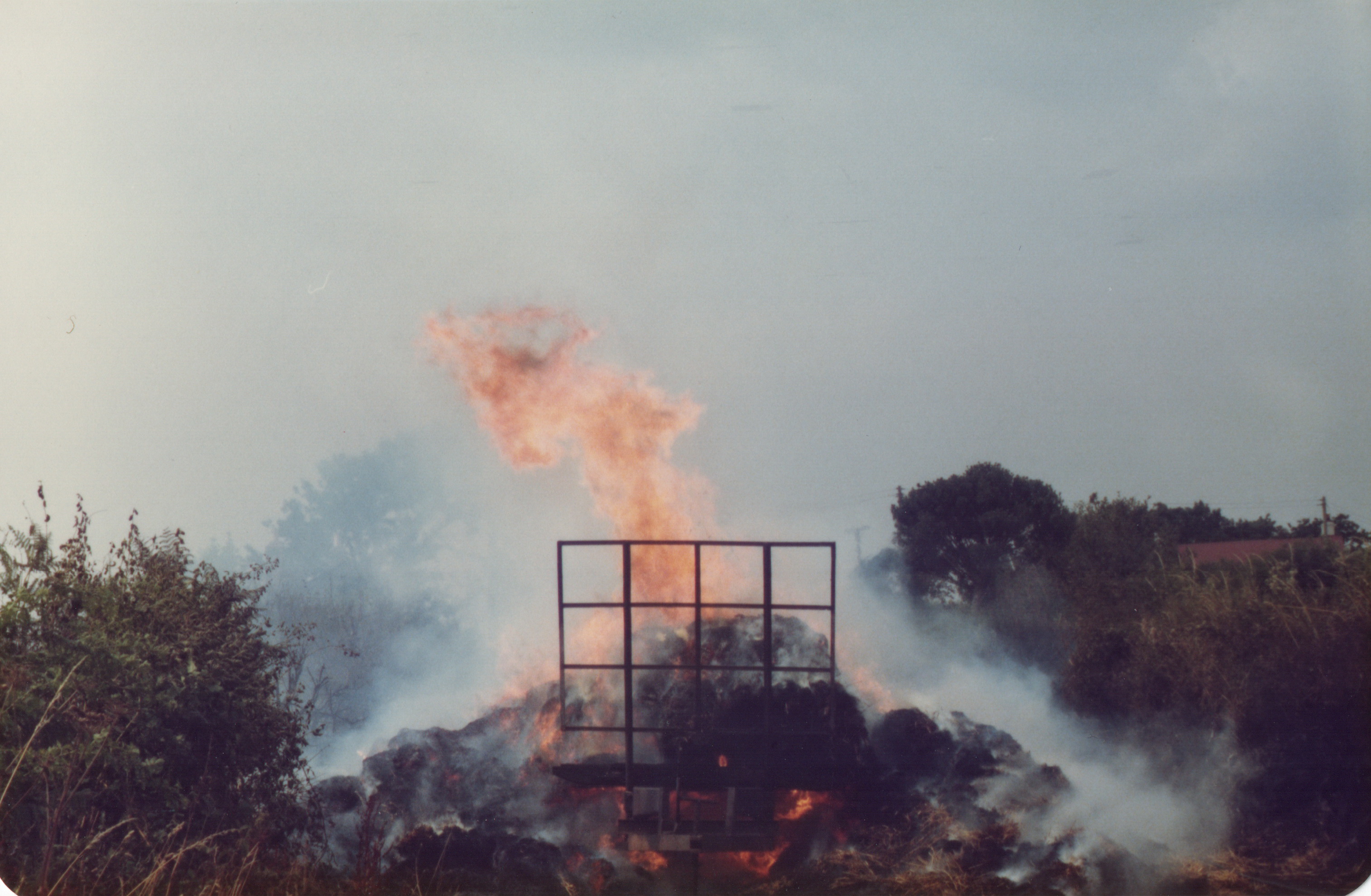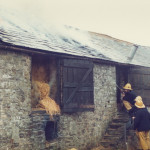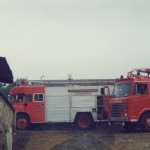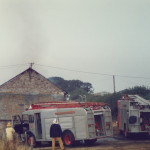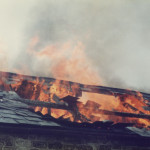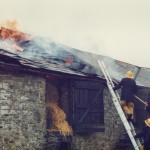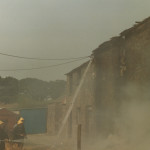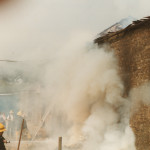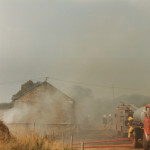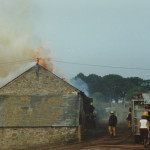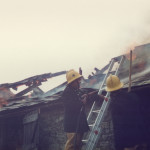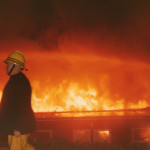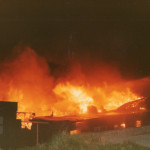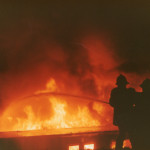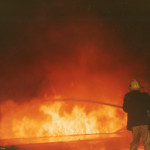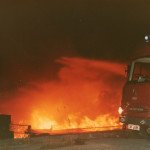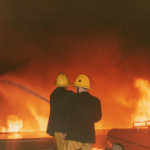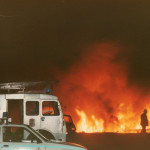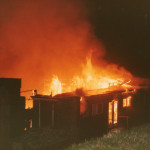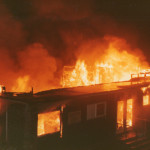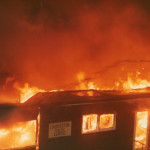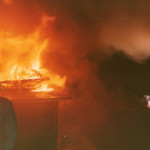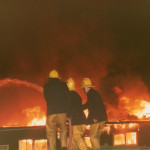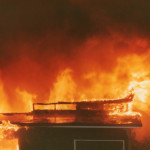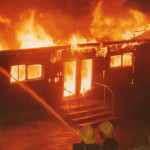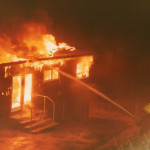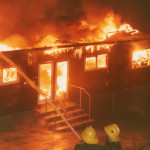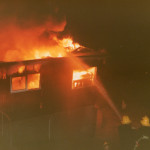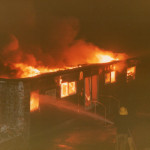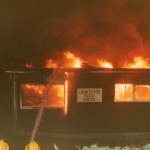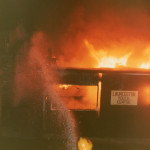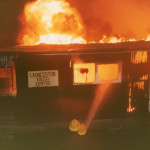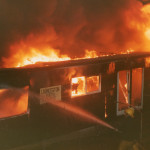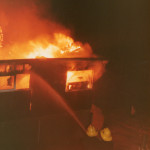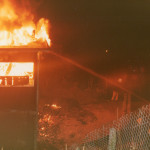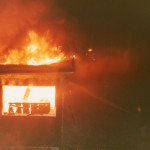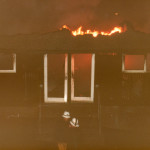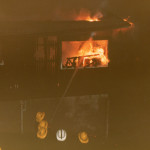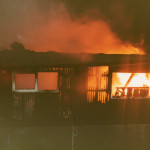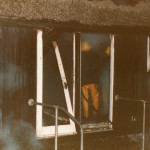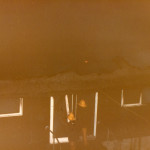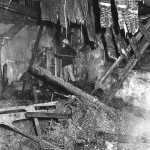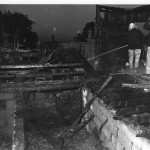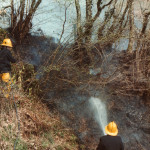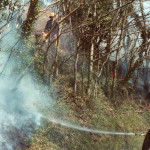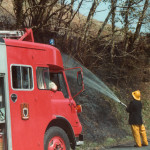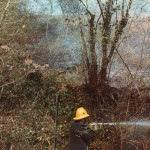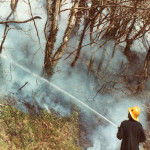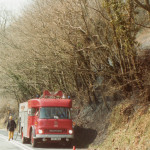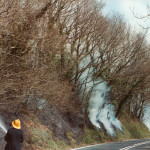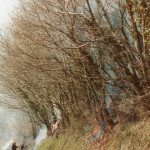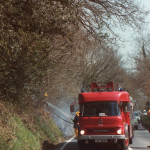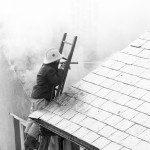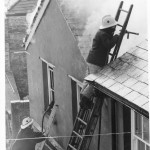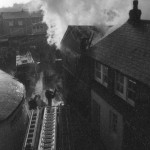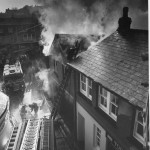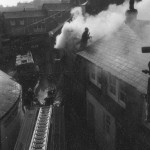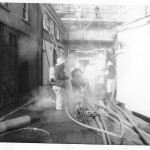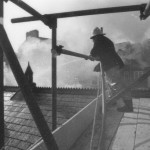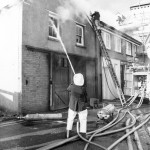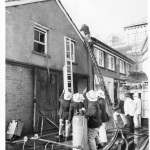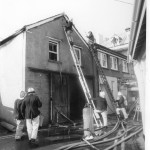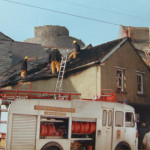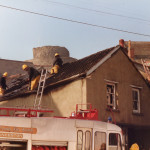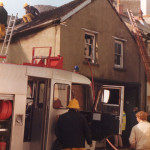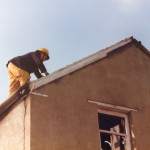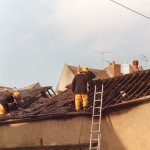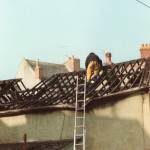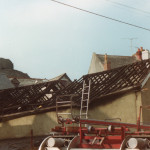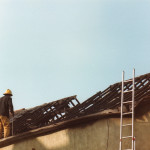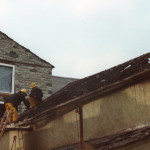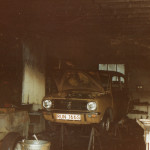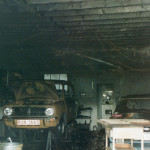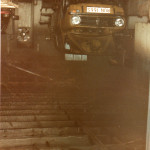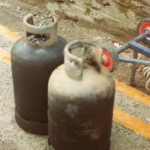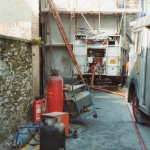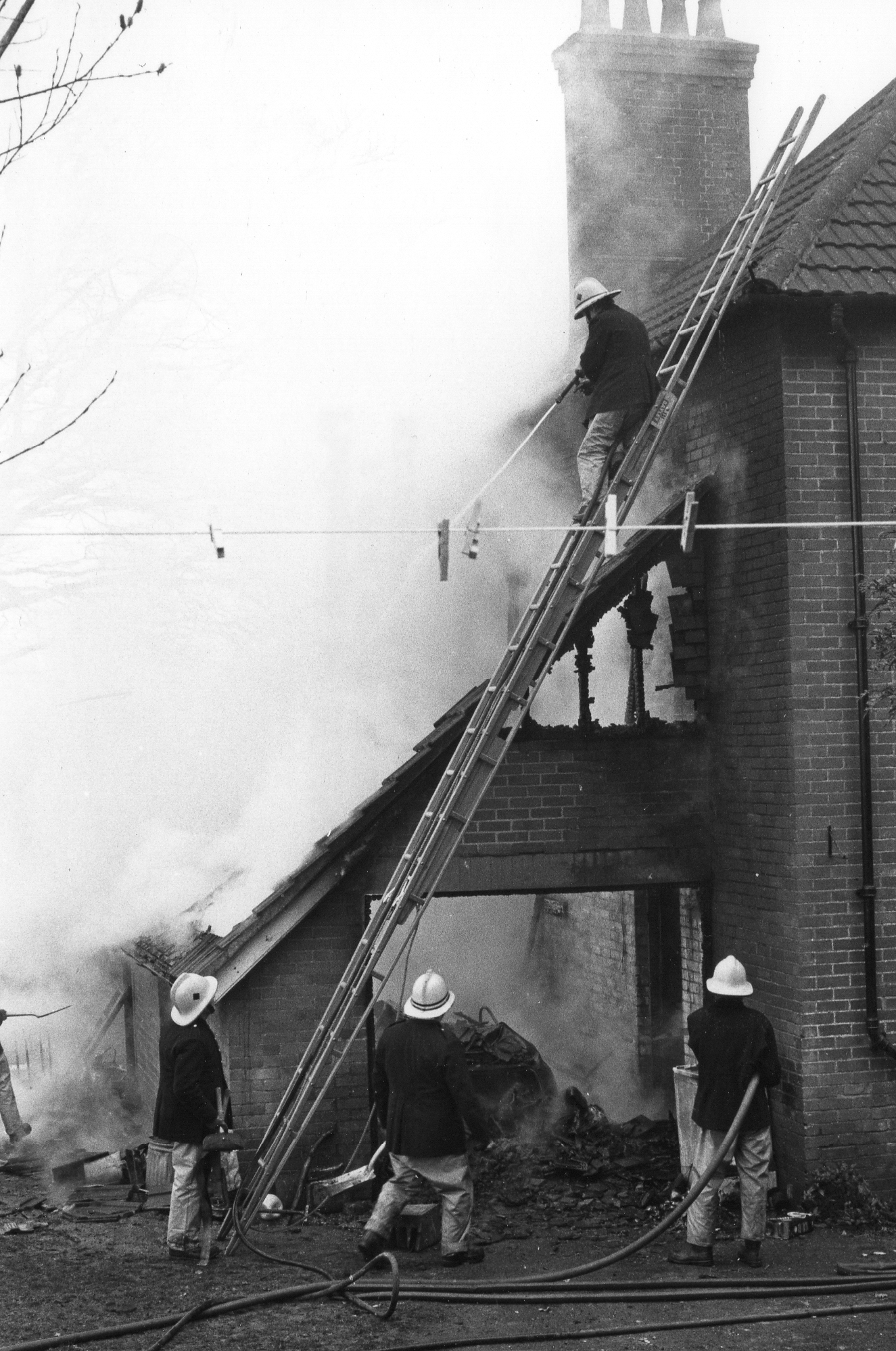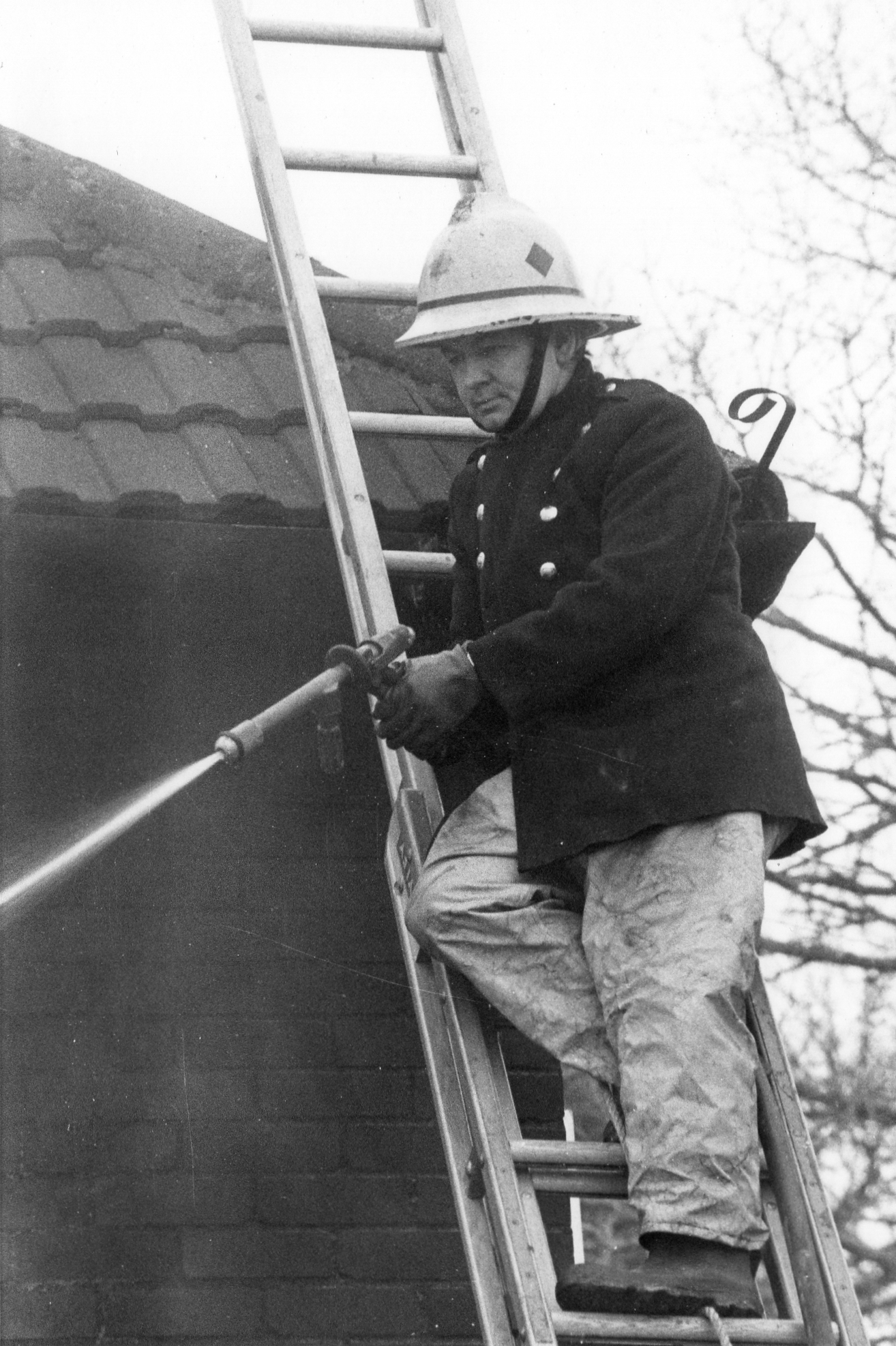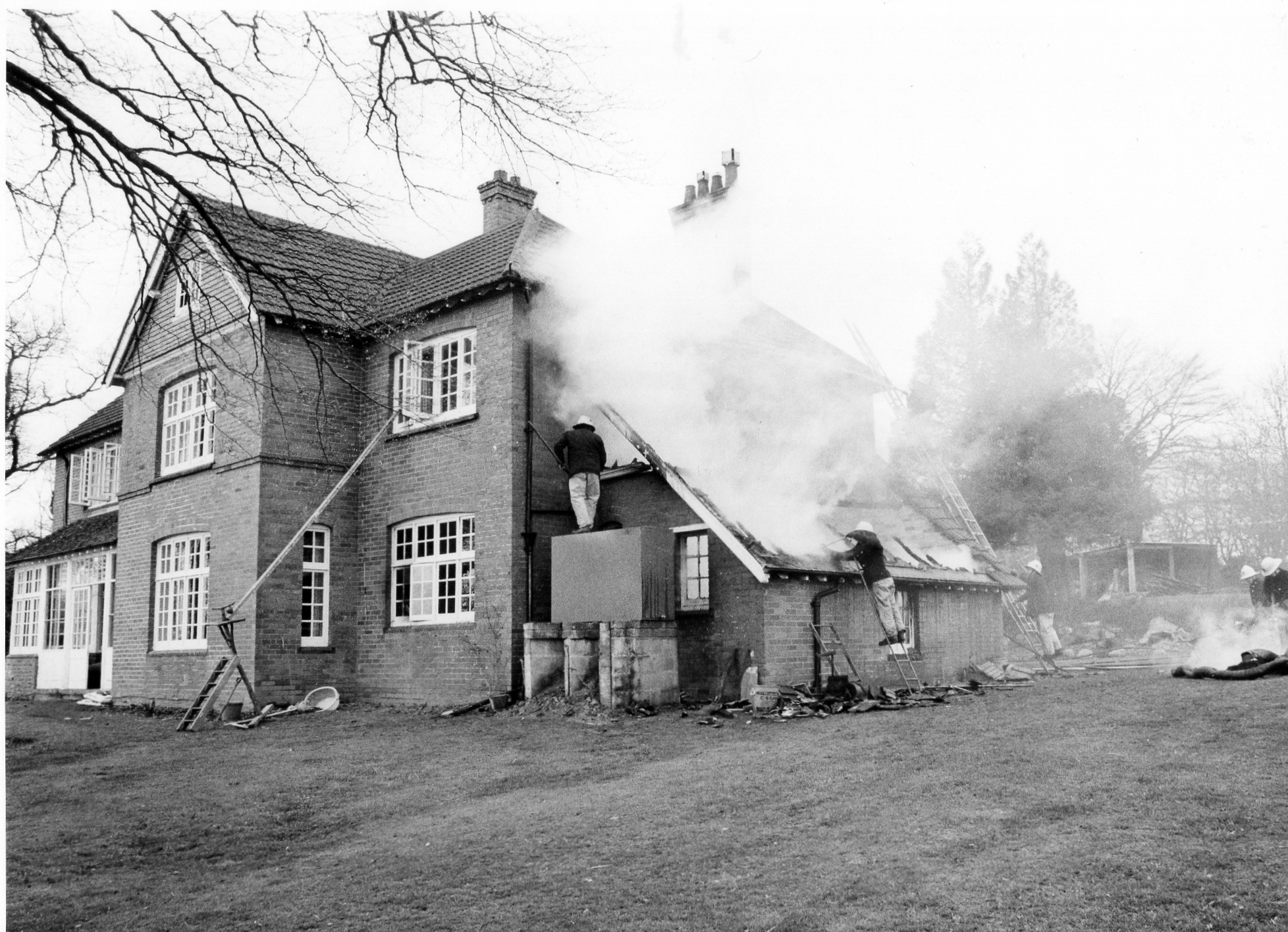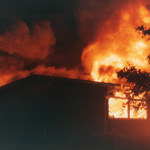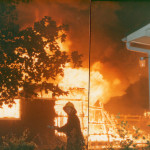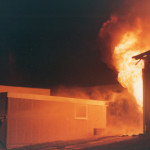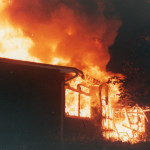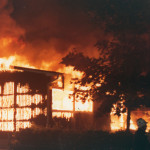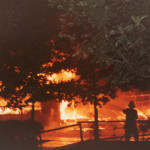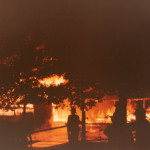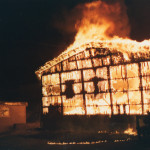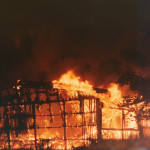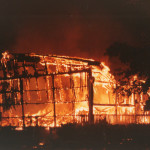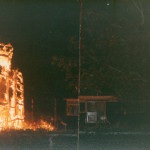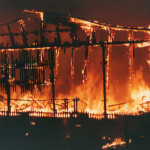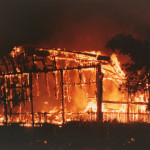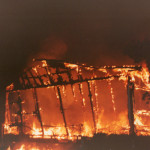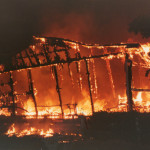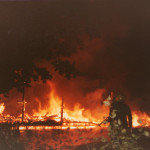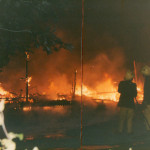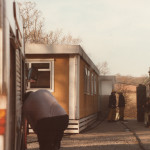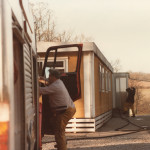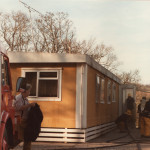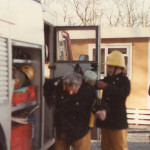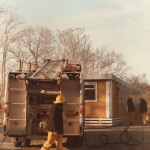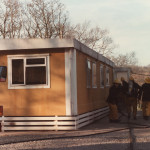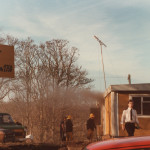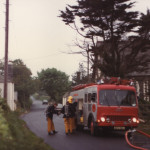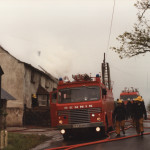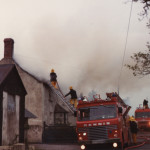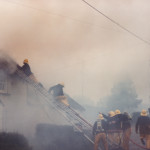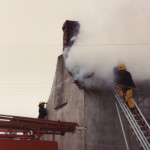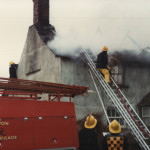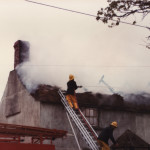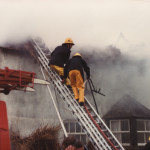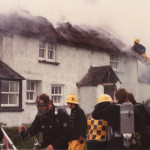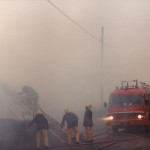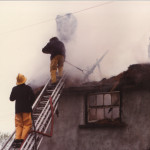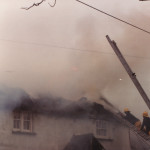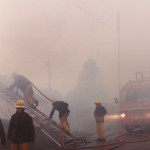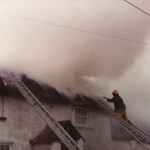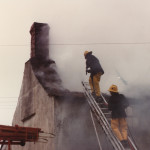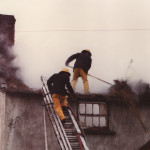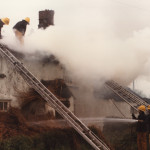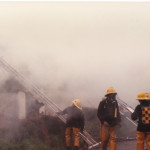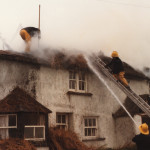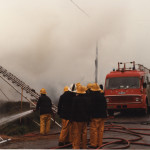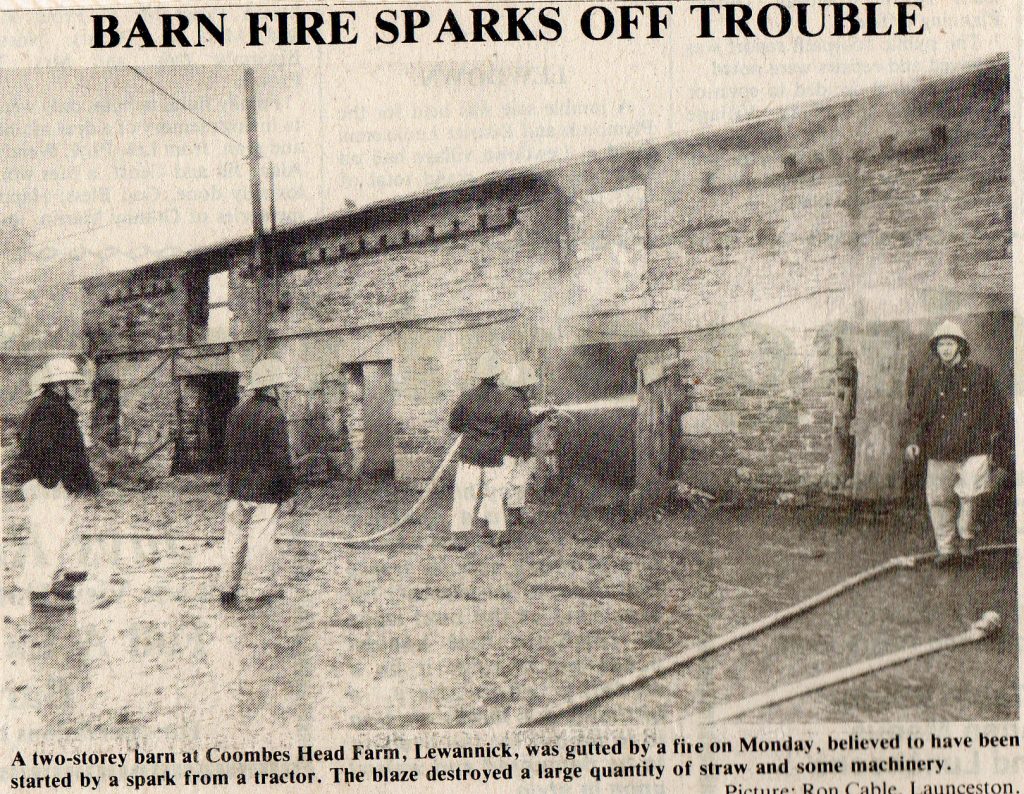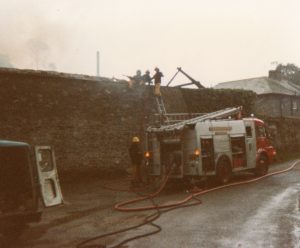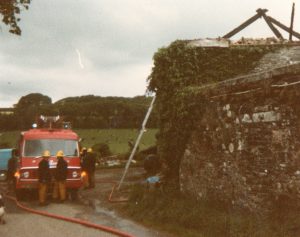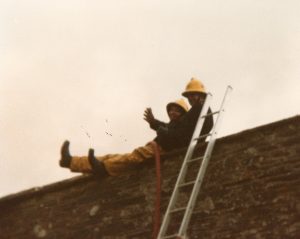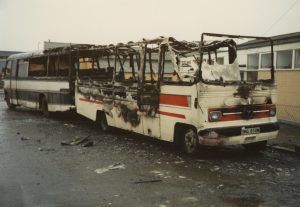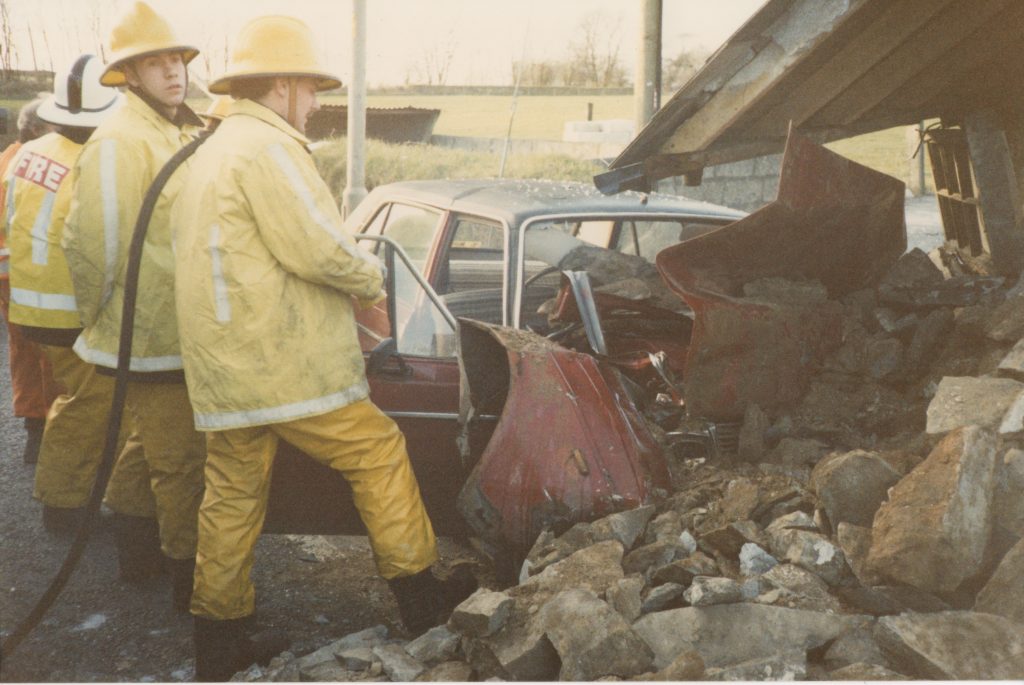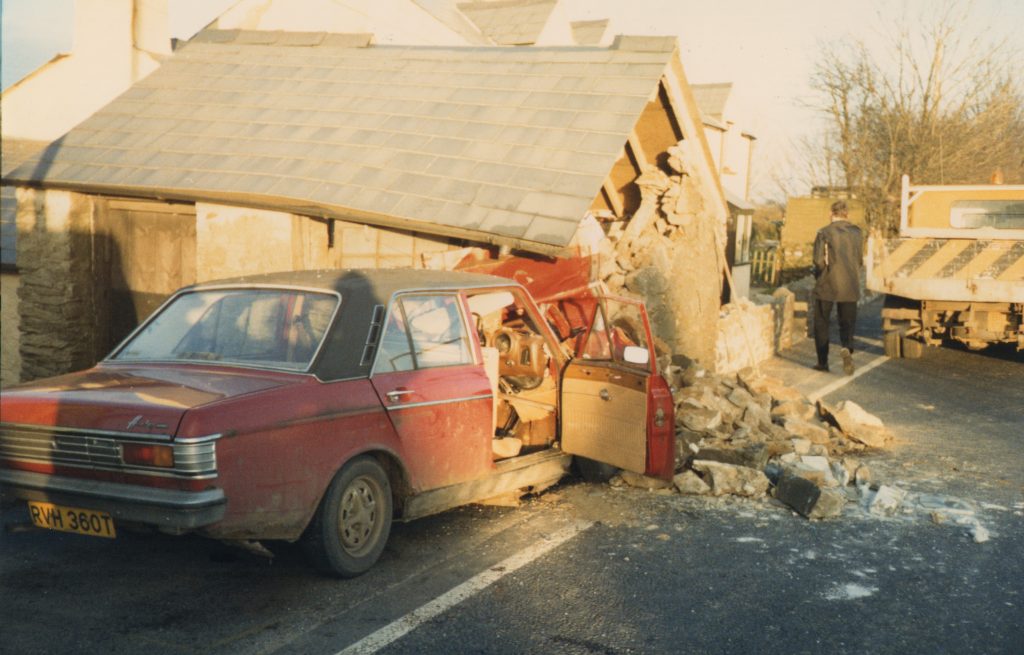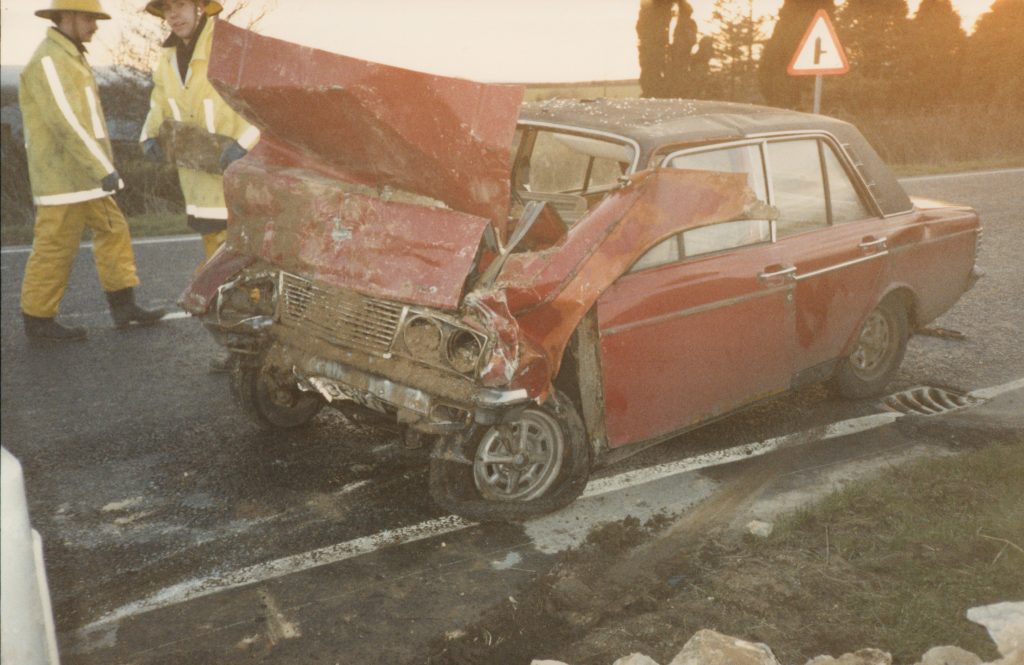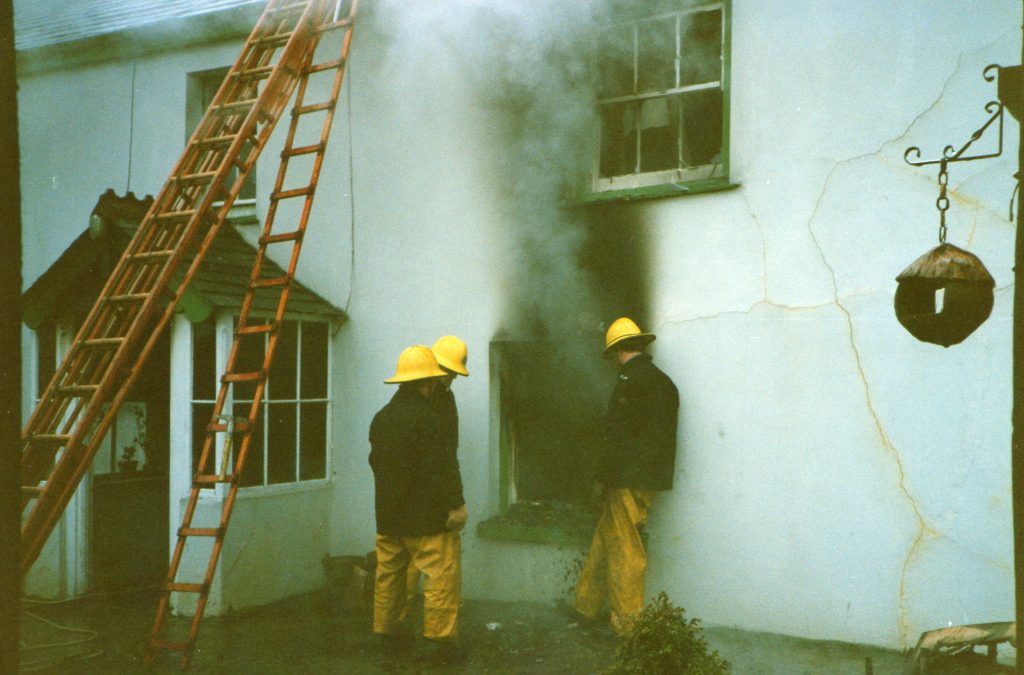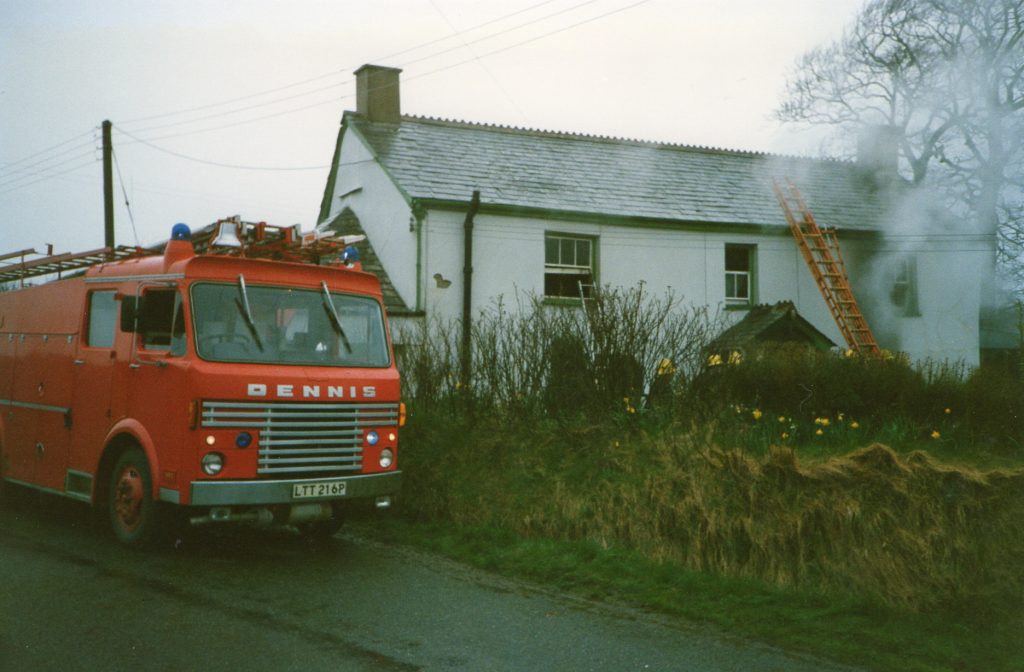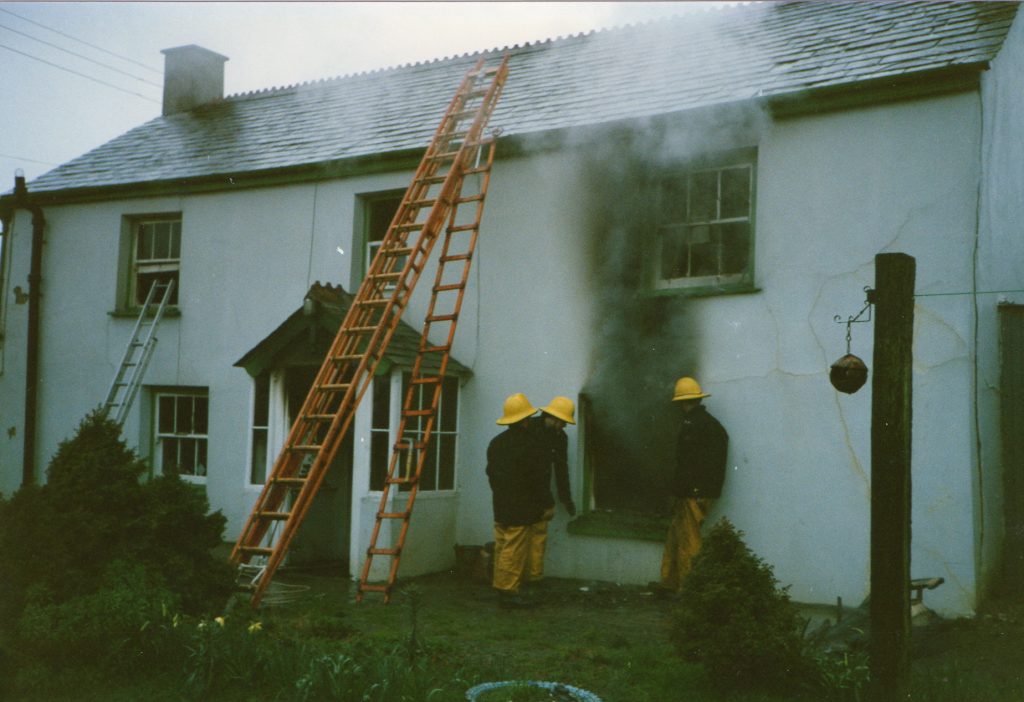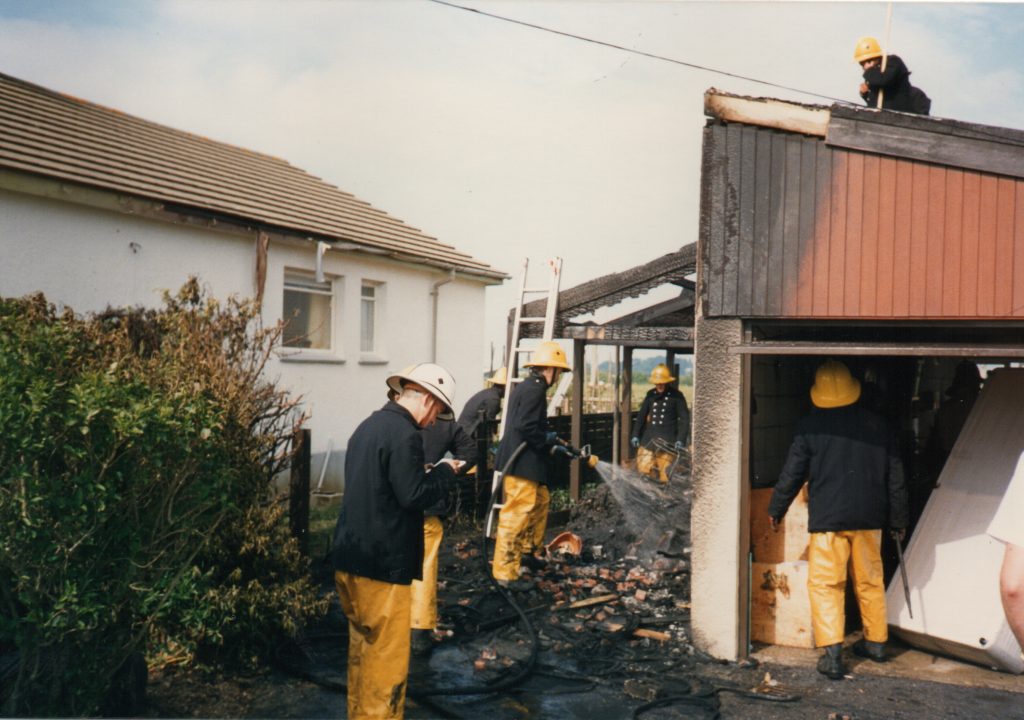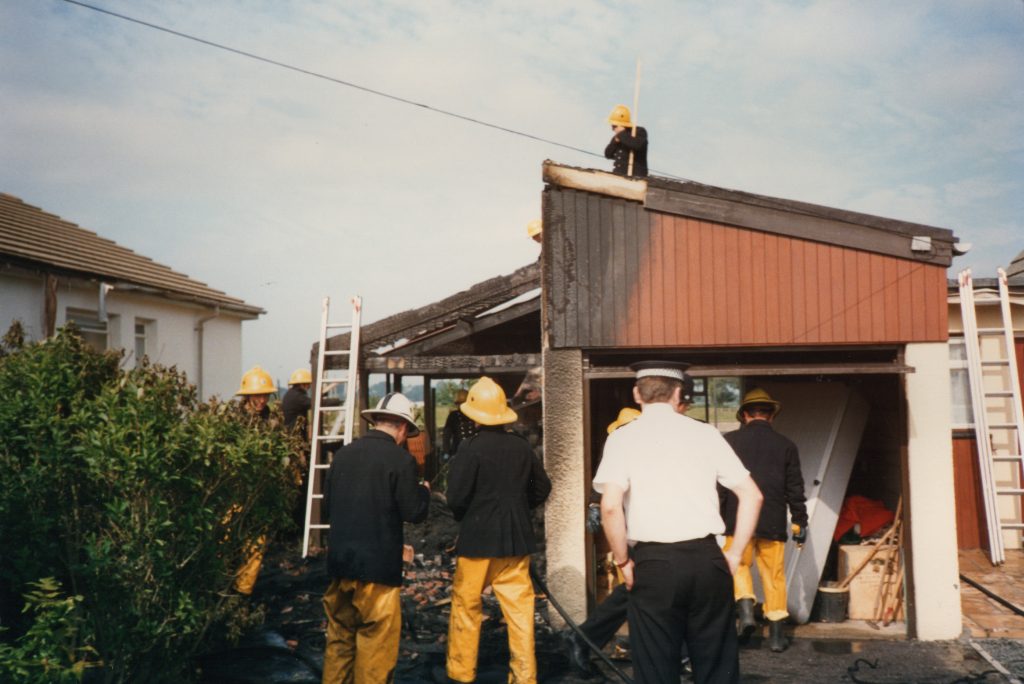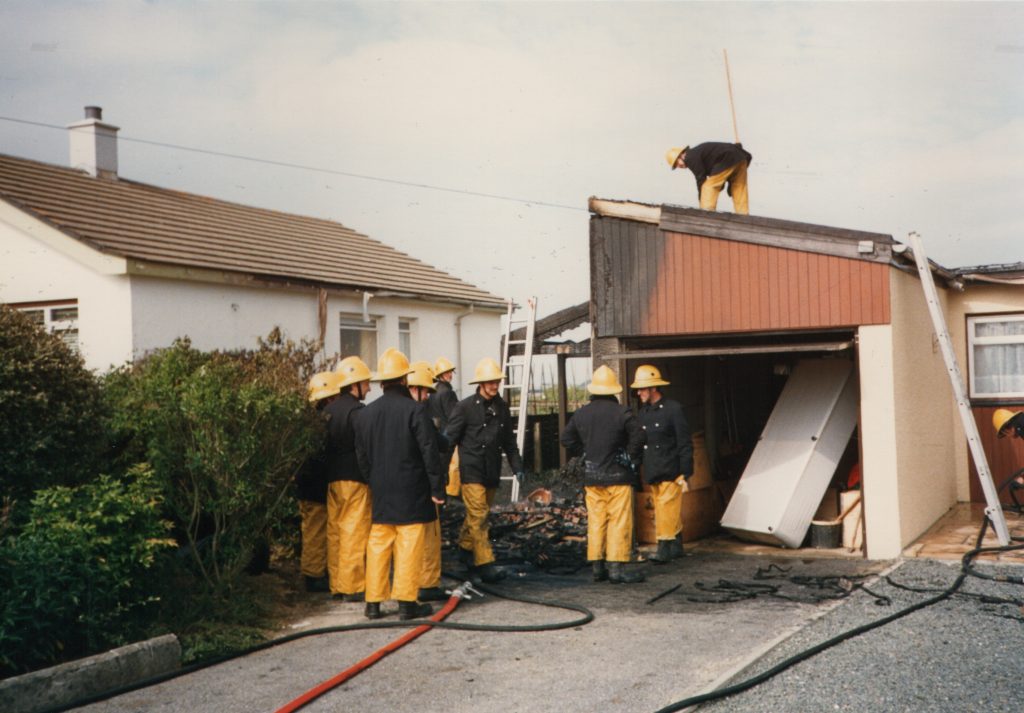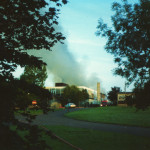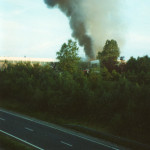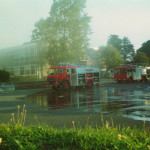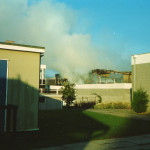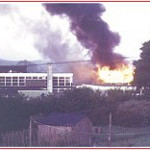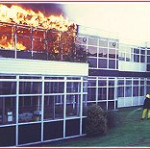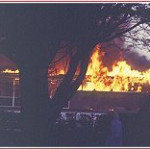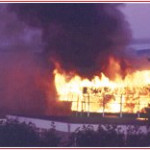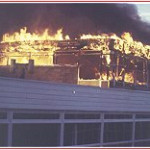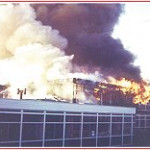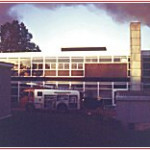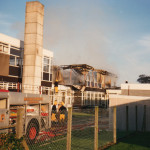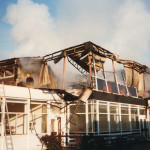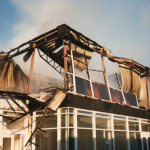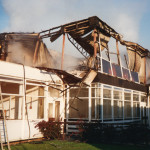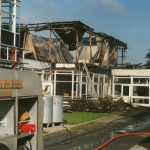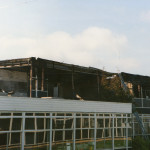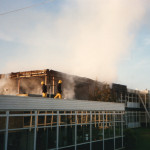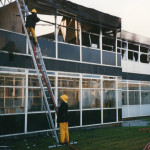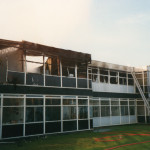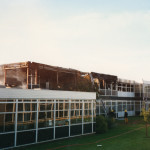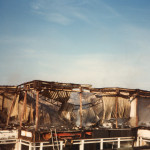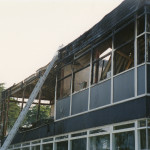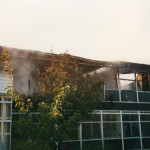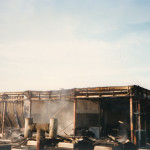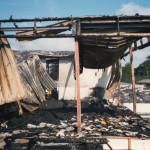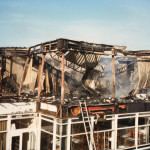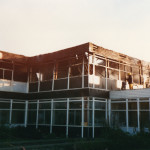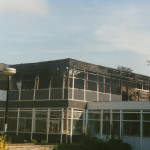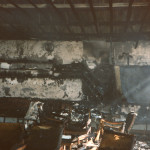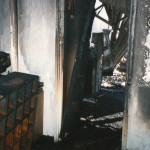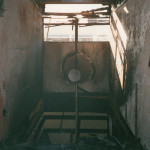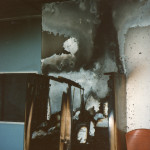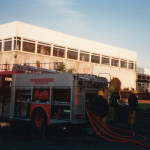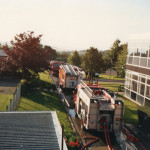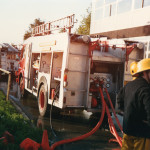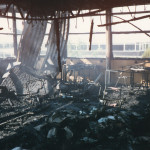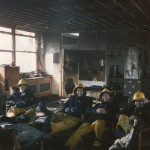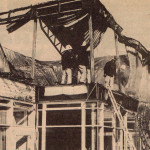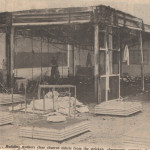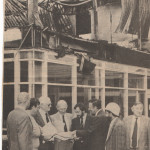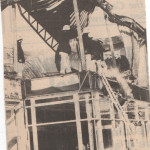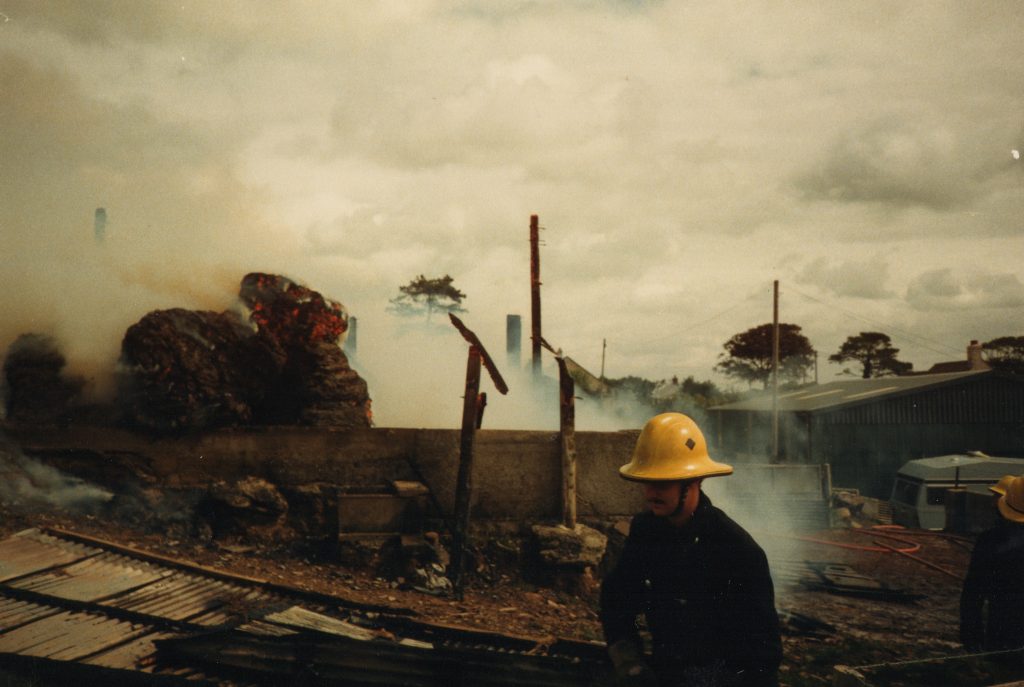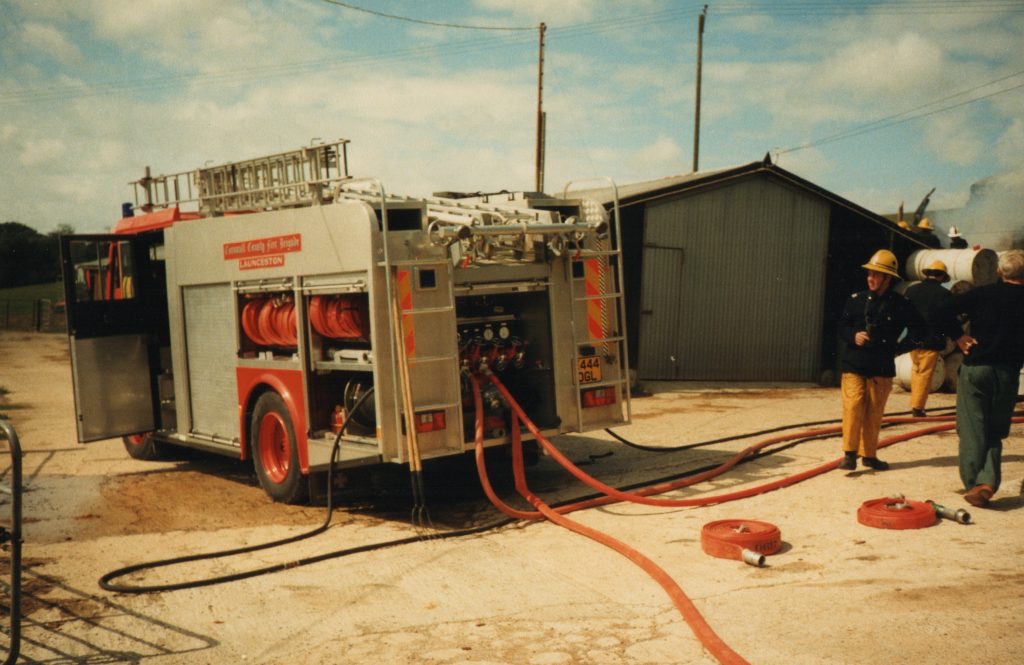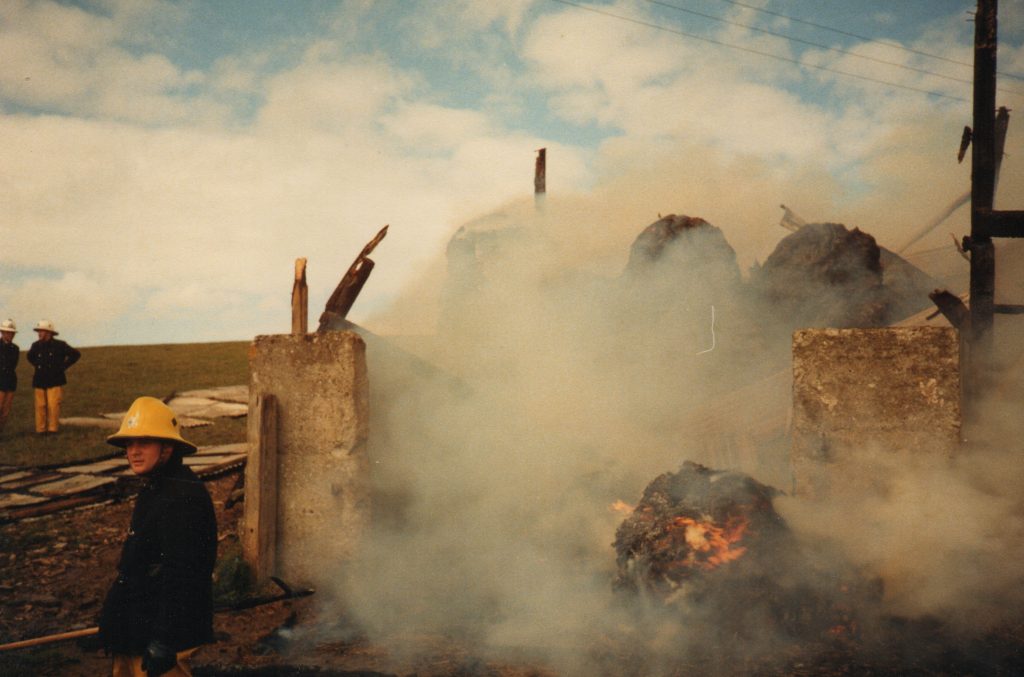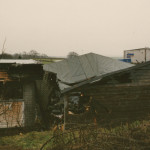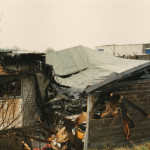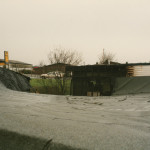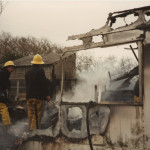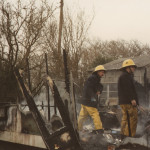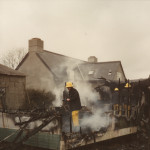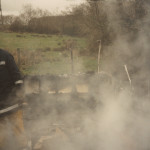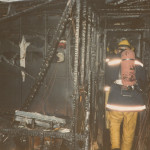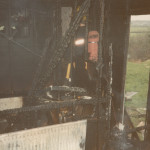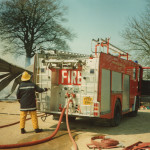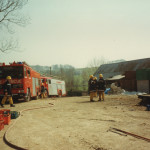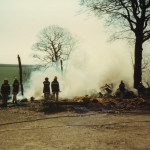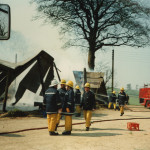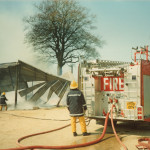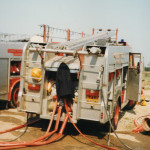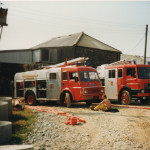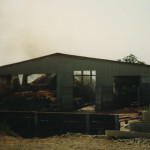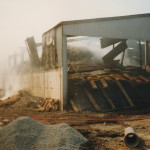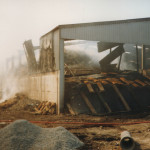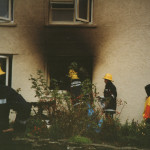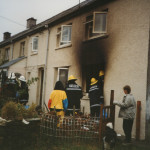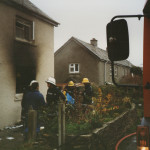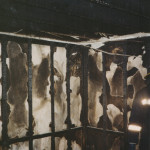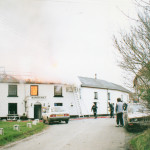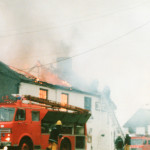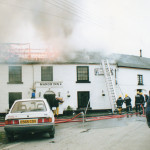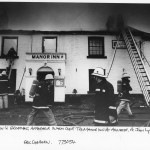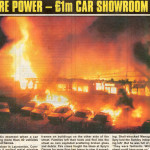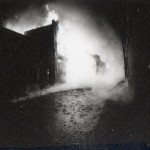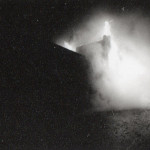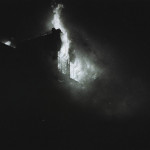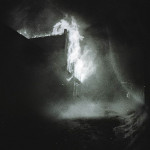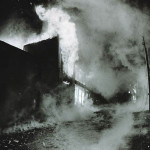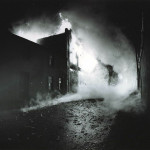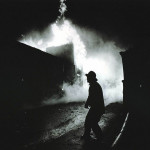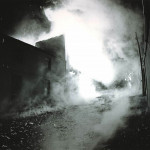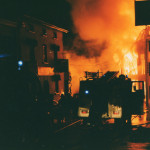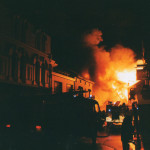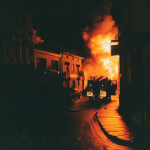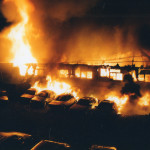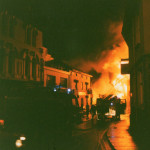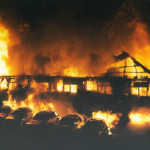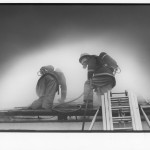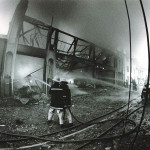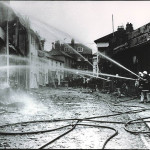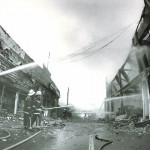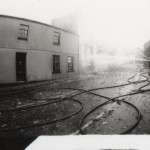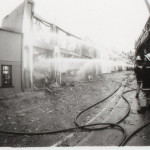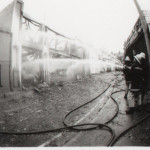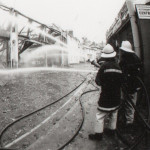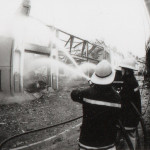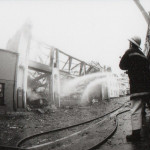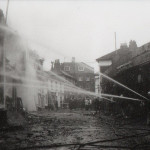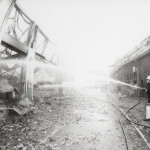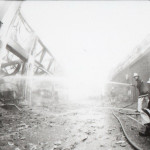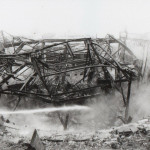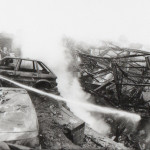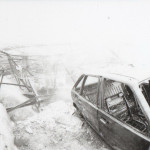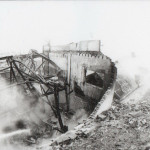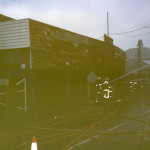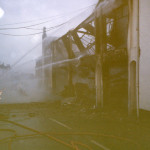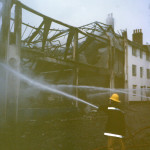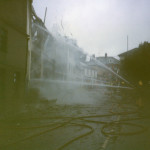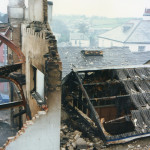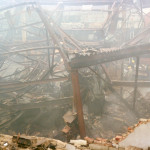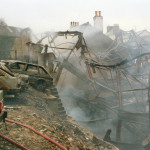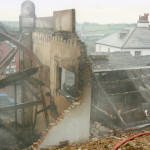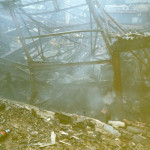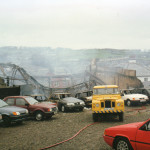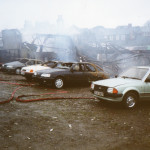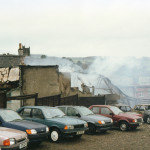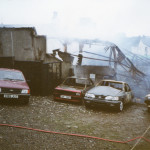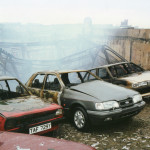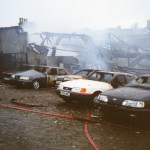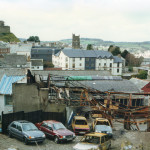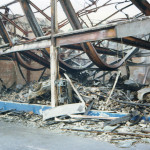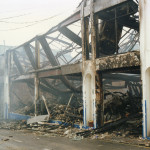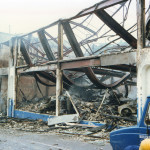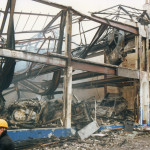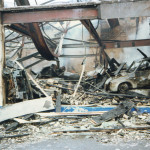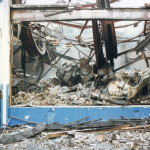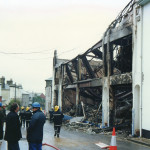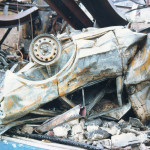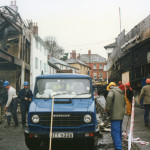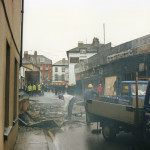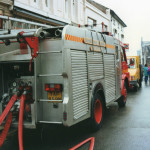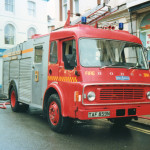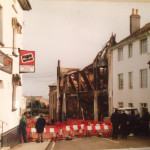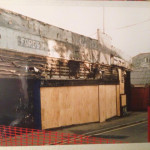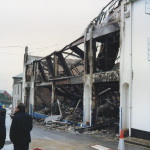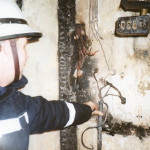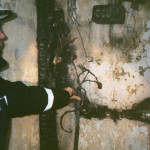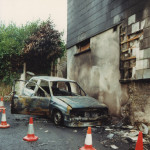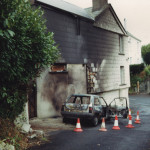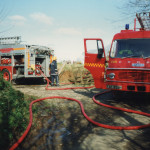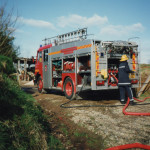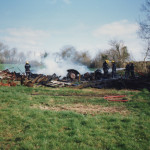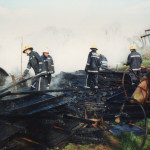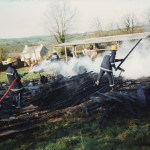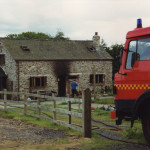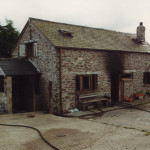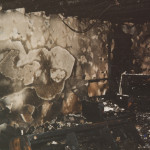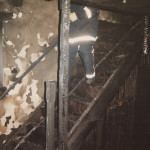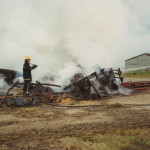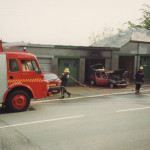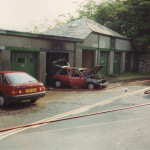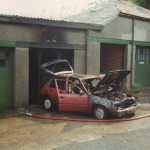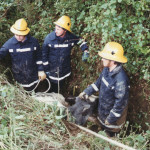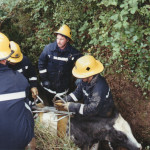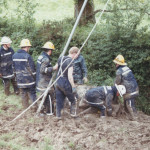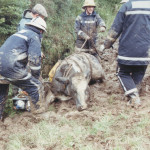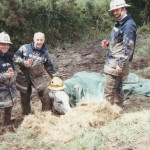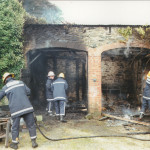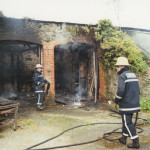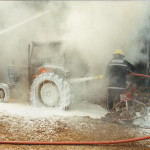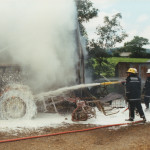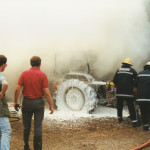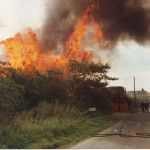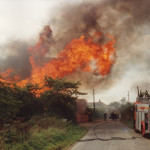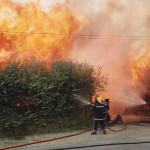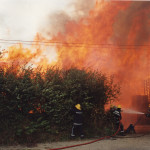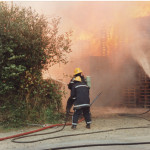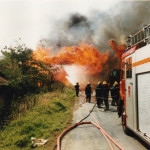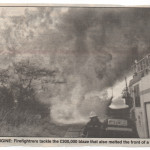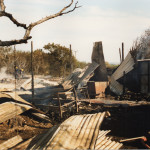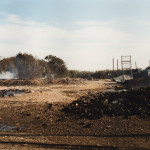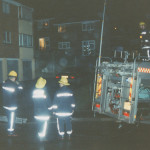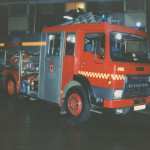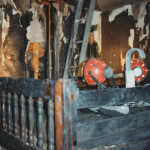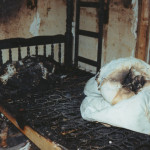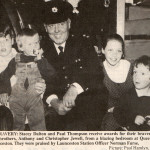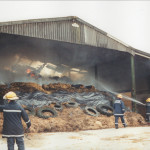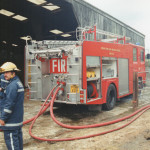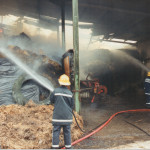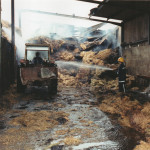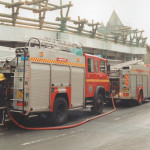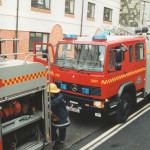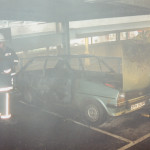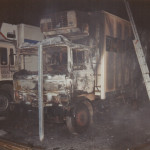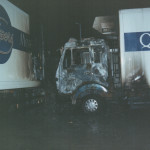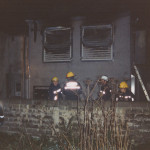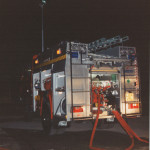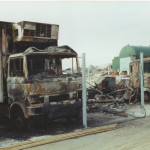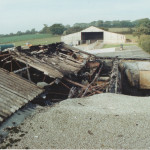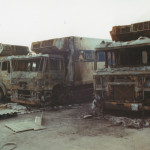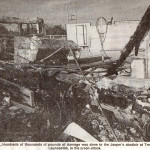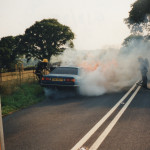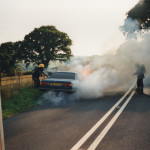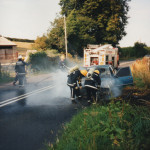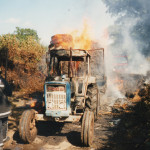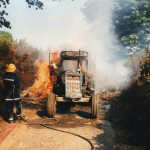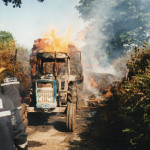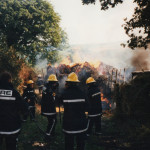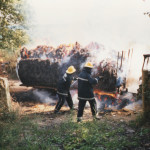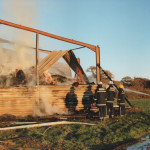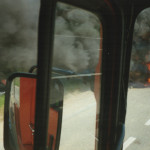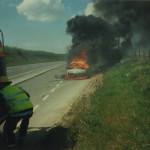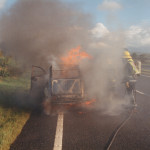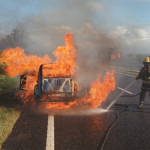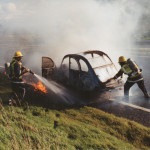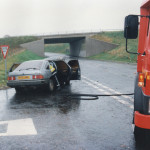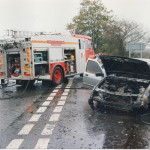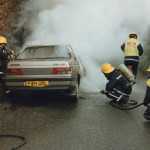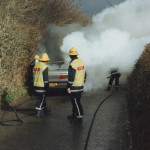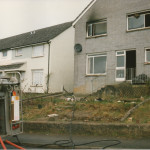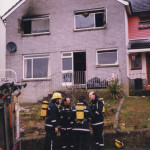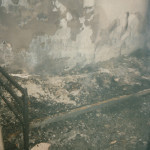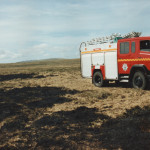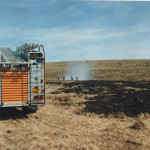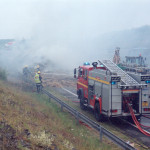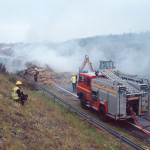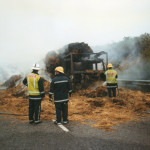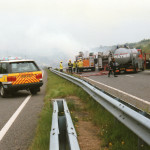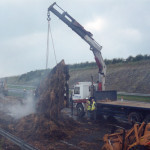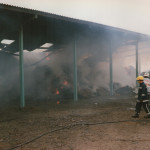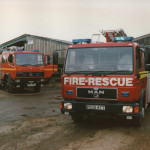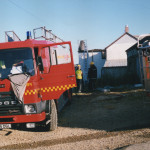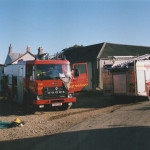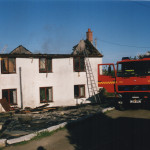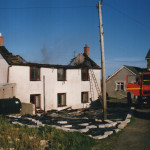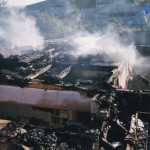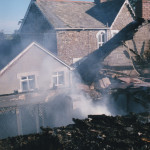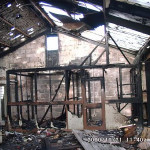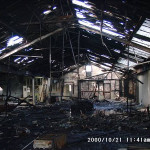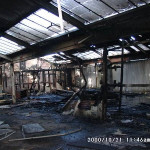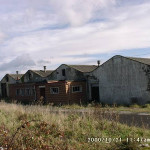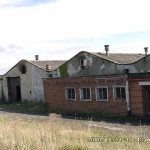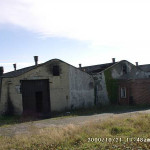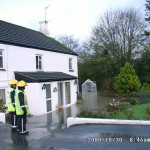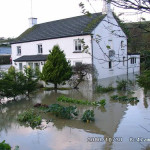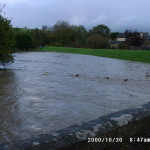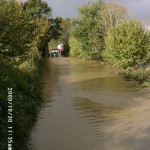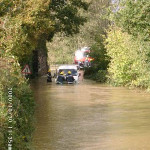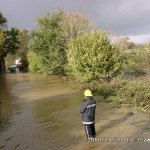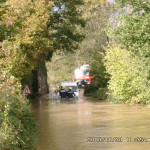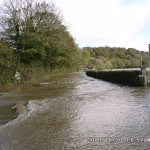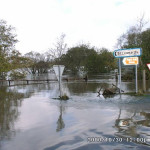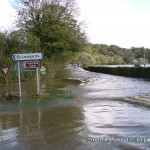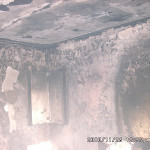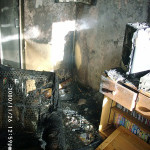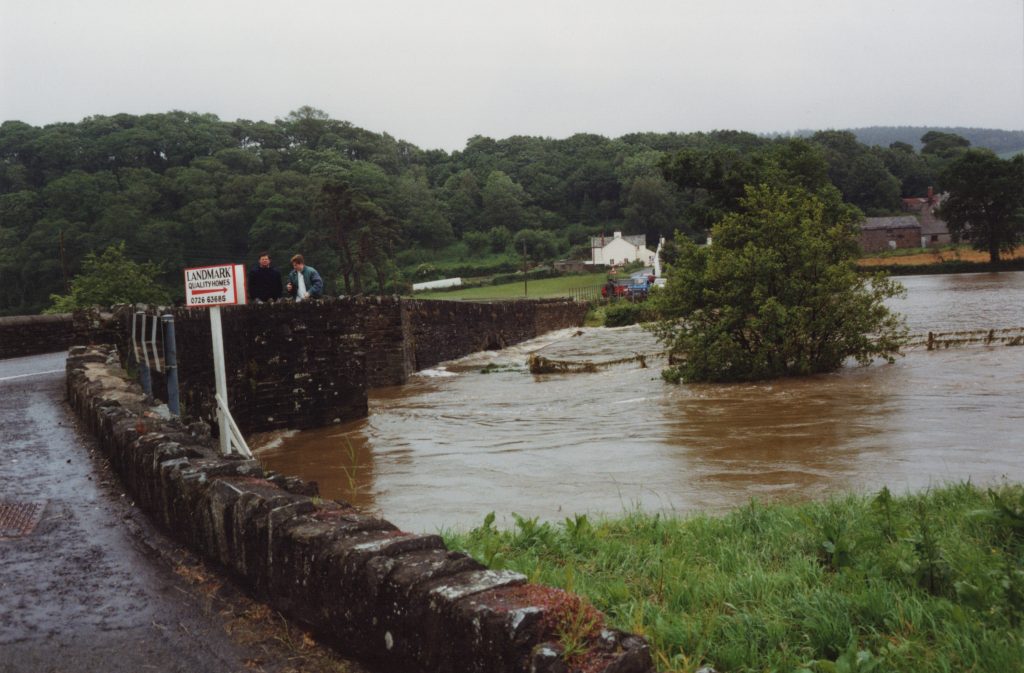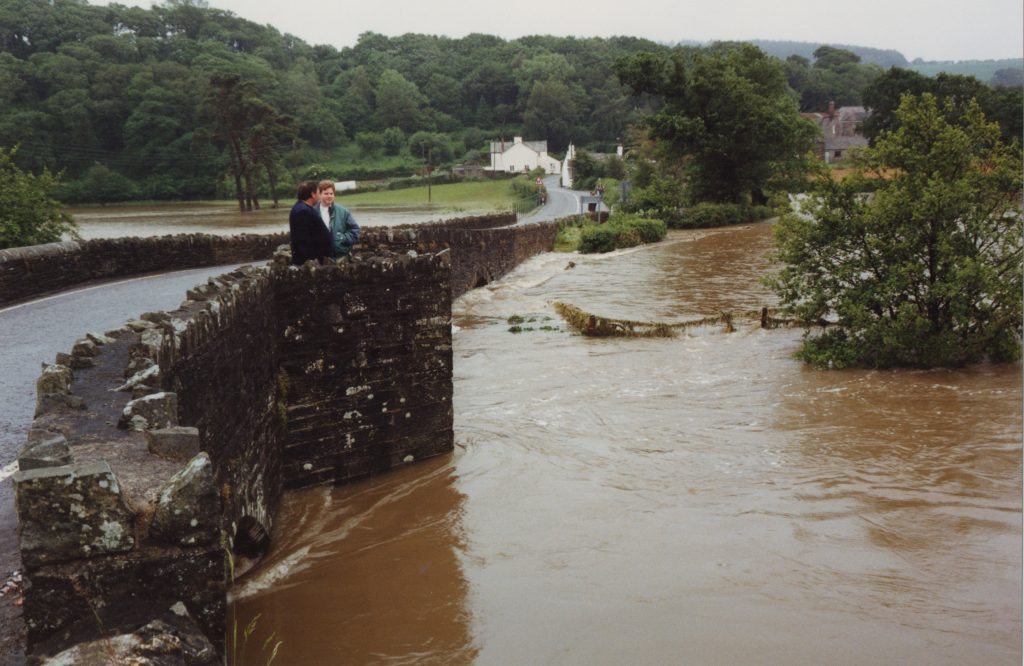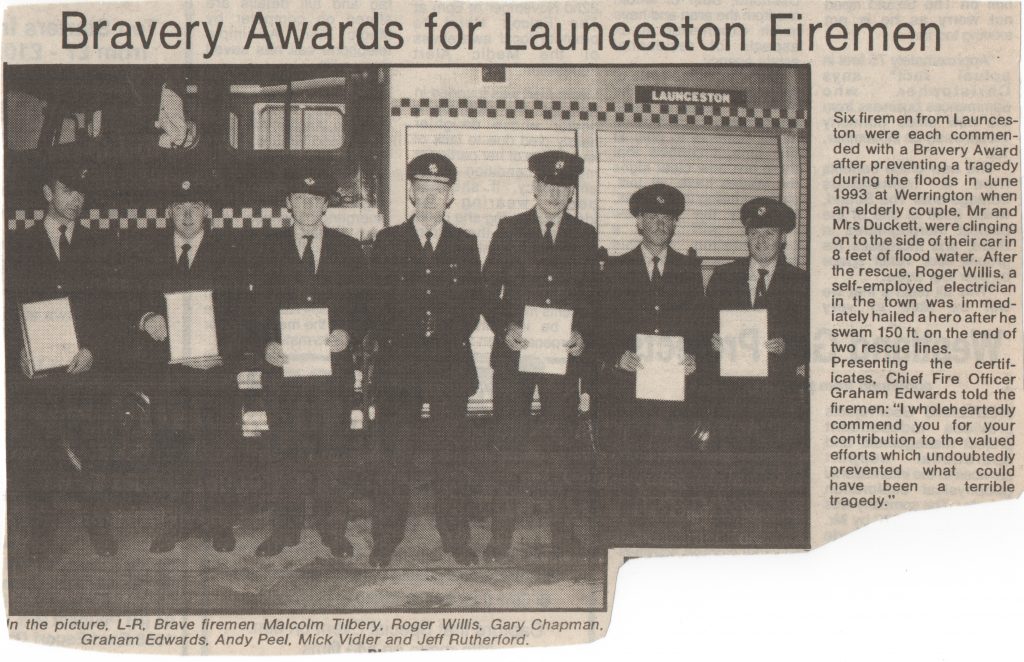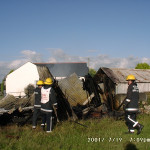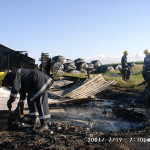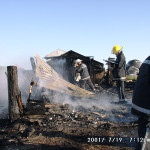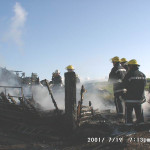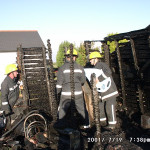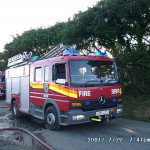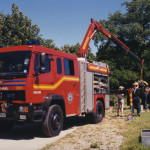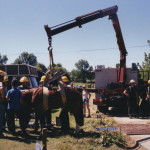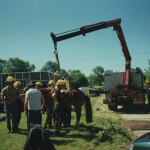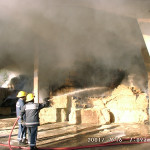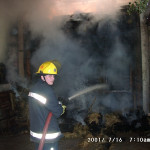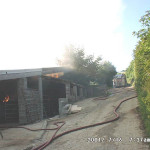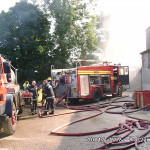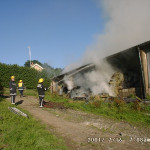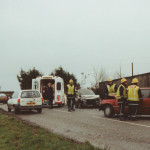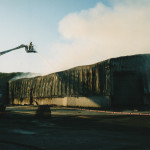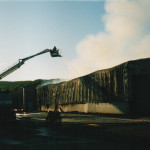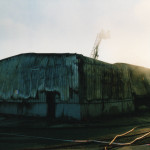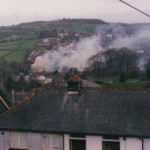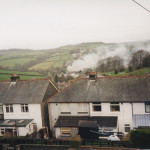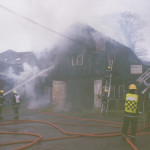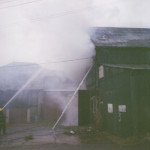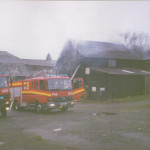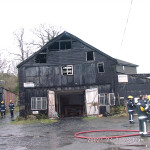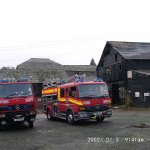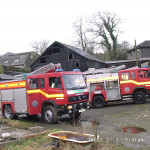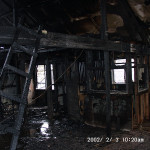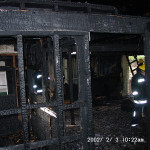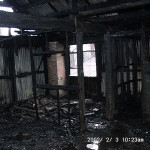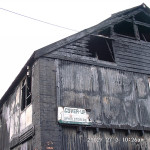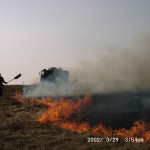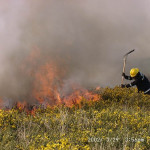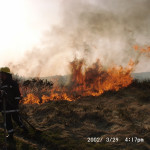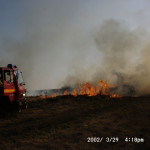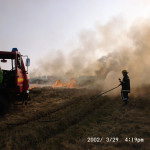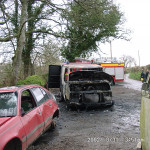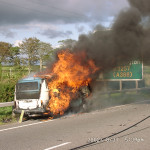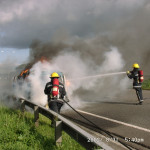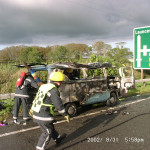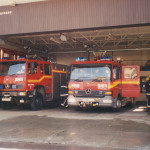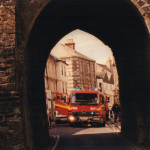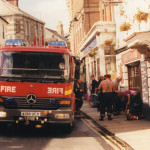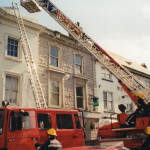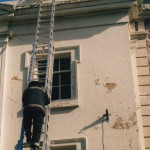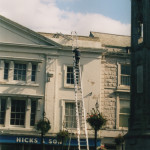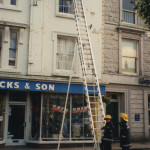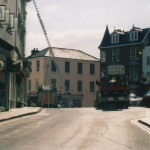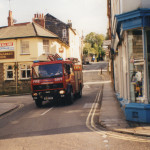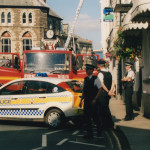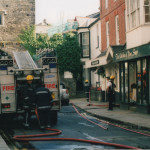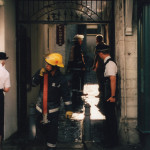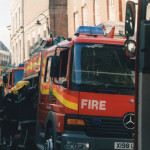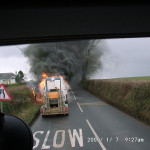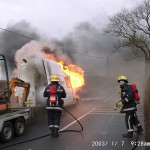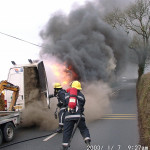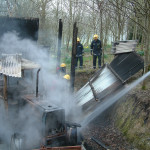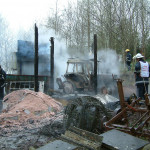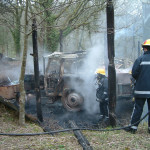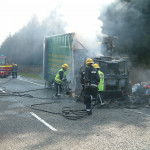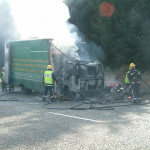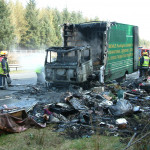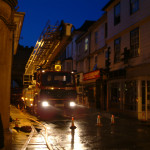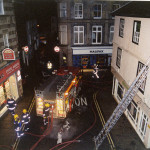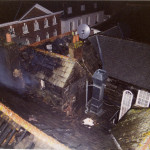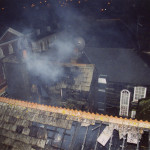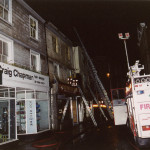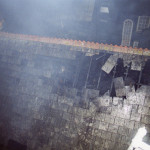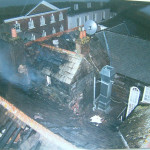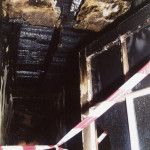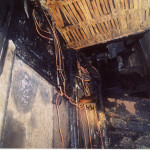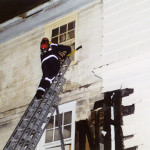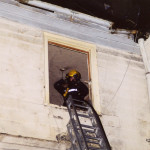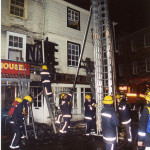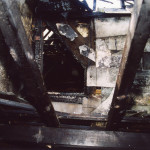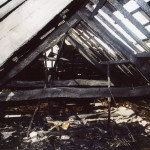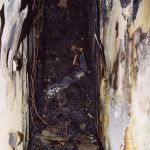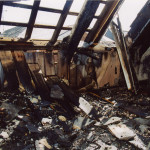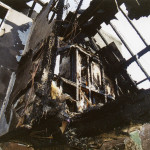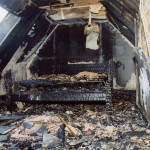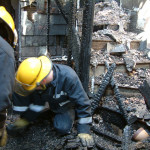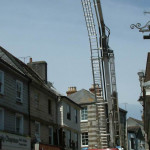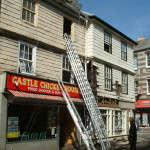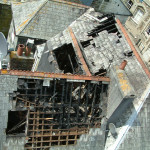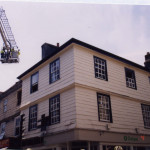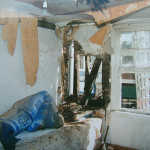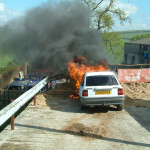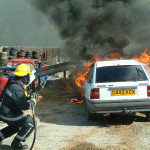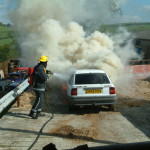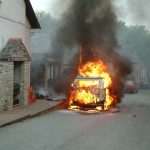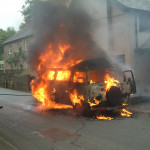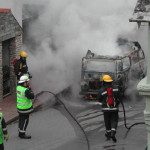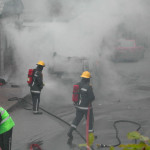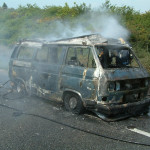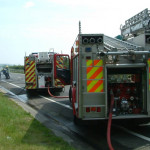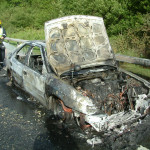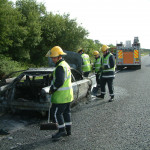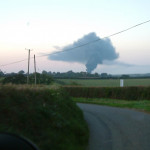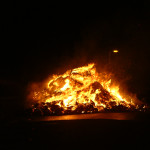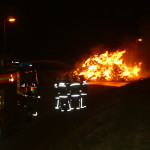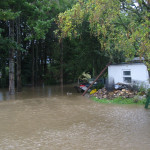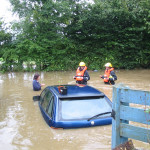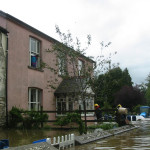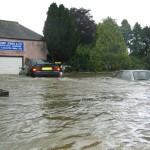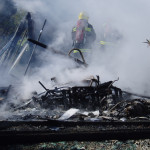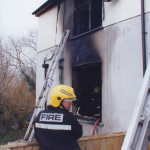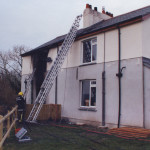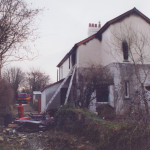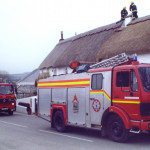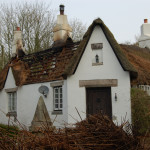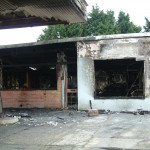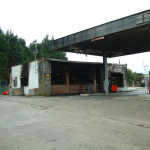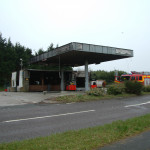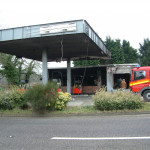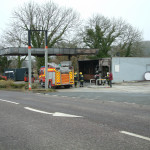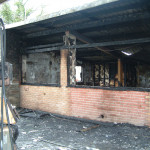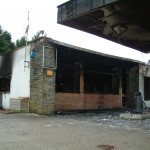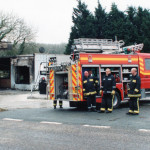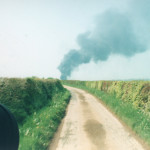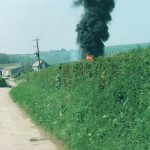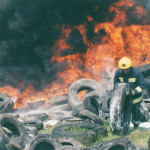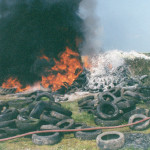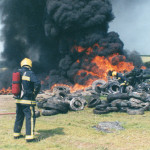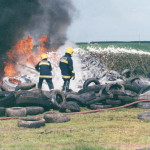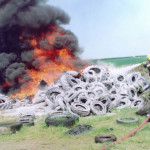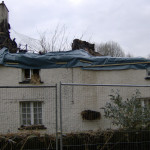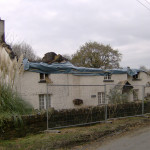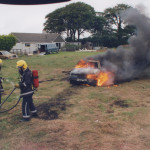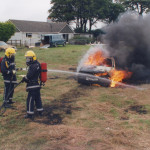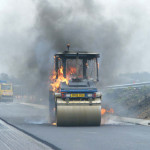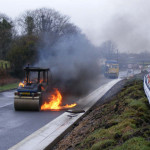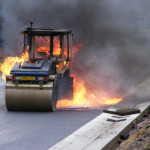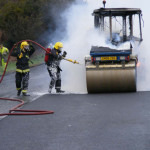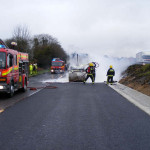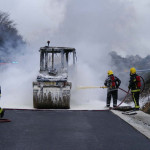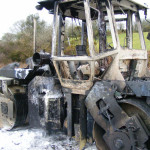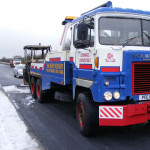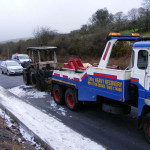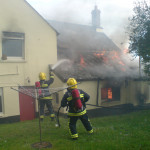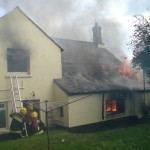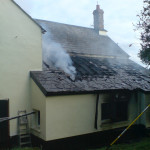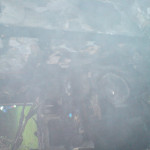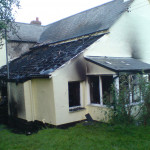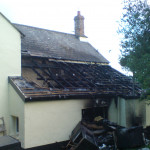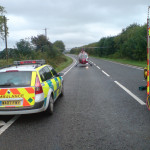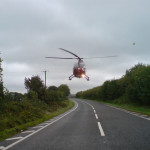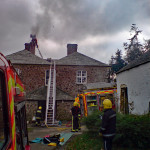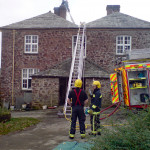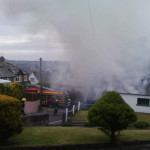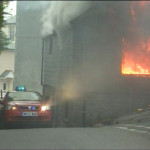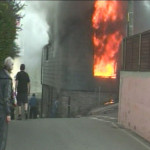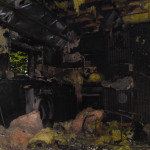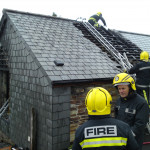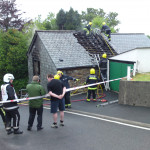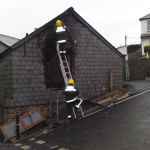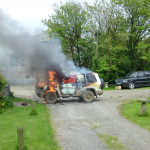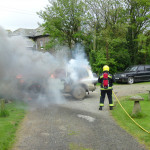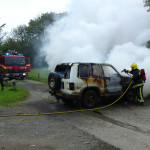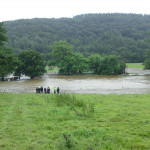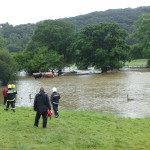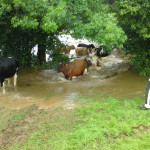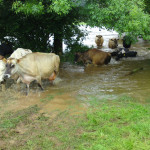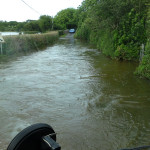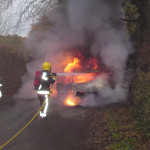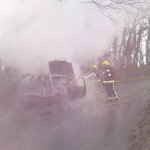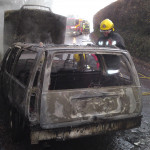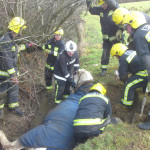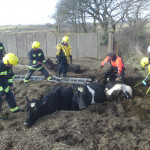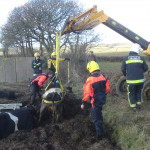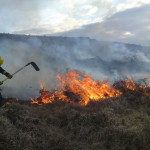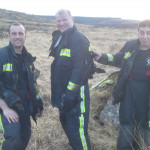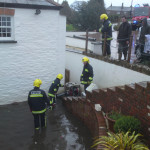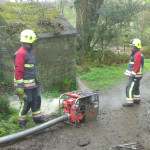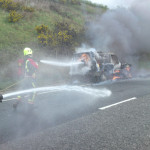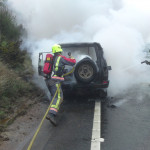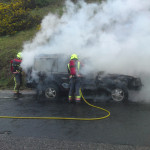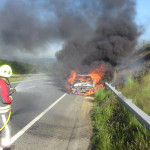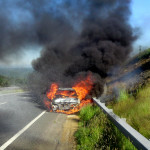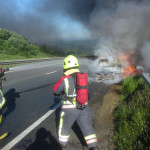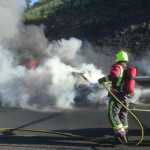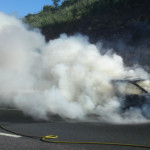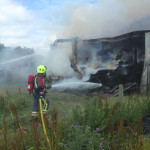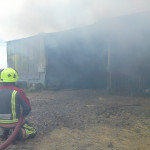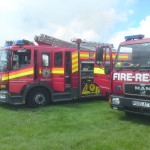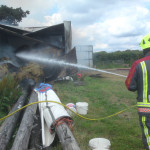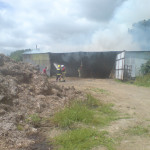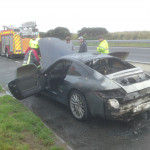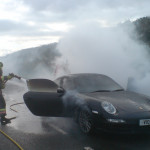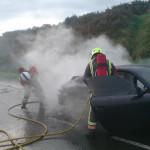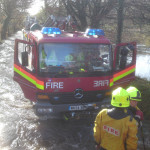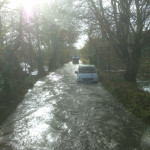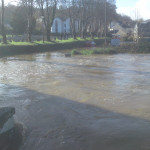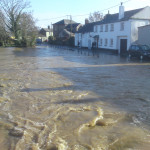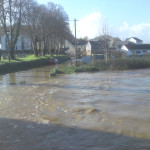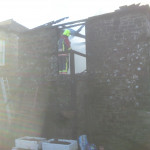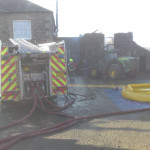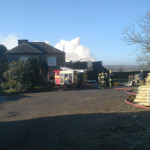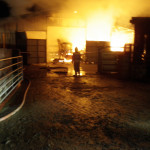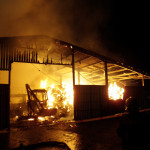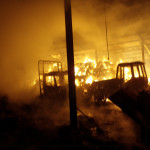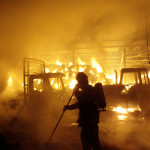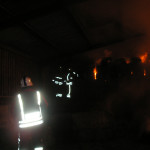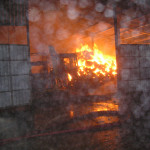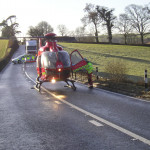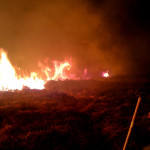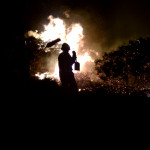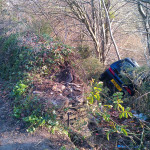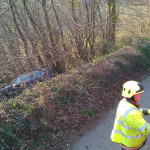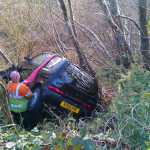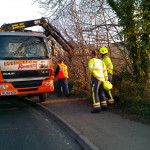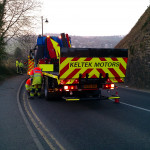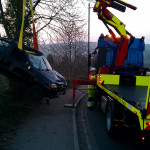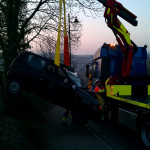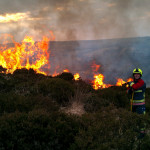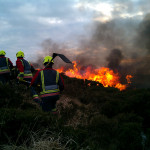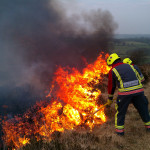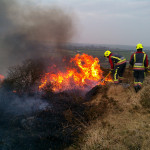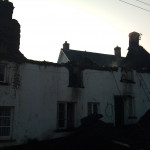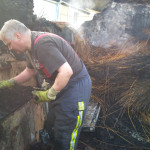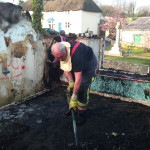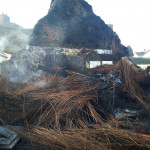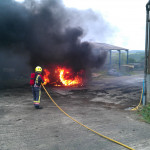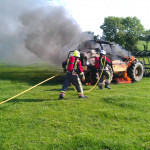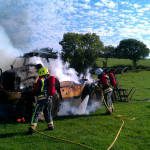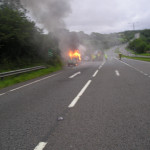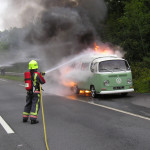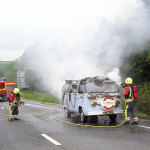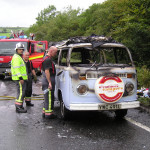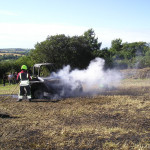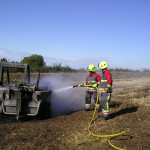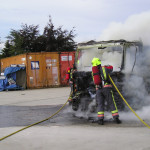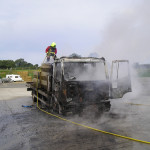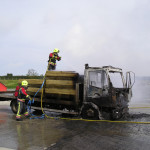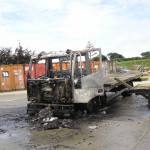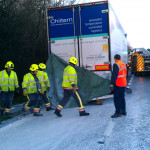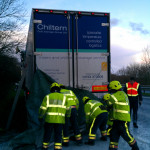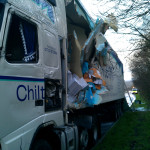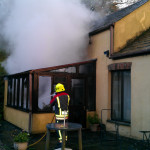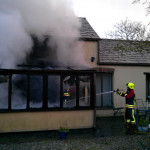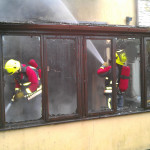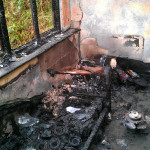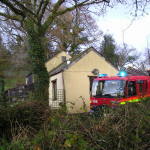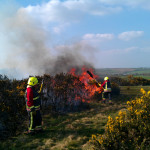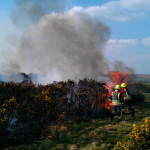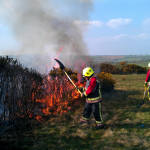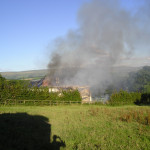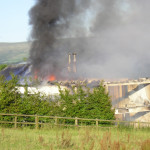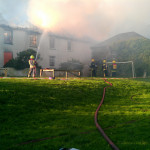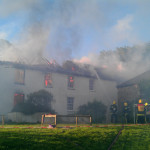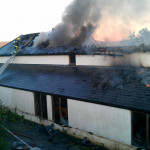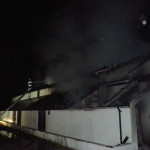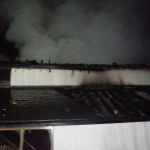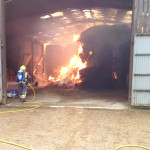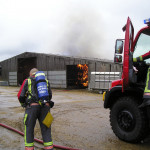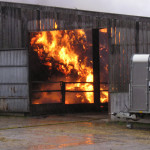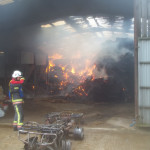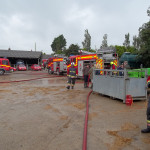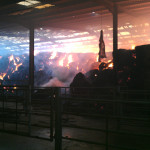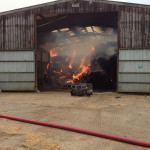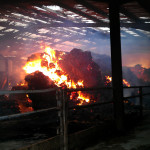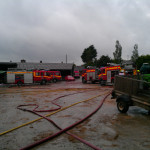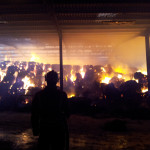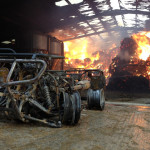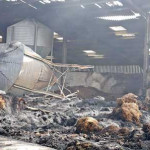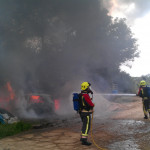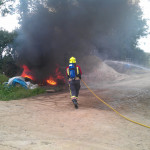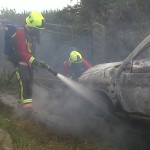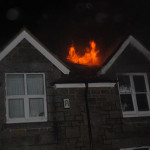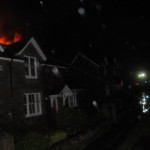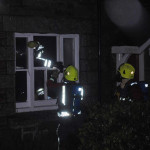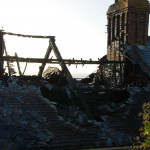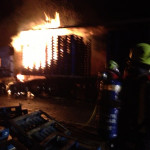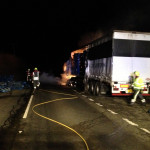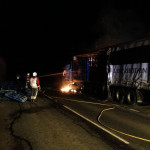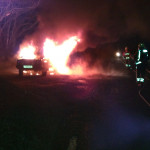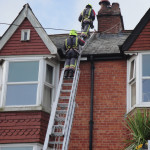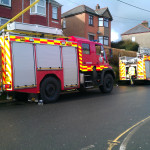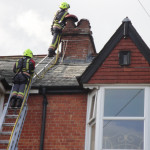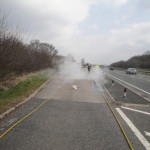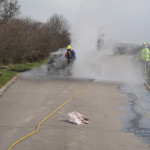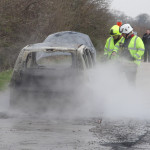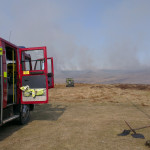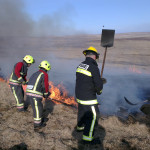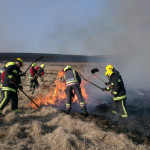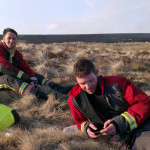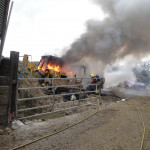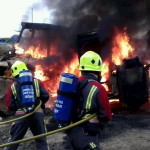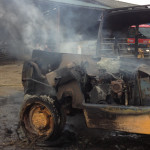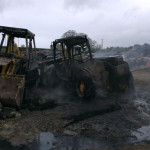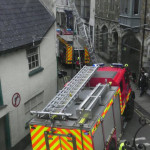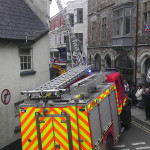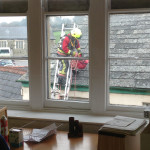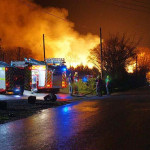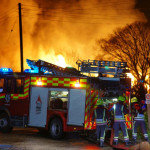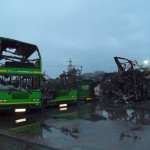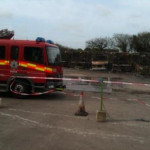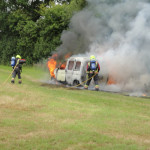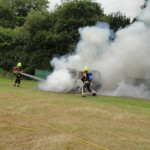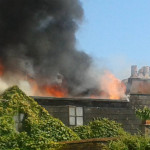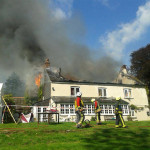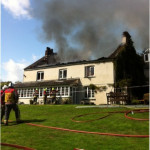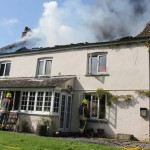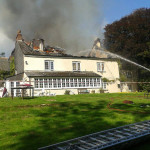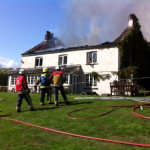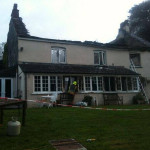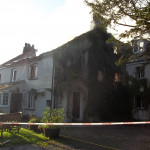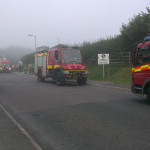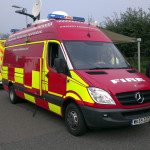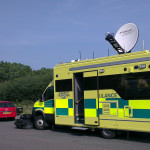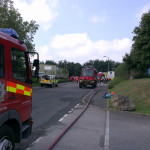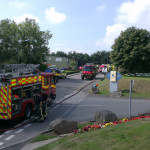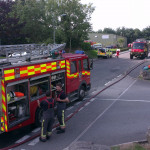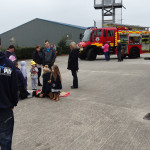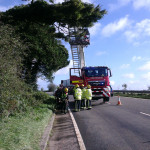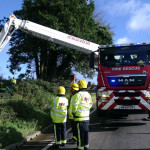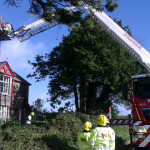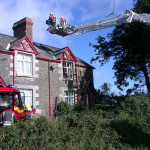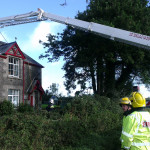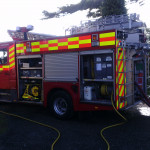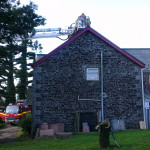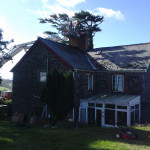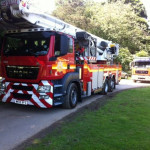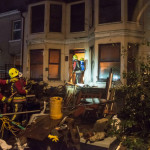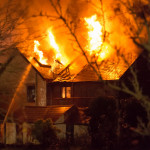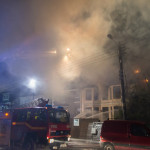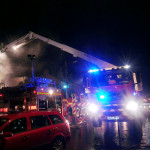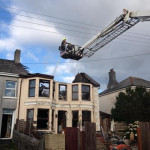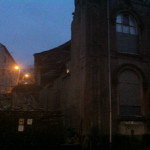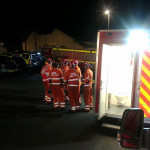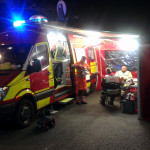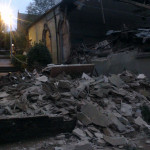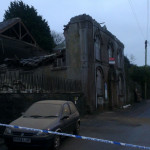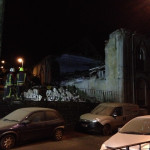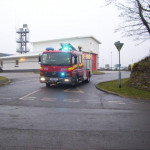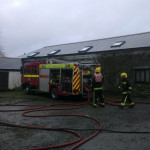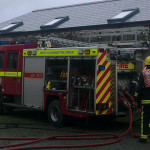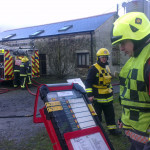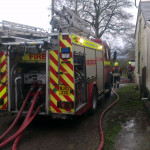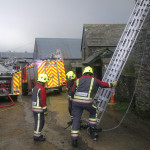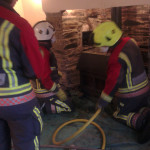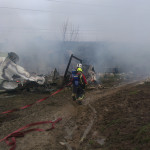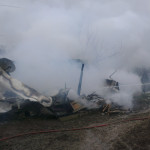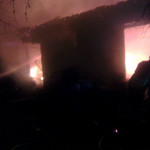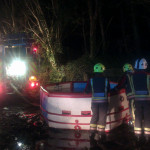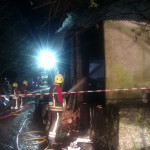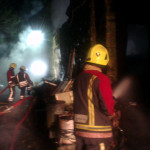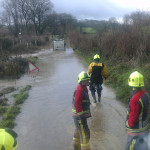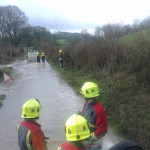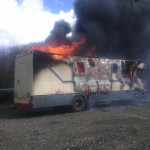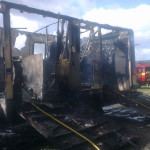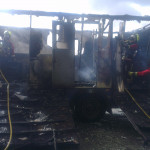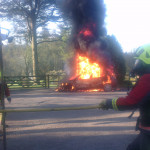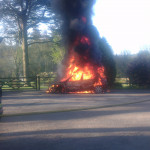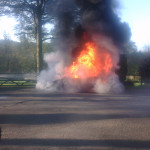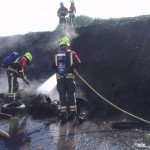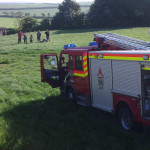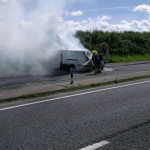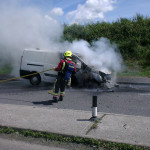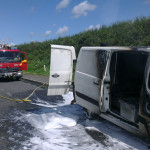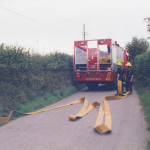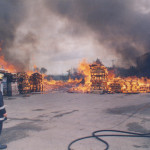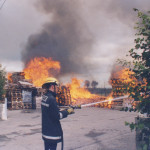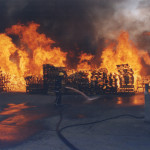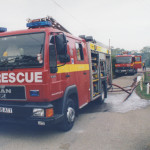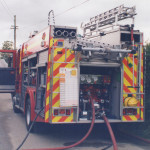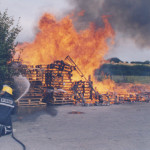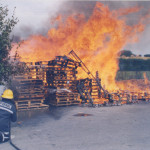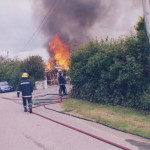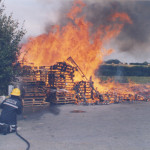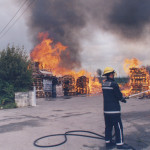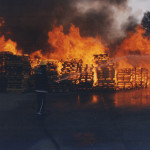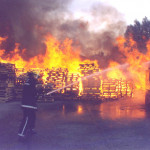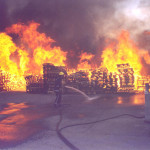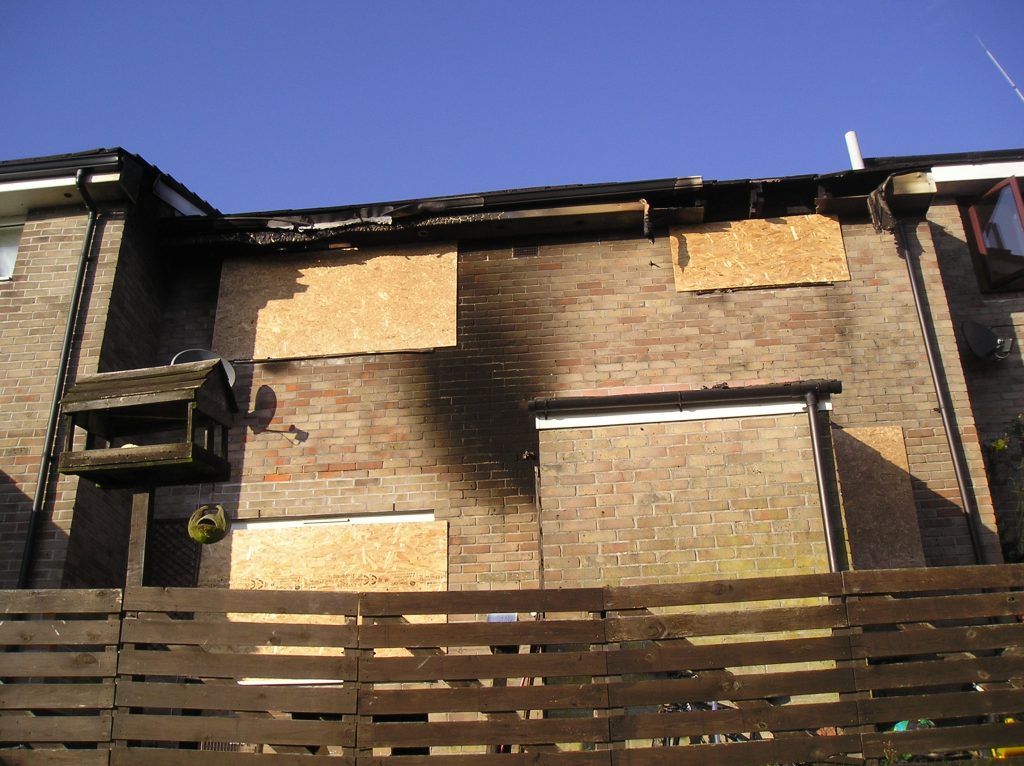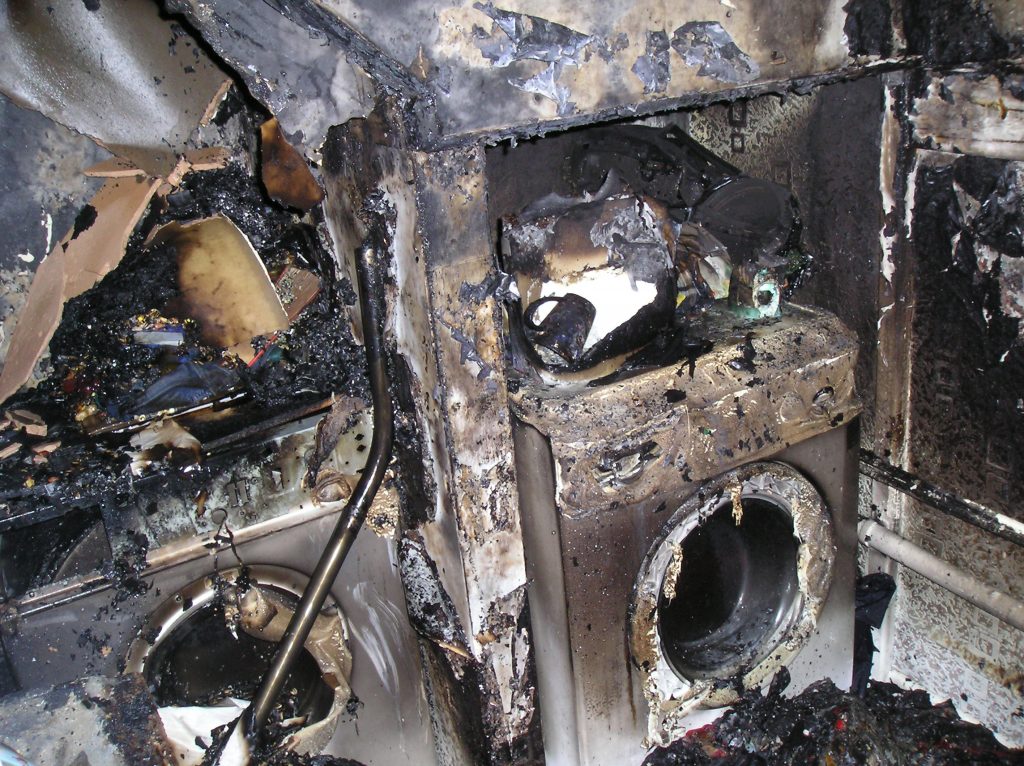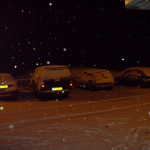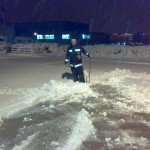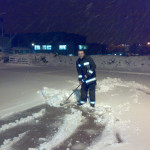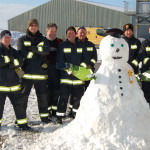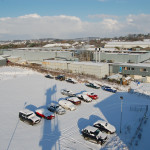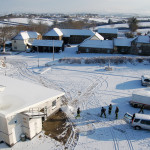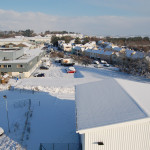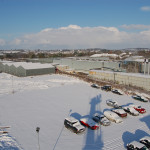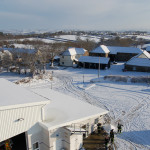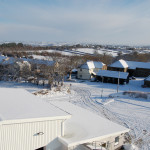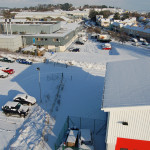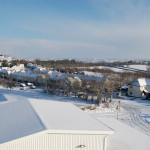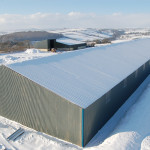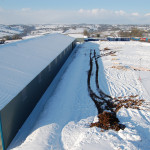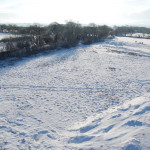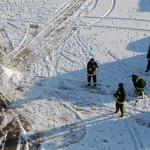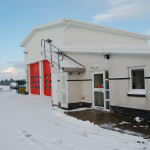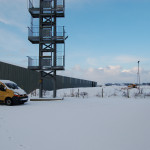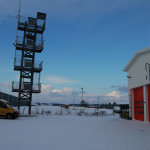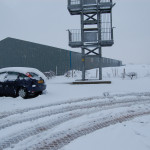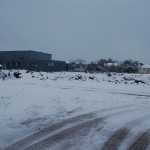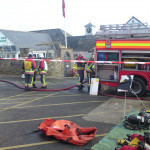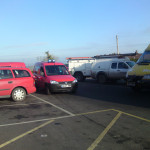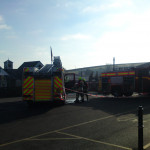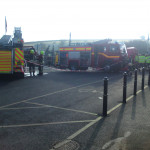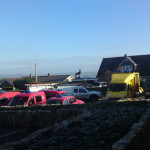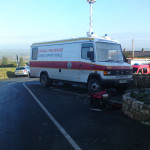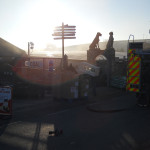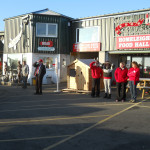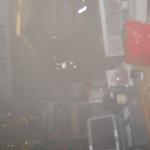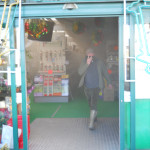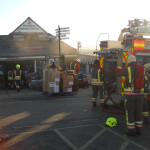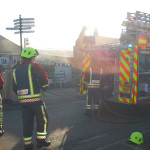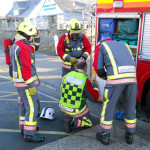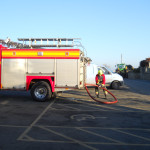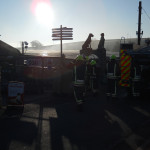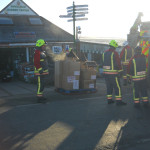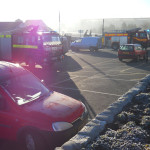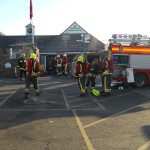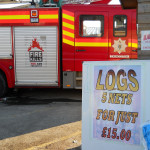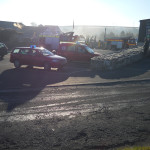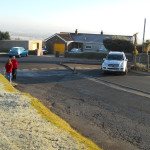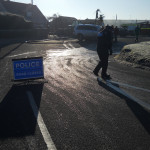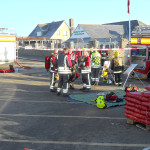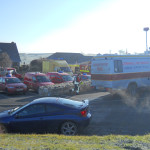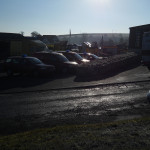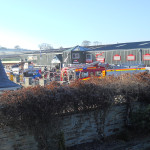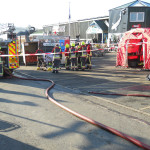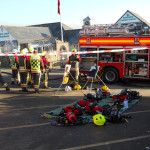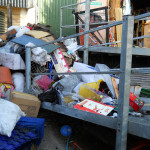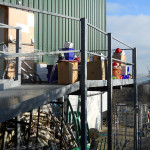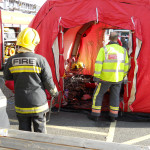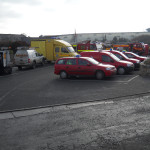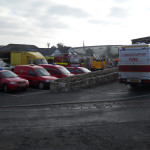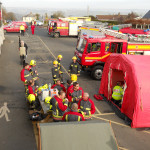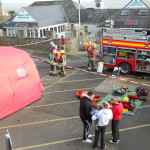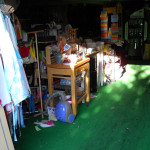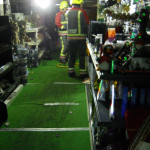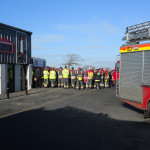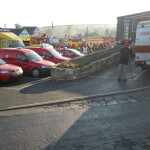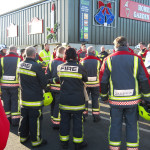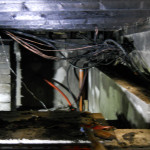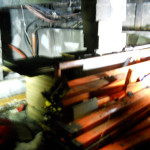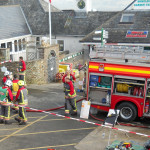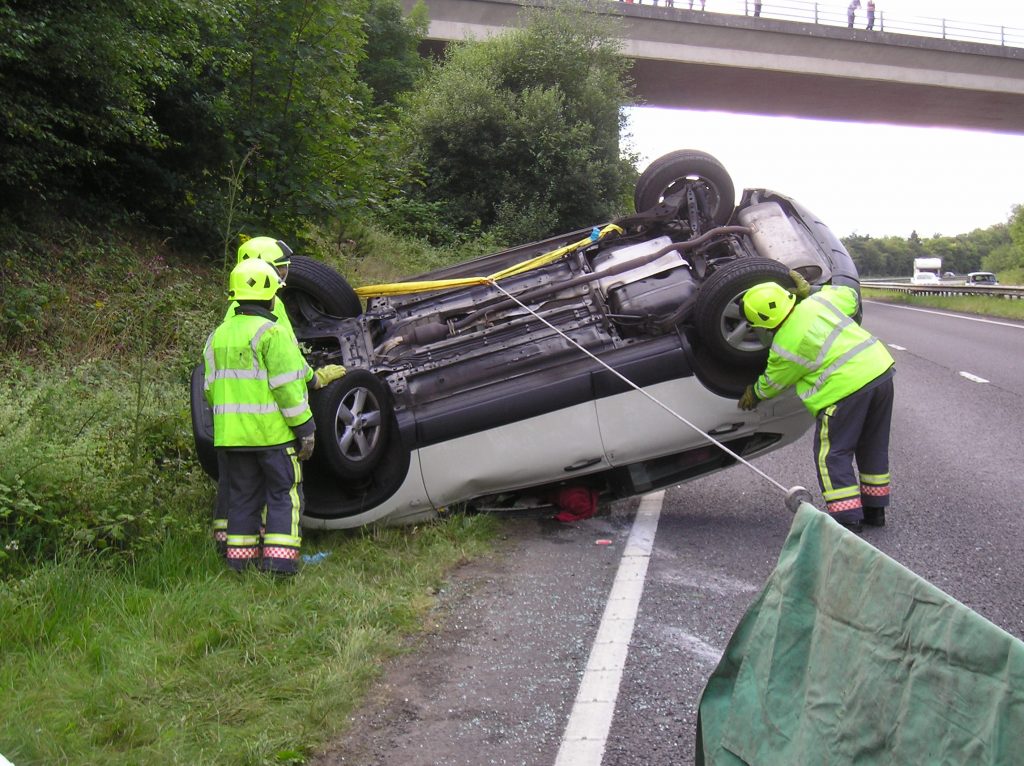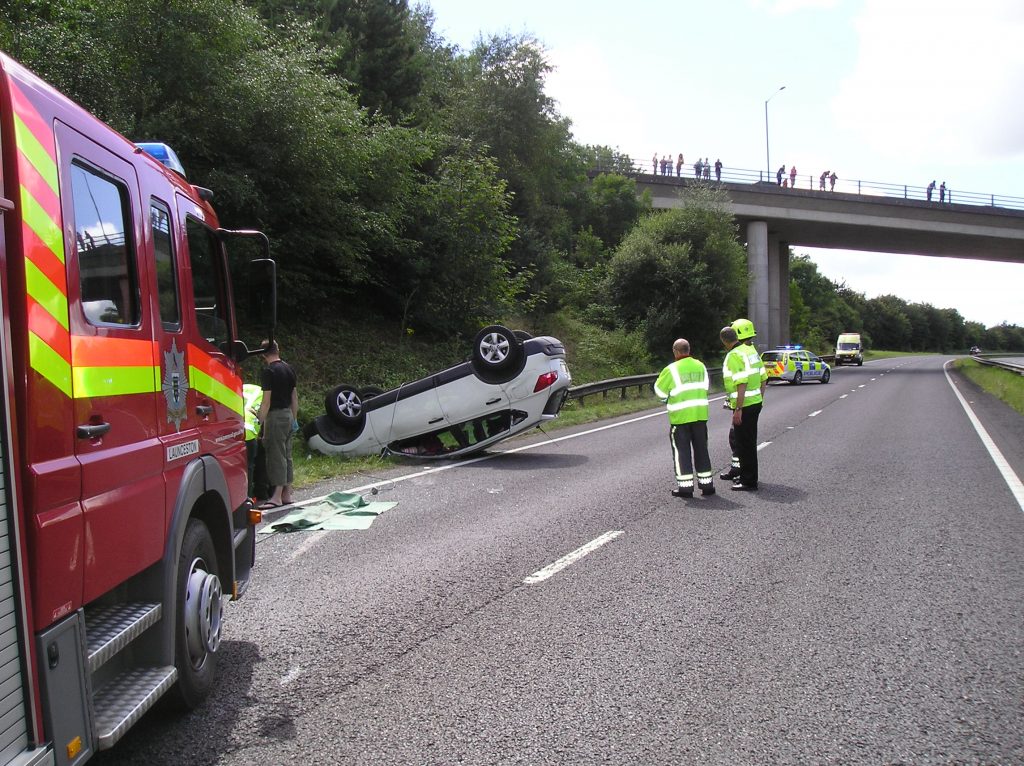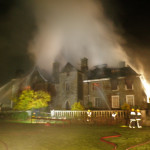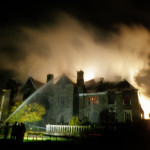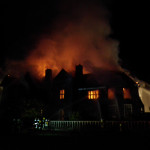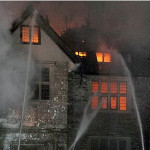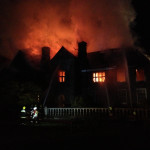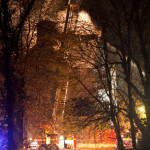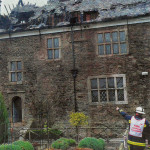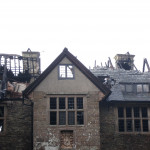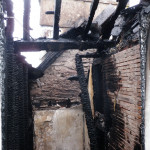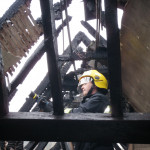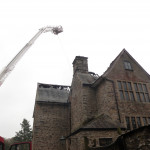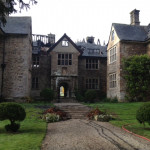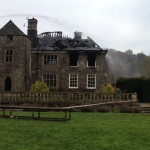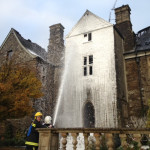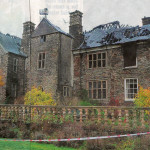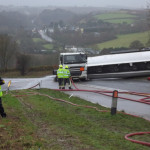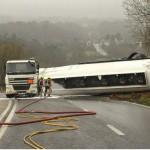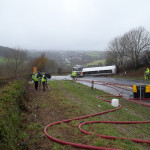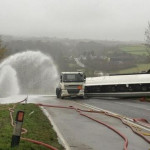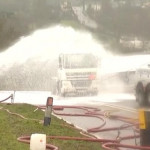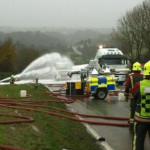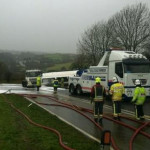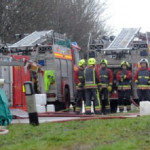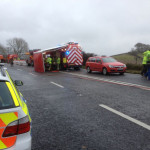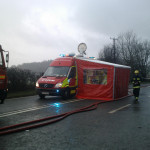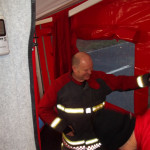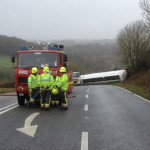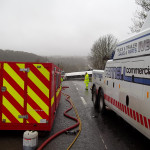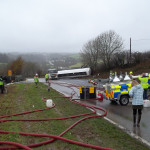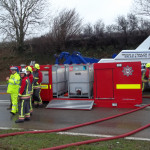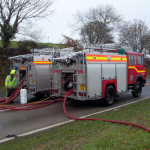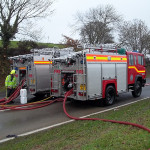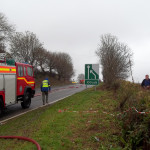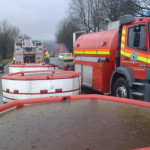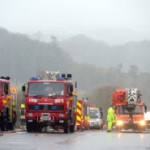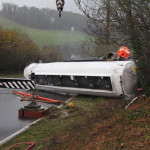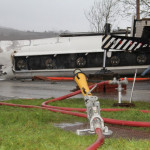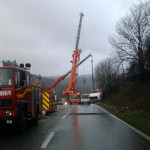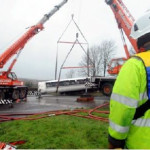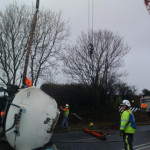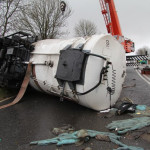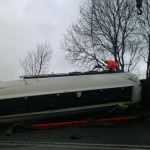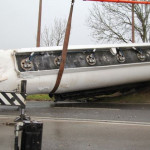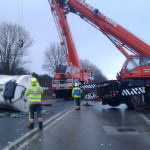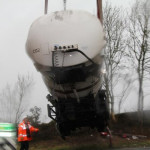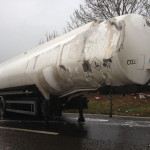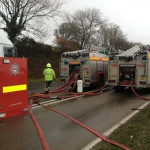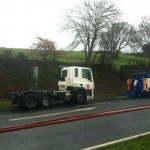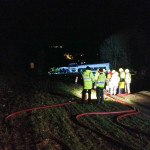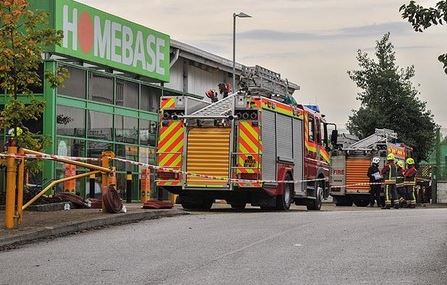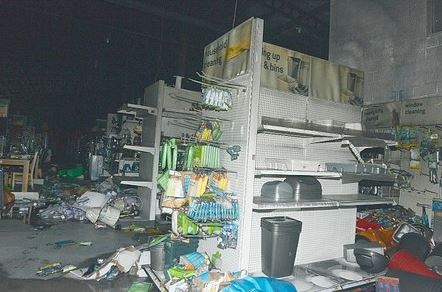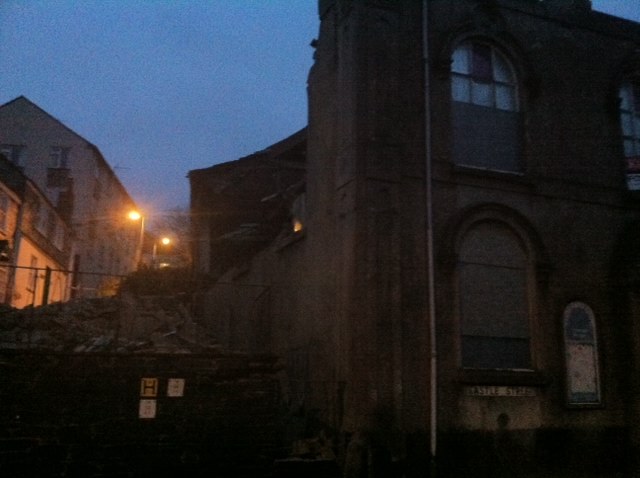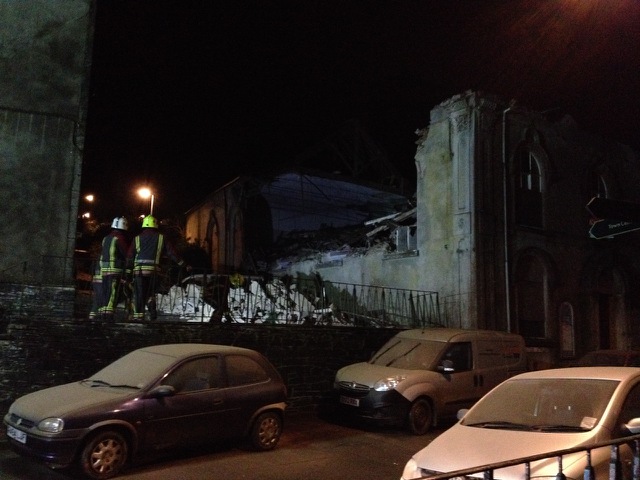.
These are some of the headline fires that have occurred in the Launceston area over the past 150 years , with most being attended by the Launceston Fire Brigade in its various guises. The latter incidents do contain footage and images that can be distressing, but no material has been knowingly published that contains deaths unless previously mentioned. Much of the later images have been kindly provided by Launceston’s former Station Officer, Gary Chapman.
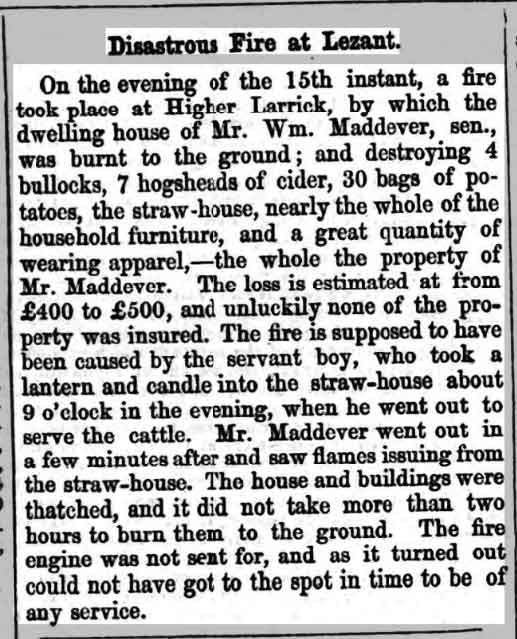
June 26th, 1858: TREGADA: FIRE:- On Thursday last, about noon, a fire took place on the premises of Mr Thomas Simmons, farmer, Tregada, which speedily accomplished the entire destruction of the house and outbuildings. Fortunately a considerable portion of the household furniture was saved. The buildings were roofed with thatch. The origin of the fire is unknown.
5th February, 1859, East Cornwall Times: Fire At Treniffle: On Tuesday last, a stack of wheat, containing about 80 bags, and a stack of barley of about 120 bags, belonging to Mr William Metters of Treniffle, in the parish of Lawhitton, were entirely consumed. The fire was caused by the negligence of one of the labourers going on to the stack of barley with a lighted pipe, and while stooping down to take up some straw, the lighted tobacco fell from the pipe and in a few minutes both stacks were in flames. A messenger was sent to Launceston for the Engines, but they were out of repair. The damage done is supposed to be over £100, and unfortunately Mr Metters had not insured his property.
LARGE FIRE AT STOWFORD: Weekly News, 3 January, 1863, report:
Between eleven and twelve o’clock on Monday night Spry Flour Mill, in the parish of Stowford, was discovered to be on fire. A farmer who lives in the neighbourhood was the first to see the flames, and he immediately gave the alarm. Many persons, principally farm labourers, soon assembled, and those having been supplied with buckets at once commenced throwing water from the mill stream close by on the fire. Notwithstanding the vigorous efforts which were made to stop the work of destruction, the mill building, with the whole of its contents was burnt to the ground before five o’clock on Tuesday morning. The residence of Mr Spear, the proprietor, was fortunately saved by large quantities of water which were constantly thrown upon the wall dividing it from the mill. The fire engine was sent for, the nearest being at Launceston, several miles distant.
Mr Spear values the mill-house and machinery, and the flour and corn which has been destroyed, at about £2,000. The fire is supposed to have originated from the friction in the brass pivots of the flour machine.
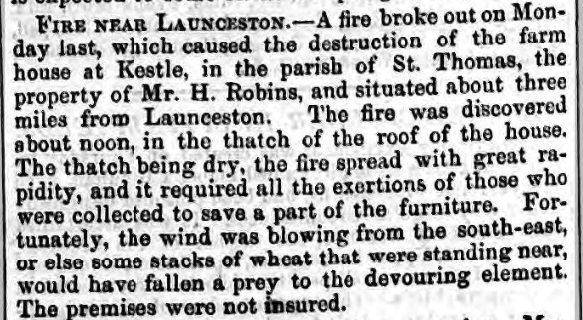
Launceston Weekly News, April 16th., 1864: St Stephens Fire. On Monday last the workshops in the occupation of Mr W Burt, builder, St Stephens, Launceston, were entirely destroyed by a fire which broke out with great fury while the men were absent at dinner. In a short time the whole premises became the prey of the flames which shot up in immense and lurid volumes, and formed a striking object from Launceston. In less than an hour after the commencement of the fire the roof of the workshop fell in with a crash, the noise of which was plainly heard from the Castle Grounds. The fire engines from Launceston were soon on the spot, but were powerless to combat with the vast body of fire. After completely gutting the premises, which fortunately stood detached, the fire gradually subsided. Fears were at one time entertained for the safety of Newport House, the wind blowing the flames steadily in that direction. Mr Burt is engaged in rebuilding St Cleather Church, and a large quantity of prepared timber work for that edifice was on the premises, all of which was destroyed. It is reported that the fire was occasioned by a lad placing some shavings in the trunk of a hollow tree near the premises, and igniting the shavings with a match, and the wind blowing in the direction of the workshops, the flames quickly reached them.
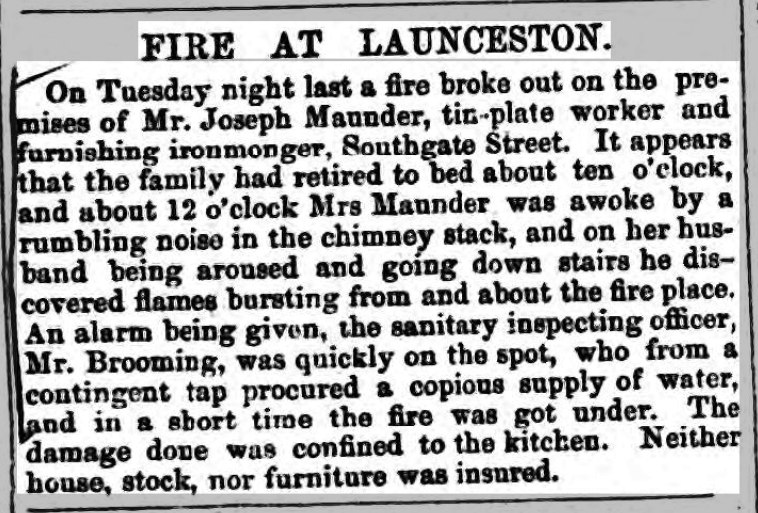
27th August, 1864, East Cornwall Times: Fire at Launceston. On Tuesday night a fire broke out on the premises of Mr Joseph Maunder, tin-plate worker and furnishing ironmonger, Southgate Street. It appears that the family had retired to bed about 10 o’clock, and about 12 o’clock Mrs Maunder was awakened by a rumbling noise in the chimney stack, and on her husband being roused and going downstairs he discovered flames bursting from and about the fireplace. An alarm being given the Sanitary Inspecting Officer was quickly on the scene and in a short time the fire was got under.
January 14th, 1865: Launceston Weekly News.
FIRE AT TOWER STREET, LAUNCESTON. LAST NIGHT.
Last evening a fire broke out in Tapson Court, a square of buildings adjoining Tower Street. It appears a chimney in the dwelling house of William Congdon, sawyer, accidentally caught fire, and this ignited two other chimneys which were contiguous to it. The flames soon assumed a serious aspect, and as a strong wind was blowing from the north, it was feared at one time that the conflagration would extend to the other houses in the vicinity, but fortunately assistance was soon forthcoming, and in a about a quarter of an hour the flames were got under. The Mayor, (R Peter, esq.) was quickly at the scene of the fire, but his services were not required. We are glad to state that no property of any importance was burnt, as any loss would have been of serious consequence to the poor persons resident there. Amongst those who rendered active assistance were PO Barrett, William Higgs, William Bluett, James Broad, Thomas Cory,,jun., Benjamin Reuben Elliott, John Oke, jun., and several others.

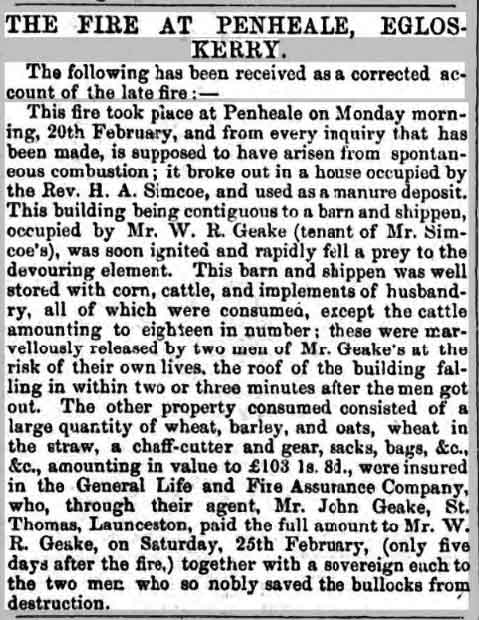
Launceston Weekly News, 3 March, 1866: FIRE IN LAUNCESTON.
Yesterday evening about 6 o’clock, a fire broke out in the bakehouse of Mr Whittam of Southgate Street, which for the time caused a considerable alarm, but fortunately in consequence of the absence of wind, and the energetic efforts used in extinguishing the fire, it did not extend beyond the bakehouse, the heating of the oven in which is supposed to have been the cause of the outbreak. The premises attached to the house of Dr Felce were at one time in much danger, and if the fire had spread the adjacent warehouse of Mr Ching, containing large stores of inflammable substances, would have made the consequences very serious. As usual at fires there was an abundance of volunteer aid, and the town fire-engine was made as useful as the supply of water would admit.
In a letter to the Editor on the following day the writer stated that Mr Ching’s stores contained oil, turpentine, and tea, all of which had been in imminent danger of catching fire. The writer also stated that the water supply was so inadequate that the fire engine hoses could not project water more than 4 or 5 feet high.
East Cornwall Times, May 1st, 1869: Incendiarism at South Petherwin.
On Monday evening last, about 9.45, some evil disposed person, or persons, maliciously set fire to a rick of wood containing about 600 faggots, at Penlaurel Cottage, South Petherwin, the property of Mr R Peter. It appears that Mr Peter has lately discovered that a workman named Pethick, who has been in his employ for seven years, had been selling straw and mangolds, and applying the money to his own use, for which he was taken into custody on Friday, 23rd April.
On Monday night last – the night of the fire – Mr Miller, superintendent of police, was sent for, when on learning that threats had been made against Mr Peter, apprehended the daughter of Pethick and a young man named Blake, a lodger, who are now in custody, and both cases will be heard at the Petty Sessions on Thursday next. The rick stood within a few yards of some thatched cottages, and the probability is that, had it occurred an hour later, it would have burned down four cottages, a stable, and pig’s house. We understand that Mr Peter’s farm property is insured.
Pethick was committed to trial at Quarter Sessions on theft charges. Elizabeth Pethick was ordered to stand trial at Quarter Sessions on arson charges. Blake was released without charge. Richard Pethick was found ‘Not Guilty’ on the grounds the alleged thefts were not proven, at the Quarter Sessions in Launceston, on 3rd July, 1869. Elizabeth Pethick was acquitted of arson on the grounds of ‘insufficient evidence’ at Cornwall Assizes at Bodmin.
East Cornwall Times, August 7th, 1869.
(Mr Richard Peter was an estate and land agent with offices in Westgate street.)
14 August 1869, East Cornwall Times: FIRE AT TREBURSYE.
In the farm-yard of Trebursye, the property of Mr Charles Gurney, a fire occurred on Tuesday night by which three stacks of hay, one of old and two of new hay, were nearly consumed. The fire was doubtless occasioned by the heating of the new hay which was being put together in too damp a state. About forty tons of hay were destroyed. Launceston Fire Engine was soon on the spot, and by the exertions of the fire brigade and volunteer assistance, about ten tons of hay were saved and the fire prevented from spreading further.
Cornish & Devon Post, 27 September, 1873: TERRIFIC GAS EXPLOSION IN LAUNCESTON.
The inhabitants of Launceston were thrown into a state of consternation last night by the whole of the gas lights of the town suddenly going out. It appears that in Exeter-road during the evening there had been a strong escape of gas, and the gas men and others were searching for the leakage. Just outside the residence of Mr C Parsons, veterinary surgeon, a pit had been dug into a drain and a light applied. The light burned for a time but soon died away. All danger was thought to be over, but suddenly a loud explosion was heard and the whole of the neighbouring houses were shaken. Mr May, the Turnkey, and Mr Congdon, were blown off their legs, but were not otherwise injured. The gas had penetrated through the drain and had run from the light outside to underneath the flooring of Mr Parsons parlour floor and exploding there caused an amount of damage that is well nigh indescribable. Up stairs the wreck was scarcely less complete. In the adjoining house occupied by Mr Dalby, organist, the coal house under the stairs was blown into the passage. There is no gas light in Mr Parsons’ house nor has there ever been a pipe laid to the house, and the gas had come solely through the drain. The smell in the room had been very disagreeable, and Mrs Parsons had fortunately only just left the house on that account and was staying at Mr Vivian’s until the leakage was stopped. A further examination this morning has proved that the damage was much more serious than was at first thought. The walls have been moved from their foundations and have parted company from the ceilings and floor of the house. There are fissures in all the walls and partitions and a large four-post bedstead was thrown so violently against the ceiling above as to cause it all to fall. The front wall of the house occupied by Mrs Kenner is shaken, and some cupboards inside and the window frame smashed.
Launceston Volunteer Fire Brigade: Sir:- The officers and Committee of the above Brigade beg to appeal to you for a donation, and annual subscription, towards the expenses incurred in rendering the Engines and their appliances thoroughly efficient.. An under-carriage has been added to the new engine, so that in case of a fire in the country, we could put in four horses, and travel at the rate of Ten miles per hour, Sixteen men also riding on the engine.
The under-carriage has been made expressly for the use of the country at a cost of nearly £50. There has also been added apparatus for rescuing persons, who otherwise could not escape; as well as Ladders, and safety Helmets for the men who are exposed to danger. The Engines have been put in complete repair with new suction and delivery hoses at a cost of about £160. There is a deficiency to be made up of nearly £30, which, by your assistance, we hope soon to be rid of.
The Brigade consists of Six officers and Twenty-four men, who, in case of fire, would be ready to start in a few minutes to the scene of action. The Engines and all appliances are vested in the Town Council as Trustees for the public, and to be enabled to keep everything in good working order an annual outlay of about £30 will be required. —– The Engine station adjoins the Butcher’s Market and will be open for your inspection [which we cordially invite] on Christmas Market Day, and on the three successive Saturdays, from 1 o’clock to 5 pm, when one of the following officers will be present, viz: Captain Ching, Deputy Captain WD Pearse, Messrs. Charles Jenkyn, Samuel Treleaven, Richard Robbins, or the Secretary. I remain, yours Truly, Geo M Gifford, Secretary and Treasurer. P.S. Donations may be paid to any of the above officers. Dated 4th December, 1873.

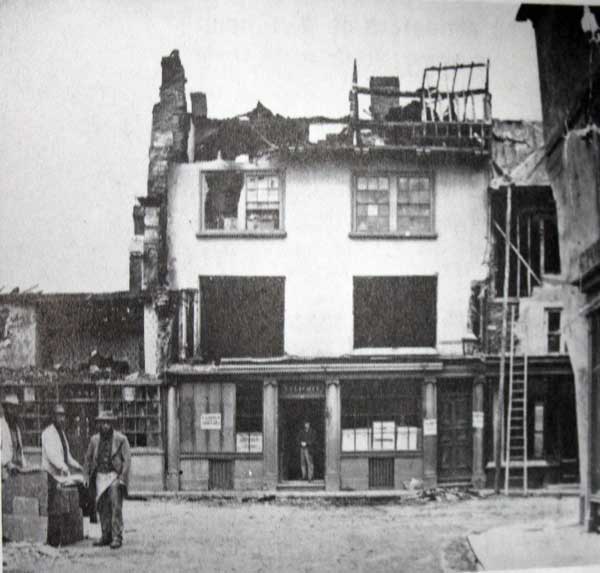
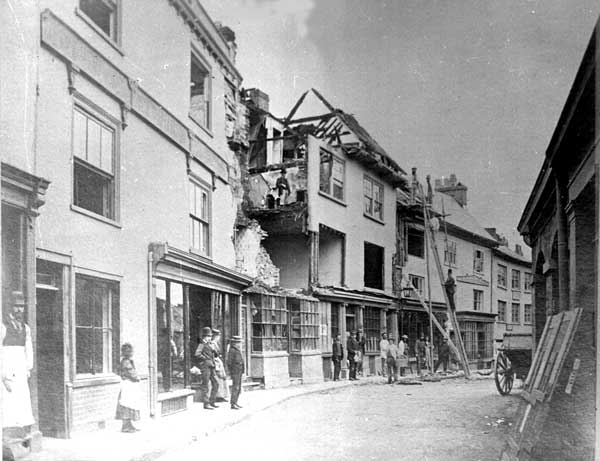
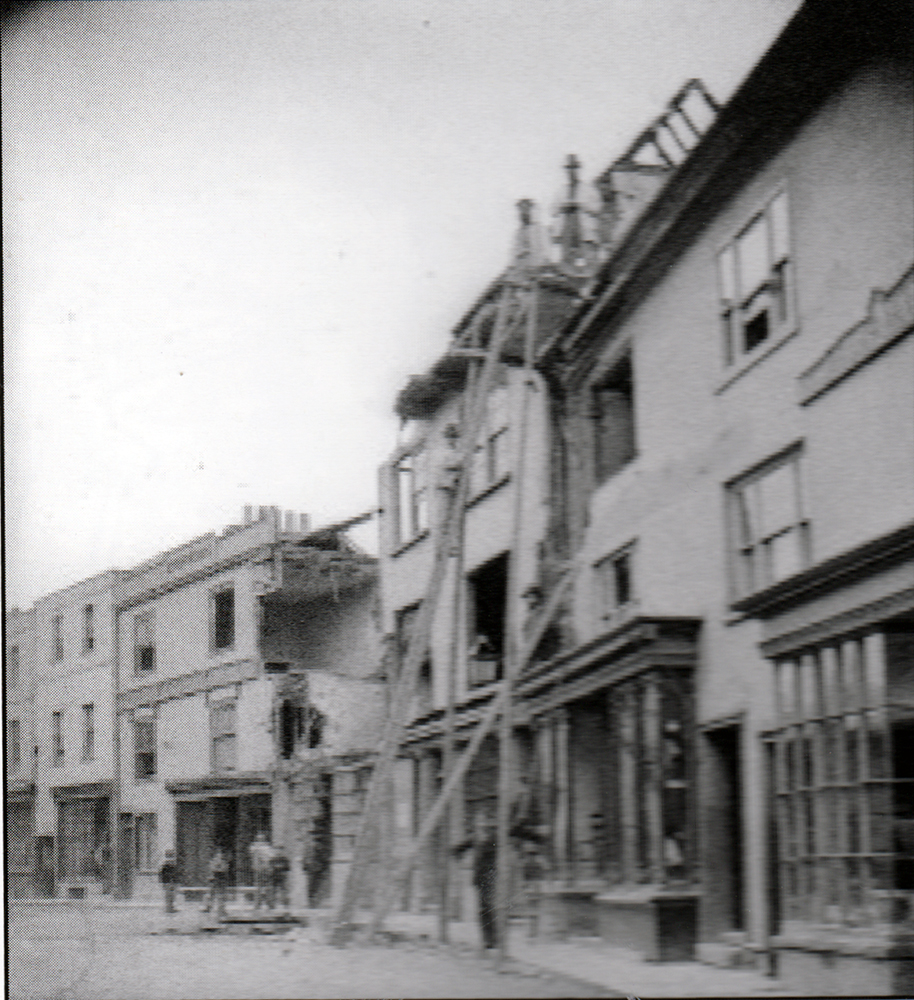
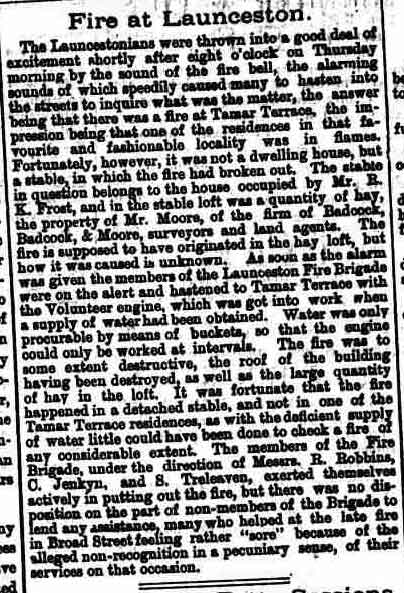

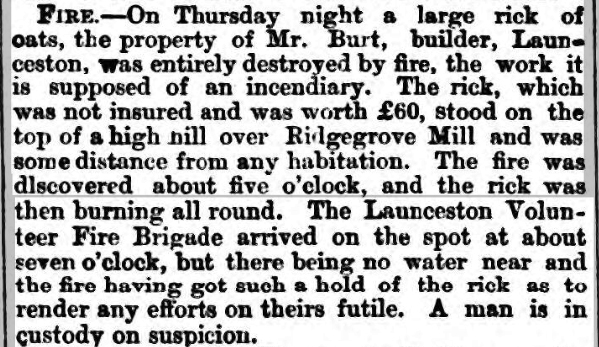
10 January, 1880: John Stratton, an old miserable-looking tramp, was brought up on remand from Saturday on a charge of setting fire to a stack of oats, the property of Mr William Burt, builder, at St Stephens, on 1st January. Mr William Burt, builder and farmer, of St Thomas-by-Launceston, deposed that on the 1st of January inst. he had, in a field about a mile from his house, a large stack of oats. The field adjoined the land which he occupied up to Michaelmas last, and was known as the ‘turnpike field’. The stack was the produce of about seven acres, and was close to the upper hedge which adjoined the lane leading to the Dutson Road from Launceston to Holsworthy, sometimes known as the ‘green’ and the ‘Ivyhouse’ Lane. On being charged the tramp said he had left Holsworthy Union that morning; he was feeling fed-up with tramping, nowhere to stay, nothing to eat. He admitted setting fire to the rick so that he could have food and shelter. He gave his name as John Stratton, from St John’s, New Brunswick, saying he had been in the country eight months, tramping about in the state he was in then, also that he had been to sea as a cook on board. When handed over to the County Police he said: “I hope they will give me ten years, and that will just do for me”. He was committed for trial at Bodmin Assizes.
P & W News, 12 March, 1881: Destructive Fire in Launceston: £200 worth of Property Destroyed – Supposed Incendiarism. Shortly after midnight on Monday the inhabitants of Launceston were awakened by the clanging of the church bell announcing the outbreak of fire, the first since the business premises of Mrs Thomas and Mr Stephens in Broad Street were razed to the ground.At the back of the villa residences in Westgate Street occupied by Messrs Cater, Brett, and Gubbins, and near the Western Subscription Rooms, stands, or stood, a large wooden structure of about 30 feet by 16 feet, erected some years ago to meet the temporary scholastic requirements of the Dunheved College Company. On the erection of the handsome College in the Dunheved road, this building was not further required and was let to Messrs Geake & Son, cabinet makers, upholsterers, and organ builders, of Westgate street, who for years have carried on an extensive business throughout East Cornwall. The building was used as a workshop, and it was stated at the time of the fire, a large quantity of well-seasoned mahogany, walnut, maple, and other expensive wood used in the cabinet-making trade was held in there. In addition there were several costly chests of cabinet and organ-making tools used by Messrs Geake, another chest of tools belonging to Mr Mills, one of the workmen, and which was, unfortunately not insured, organ pipes and other apparatus, 200 lbs of hair, several drawing-room and dining-room suites, which had been removed hence whilst Messrs Geake were completing a larger and more convenient workshop, several pieces of partly-made furniture, and many other things. It can easily be understood how these with the large quantity of shavings, &c., formed one pile of highly flammable matter which would quickly respond to the smallest spark. The shop had been used on Monday morning for a short time, during which the fire-stove was used to melt glue, or some such purpose; but the fire was allowed to go out again almost directly and all was seen to be safe before those who worked there left. Moreover, the precautions taken for preventing the spread of fire beyond the stove prove that the conflagration could not have originated here, the stove being raised by brickwork above the floor, and the latter protected by a very large sheet of iron; whilst the time which elapsed between the letting out of the fire and the out-breaking of the conflagration endorses the above conditions. Mr Geake, senior, went to the shop in the afternoon for a short time only, and he left it about six o’clock, having first assured himself that all was safe and, as he asserts, securely locking the door. These and other matters to which we shall refer presently prove conclusively that the fire, which, as it was so disastrous in its consequences, but which might have ended far more severely for the town, was the result of a dastardly act of incendiarism, the perpetrator of which will ere long be brought to justice. Mr Gubbins was aroused by a fierce glowing light through his back bedroom window, and at once sprang out of bed and saw the door of the workshop open and the interior one mass of flames. He gave the alarm and aroused his neighbours and, with Mr Cater, he proceeded to call the Fire Brigade, who promptly responded to the call whilst the fire bell was kept going for upwards of an hour. Lieutenants Hayman and White, with Engine-Overseer Robbins, were soon at the engine house and with the aid of the other members of the Brigade soon got the engine and other appliances to the scene by hand. By this time the fire had obtained a strong hold of the building, which was one mass of flames, lighting up the country for miles around. Fortunately for the houses close in front, the heavy wind which was raging was blowing against the front so that the large pieces of burning wood, shavings and other material that filled the air from the seething, burning mass was blown back towards the open country in the direction of Windmill Hill and not on their roofs, which, from the gabled style and the quantity of woodwork about them, might quickly have become ignited. The first question with the Fire Brigade, of course, was where to get water. This was speedily settled, however, the well close by the Westgate Inn affording an abundant supply, and dispensing with any need of an appeal to the hydrants. The well was some distance from the fire, but thanks to the excellent supply of hose which the Brigade possesses, there was not the least difficulty in bringing a good stream of water to bear on the flames. These had gained too much headway, however, to be subdued and all the efforts of the Brigade were concentrated to the pouring of water on that part of the building where the valuable chests of tools were kept, in order, if possible, to save a part of them. But even this proved futile, for in a course of two or three hours the entire building and its contents, down to the very sleepers on which the floor rested, were one mass of smouldering ashes from which nothing but saws that had been burnt into all sorts of fantastic shapes, handleless chisels, bits, and other things now in a worthless state were dug. The total amount of damage is estimated at about £200, not one farthing of which, so far as Messrs Geake and their workman are concerned, is covered by insurance. The building, which belongs to Messrs Dingley & Co., was however, insured in a sum that will cover all loss. That the fire is the work of an incendiary now appears to entertain the least doubt. This belief is supported by the fact that the stove was allowed to go out many hours before the fire broke forth and by Mr Geake, senior, having left the place all safe, with the door locked, so late as six o’clock in the evening. Moreover, the door, an ordinary one with the common inlaid lock, was open when the fire was first discovered, and afterwards both the lock and the bolts were dug from the debris with their fastenings shot over, thus, proving conclusively to the fact that the door had been forced.
On Tuesday the Police was communicated with and steps were taken in regard to certain individuals to whom strong suspicions attached. Up to the present those steps have lead to no apprehension, but the police share the strong hope of the public that ere long the perpetrators of so foul a deed will be brought to justice. More than this it would be unwise to say at present and the matter may be safely left in the hands of P C Barrett who has before this unravelled a far more tangled mystery. Much sympathy is felt for Messrs Geake on their loss, as also for their workman, Mr Mills, whose chest of tools, valued at £12 or £13 is totally destroyed. Mr Mills is a steady, industrious man, with a wife and family, and we are glad to hear that a subscription list is opened to aid him. Should any friends from a distance willing to assist, we shall be happy to receive subscriptions and hand them over to those having care of the general funds.
Post & news 23 July, 1881. Destructive Fire: An alarming fire broke out in the Town on Wednesday evening last, at the back of the Cornish Inn. Adjoining this Inn Mr Trewin, cabinet maker, &c., has a workshop, and on the evening named, just after five o’clock, one of the men working on the tower of the new Guildhall saw smoke issuing from the roof. He at once communicated his suspicions of its being a fire to Mr Martyn, working at Mr Hawkins’ coach factory opposite, and who had also observed the unusual appearance. Mr Martyn at once ran to the place and found that the workshop, filled with the most inflammable material, as is generally the case, was one mass of flames inside. The alarm bell was rung and the Launceston Fire Brigade, with their engines, were soon on the spot, under the command of Lt G G White, jun., in the absence of the Captain, Mr J Ching, who was in London, There was an ample supply of water from the reservoir in Broad Street, but the chief difficulty was to get a suitable point of vantage for the hose to play on the now high ascending and spreading flames, the burning building being in the midst of a lot of old and curious tenements, reached only by passages. The flames had by this time laid hold of the back of Miss Green’s house, and of the Cornish Inn next door, and grave fears were at one time felt that the whole street must succumb to the devouring element. But the Brigade and the public worked with praiseworthy activity and consummate to the issue at stake. The little engine was run up a passage near the back of the Dolphin and supplied by buckets of water passed from hand to hand by cordons of workers. A fine stream of water was kept playing upon the burning pile from a roof of an adjoining house. The hose of the big engine was carried through Mr Hayman’s house at the Launceston Bank, for the safety of which fears were at one time entertained, and to which considerable damage was done by water &c. From a top window of the house this hose also poured a fine stream of water on the flames from the other side. The fire was got under in about an hour and a half, but not before the shop was entirely destroyed and Miss Green’s house, and the back of the Cornish Inn was very much injured. Still, when one looks at the debris now it is wonderful that it was kept in so small a compass. Mr Trewin, for whom much sympathy is felt, is not insured and his loss is estimated at £150 or £200. The buildings are covered by insurance. The origin of the fire is unknown, and Mr Trewin states that no one was in the workshop after 8 in the morning. The Mayor was present and most indefatigable in his assistance and the way in which he handled the brigade.
P & WN, 11 Feb, 1882: A Narrow Escape From Fire. Launceston had a narrow escape from a very destructive fire on Wednesday morning. Opposite the Jubilee Inn in Tower Street are some very old premises occupied by Mr Searle, chimney sweep and umbrella repairer. At the back of the premises is stored a large quantity of soot, to which Mr Searle had added another bag on Tuesday, but which unfortunately turned out to be ‘alive’, or in a smouldering state. About half-past eleven Mrs Searle, alarmed by the smell as of something burning, went to the rear of the place, and found smoke arising from the soot house and from this soon sprung a large flame of fire. She at once raised an alarm and several neighbours soon came to her assistance and as speedily as possible the Fire Brigade called, and with their engines and appliances were on the spot with praiseworthy promptitude. Fortunately however, their services were not required, a few buckets of water, which were speedily obtained, quickly extinguished the flame. It appears that the burning soot set fire to the bag in which it was contained and this in turn set fire to a bundle of umbrellas and other things close by.
Being at so late an hour it is fortunate the fire was discovered so soon as the buildings are very old and dry, and connected with the oldest part of Launceston, and had the fire once got a firm hold a great part of the town might have been speedily destroyed. It is a disgrace to the town that the hydrants here, too, were choked, no water could be obtained at this level, and the big engine had to be taken to the reservoir in Broad Street.
A small fire broke out the same night in a room occupied by W Elvins, in Angel-hill, and Mrs. Dennis on the Old Hill had her chimney on fire, but fortunately, here also, all ended in smoke
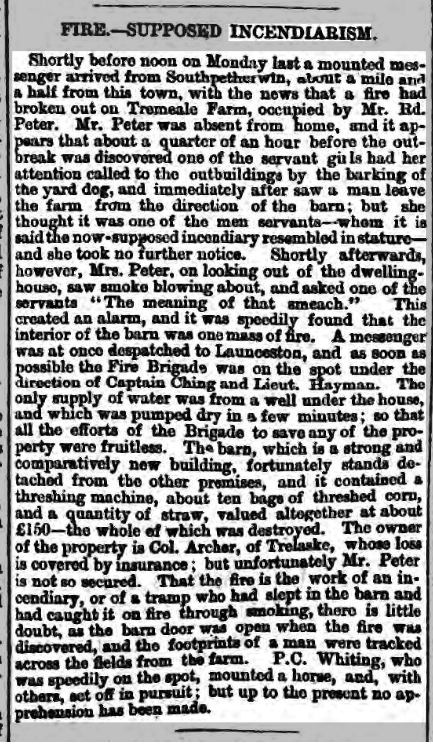
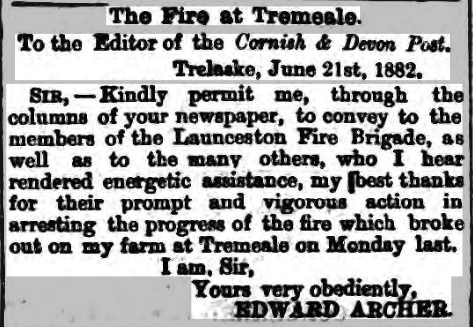

Post & Weekly News: 4th February, 1885. FIRE AT LAUNCESTON:
A fire broke out on the premises of Mr F Couch, tailor, Southgate Street, Launceston, on Tuesday evening last (31 January), but owing to the strenuous exertions of several persons, who were present immediately the alarm was given, the conflagration was soon got under.
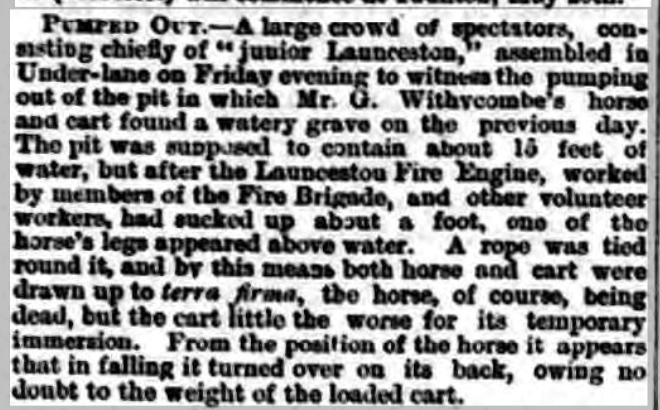



December 21st, 1889: FIRE: The fire bell was rung on Tuesday morning and the fire brigade called out consequent on a fire taking place at St Stephens House, the residence of Mr Graham-White, Solicitor, captain of the Launceston Volunteer Fire Brigade. The dining-room fire was used on Sunday, and it is probable the chimney arch then took fire, and it had been smouldering from that time. By exertions made before the brigade could arrive the fire was extinguished with but slight damage. It is a matter for congratulations that the fire did not make headway during the night as St Stephens House is at a considerable distance from the town.

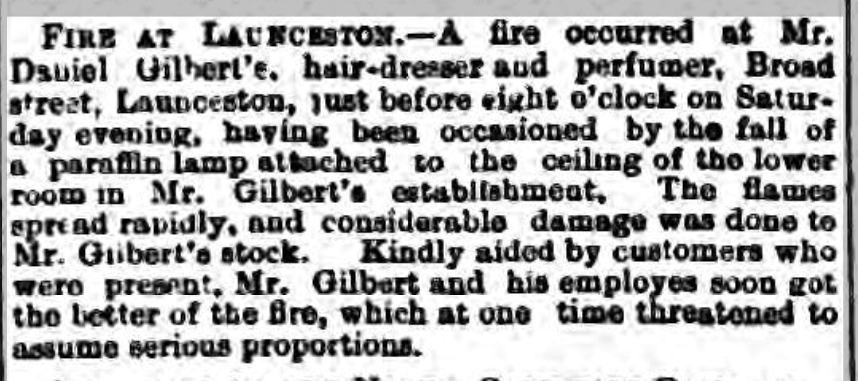


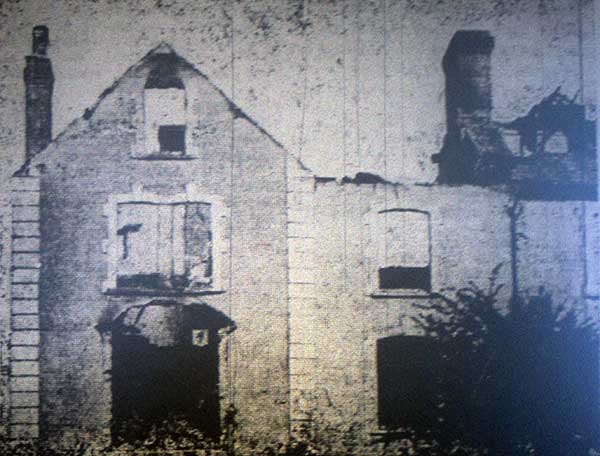
Cornish & Devon Post & Western Counties Advertiser, Saturday, 4 April, 1896:
FIRE AT LAUNCESTON: the value of the new water supply.
A fire, which, but for the commendable promptitude with which it was got under, might have had most disastrous results, broke out in the premises occupied by Miss Susan Maunder, tobacconist, Church Street, on Monday night last, about twelve o’clock. The outbreak was discovered by Mr Henry Warren, in the employ of the Launceston Gas Company, who was engaged in extinguishing the town lamps for the night. He, with Dr Thompson and Mr Rockey, speedily spread the alarm, and Acting-Captain Hayman and Lieut Downing, of the Fire Brigade, were acquainted of the outbreak by loud knocking at their doors. In the mean time, attempts were being made to apprise Miss Maunder, who was then supposed to be on the premises, of her danger.
The fire bell was sounded as soon as deemed necessary, and the town, or a great part thereof, immediately aroused, some people turning out but half clad. The flames were now beginning to get a hold on all the back premises, and before many people had assembled in Church Street the sparks were towering to the sky [it being a beautiful moonlight night, with absolutely no wind], and altogether it looked as if a big blaze and consequently heavy damage was to be the result, the premises being situate in the centre of one of the main building blocks of the town, and being by no means easy of access.
All this while persons were endeavouring to gain entrance to the burning building. A ladder was fetched and raised to the upper front window, whilst, immediately beneath, the shop door was being broken open. The people in the street were then enabled to see the fire raging behind, and the excitement for a while was intense, as the whereabouts of Miss Maunder, who occupied the premises by herself, was not yet known. By the time members of the Fire Brigade arrived on the scene, however, and that was speedily, it was pretty well taken for granted that she was “far from the madding crowd,” as Mr Vickery, veterinary surgeon, and others stated having seen her on her way into the country about two hours previously, it being known to some that she intended going to Lewannick. The search for “one who was not there” was, therefore, abandoned, and attention was turned to the checking of the flames, which by now had gained a firm hold of the back of the building.
A reel of hose was speedily got in readiness, and after a strong force of water had been played from the hydrant in Church Street on the affected parts for twenty minutes a complete mastery of the flames had been secured. Thanks to the new supply, there was no scarcity of water, and it was really gratifying to hear an unanimous laudation of one of the Town Council’s latest efforts on behalf of the town. [It should here be recorded that the “new water supply” above quoted, referred to the building of the new reservoir at the top of Windmill, which had been put into service under the leadership of Mayor John Kittow, and opened by his wife, Mayoress Mrs Kittow, on 31st October, 1995: just five months previously. J.Edwards.]
What would have happened had there been a scarcity of water and a strong wind it is impossible to say, but doubtless the London Inn (landlord Mr H Sargent) adjoining, would have fallen a victim to the flames. As it is, a large portion of the back of the inn, separated simply by partitions from Miss Maunder’s house, is considerably damaged, as well as furniture. Previous to the alarm being given Mr and Mrs Sargent heard the flames climbing along the rooms, but put it down to the movement of rats or mice, and it was not until they went to the upper rooms that fire could be smelt.
The premises of Mr C H Hayman, adjoining on the other side, being comparatively new, and separated by a substantial wall, less danger was anticipated there; though precautionary measures had to be taken to keep the myriad sparks and the intense heat from kindling into a flame the woodwork at the top. Mr Wroth, in the employ of Mr Harman, fortunately appeared on the scene quickly after the alarm was given, and by a continual pouring of water on the involved parts kept the fire from spreading to the studio. Notwithstanding this, a little damage was done, but it is covered by insurance. A commencement had been made to clear the front part of the burning building, including the tobacco shop, and the furniture and stock, but it was soon seen that further steps in this direction would be unnecessary, and the things were allowed to remain. By 1.30 there was not a flame to be seen by people in the street, and the crowd consequently began to dwindle down.
Shortly previous to this the manual engine, “Volunteer”, was connected to the Broad Street reservoir and a hose carried in through the back way in High Street and through an upper window, the fire being still strong in this part of the premises. A few minutes care, however, and this was also got under, all further danger being then at an end. By 2.40 pumping had ceased and the streets were again quiet. The scene of the fire was carefully watched throughout the night, but no further outbreak occurred.
On Tuesday the spot was visited by several people, but there was very little to be seen as the front part of the house, saved from the flames, hides the ruined part behind. The building is very old and of a dilapidated character before the fire, so it can well be imagined that it is now in a most precarious condition. The stairs and ceilings are broken down and the roof and walls considerably damaged. Beside this the front of the building by no means enhances the appearance of Church Street, projecting as it does some distance beyond the line.
It is freely hoped, therefore, that it will be condemned and taken down, a great improvement being thus effected in one of the narrowest streets in the town. We have been given to understand, however, that attempts will be made to repair the premises. If this can be done, it will mean the delaying of a much-needed improvement for many years to come.
It is the property of the executors of the late Mr Marshall, of Bounsell’s Lane, and is insured by the Royal Exchange Fire Office, local agent Mr CL Cowlard. Miss Maunder’s stock and furniture is insured with the Norwich Union Office, Messrs Peter & Wenn, local agents; and Mr Sargent’s furniture in the Royal Office, local agent Mr H Rendle Since the fire Miss Maunder has been hospitably entertained by Mr and Mrs JH Cory, Broad Street. Happily no accident occurred during the fire with the exception of a slight cut from glass which Mr J James received to his right hand on endeavouring to enter the top front window just as the outbreak was discovered. The Brigade, as well as many outsiders, deserve praise for the promptitude and skill shown in the mastery of the flames, for, seeing the damage wrought, it is surprising that it was secured so speedily.
The fire is supposed to have originated in Miss Maunder’s kitchen, but, as is the general rule, the affair remains a mystery.
Weekly News: 4th April, 1896: FIRE AT LAUNCESTON
At midnight, Monday, fire broke out in the back premises of the tobacconist shop in Church-street, Launceston, occupied by Miss Susan Maunder. The back premises were gutted but the Brigade controlled the flames before the shop and upstair rooms were greatly damaged. Miss Maunder was not in the house that evening. The total damage is estimated at £200.
Western Morning News Wednesday March 2nd, 1898: Fire at Race Hill
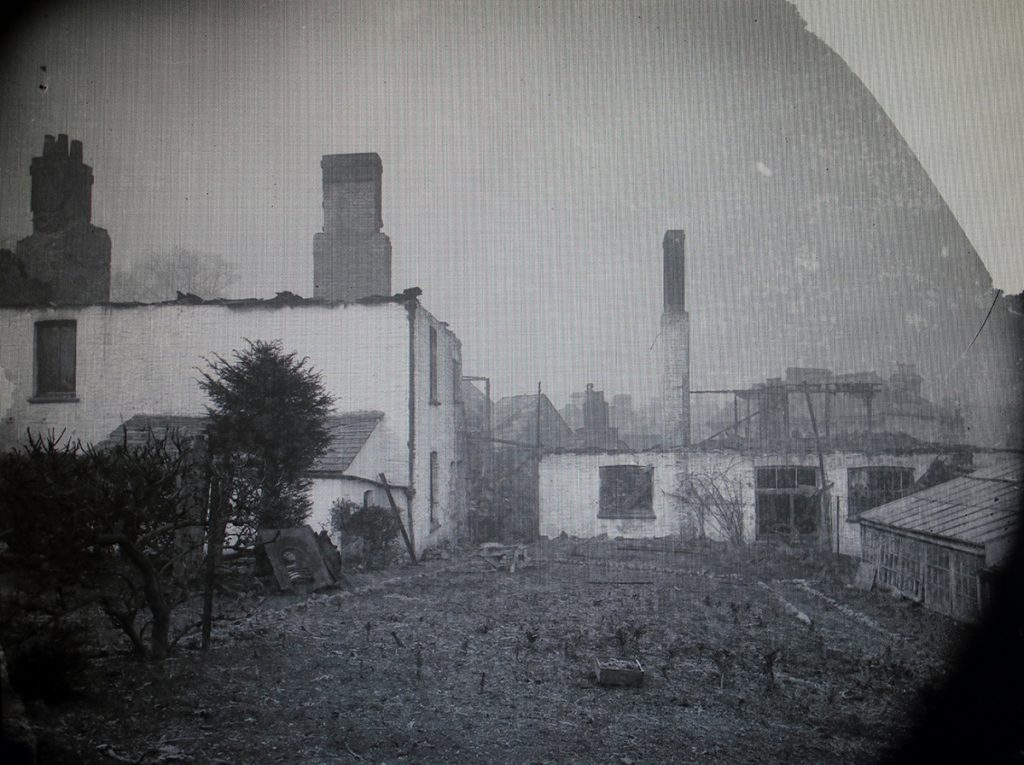
Post & News, March 4th 1899. FIRE AT LAUNCESTON: Cattle Burned to Death.
The fire which broke out at the premises of Mr W Lugg, in Race Hill, on Thursday morning was a very serious one. Shortly after eight Mr Baker, who resides at Druccombe Terrace, discovered that the linhay &c., owned by Mr Lugg in the field just below, were on fire. He raised an alarm and a number of persons were soon on the spot. It was discovered that there were a number of cows in the shed, and as soon as the door was opened two of them rushed out. Mr Lugg, who was in the town delivering milk, was sent for, and on his arrival he, with the help of others, endeavoured to get the remainder of the animals out. The fire, however, had obtained a strong hold on the building, and it was only after considerable difficulty that two other cows were set free. But there still remained two unfortunate animals that it was impossible to get out on account of the flames, and these were soon so severely burnt that they died almost immediately. The members of the fire brigade, who had arrived on the scene, although without engine or hoses, rendered assistance by pouring buckets of water, obtained fromthe houses nearby, on to the flames, which had by this time, however, almost destroyed the dry wooden buildings. The four cows got out were driven to a linhay near by, but were so badly scorched and burnt that the veterinary surgeon had to be fetched in order to alleviate their sufferings. It is doubtful whether they will all recover and if they do they will be of but little value. The two dead cows which were afterwards dragged outside into the field, present a shocking appearance, being fearfully burnt about the head, legs and other parts, their frantic endeavours to get free having also caused them to knock themselves about a lot. The origin of the fire is unknown. Mr Lugg left the sheds at about 7.15 am after making out the candle in the lantern he had used, and then departed for town on his way without noticing anything passing the sheds unusual. When he came up again, the buildings, as has been stated, were all afire, and within about half-an-hour after the discovery of the blaze, they were all burnt to the ground with the exception of the stable, which fared somewhat better than the other erections, although but little of it is left.
The two cows that are burned were estimated to be worth about £16 and £20 respectively, being the best of the six. The other four were probably worth about £15 each. There was also a quantity of hay and straw in the sheds, besides other things; so that the total loss is quite £100 or more. Mr Lugg has for a number of years carried out the business as a dairyman in the town, and much sympathy is felt for him, inasmuch as none of his loss is covered by insurance. A rick of hay which stood nearby the buildings was fortunately not attacked by the fire. Had the fire broken out when the pony was in the stable, it is probably that it too would have been burned and Mr Lugg’s present heavy cross would have been greatly increased. We hope that some efforts will be made to assist Mr Lugg in his loss and we shall be glad to assist in our columns.
Cornish & Devon Post, 7th February, 1903: FIRE AT LAUNCESTON.
On Saturday last, a fire was discovered in the dinner hour in the workshop of Mr Edward Rowe, cabinet maker, High Street, Launceston. Smoke was observed issuing from the shop, which, on being opened, showed that the fire had damaged a beam and some mahogany, a chest of drawers, and other articles. With the work of some friends, and there being a plentiful supply of water, the outbreak was got under. The origin of the fire is unknown; the damage is covered by insurance.
The Cornish & Devon Post April 11th, 1903. FIRE AT LAUNCESTON: GROCERY STORES GUTTED.
The inhabitants of Launceston were aroused on Tuesday morning last, shortly before six am, by the sound of the Fire Bell. It was soon rumoured that a conflagration had arisen at Mr Nathaniel Baker’s grocery stores in Castle Dyke, the rumour being greatly exaggerated as it was transmitted from one to another. The first to notice it was Mr Ed. Melhuish, in the employ of Messrs. Geake Brothers, mineral water manufacturers, close by, who saw smoke issuing forth, and who immediately gave the alarm. Meanwhile Mr R Belben, storeman to Mr Baker, had arrived and immediately commenced to pour buckets of water on the flames. Much praise is due to him for his timely action, for if the fire had obtained a good hold it may have been the means of a serious conflagration. By this time many people had appeared, and great assistance was rendered by all, especially Messrs. Lindon Cook, Fred Stephens, J Hawke, R Belben, FE Bennet, and Wroth. The Fire Brigade, under the able command of Mr WD Philp, soon arrived and worked admirably to extinguish it. Two hoses were kept on and there was a plentiful supply of water. Strenuous efforts were put forward and about 8 o’clock the desired effect was attained, the flames being entirely subdued. As it was, however, the stores of Mr Baker were totally gutted, and only a small quantity of goods were saved. The fire also reached the adjoining store of Mr Gillbard, saddler, where no great damage was done. The origin of the fire is yet unknown. The store were locked up about 7.30 on the previous evening, and were visited by Mr Baker just
before 12, when everything appeared allright.. The loss has not yet been estimated and the stores were only very slightly insured.
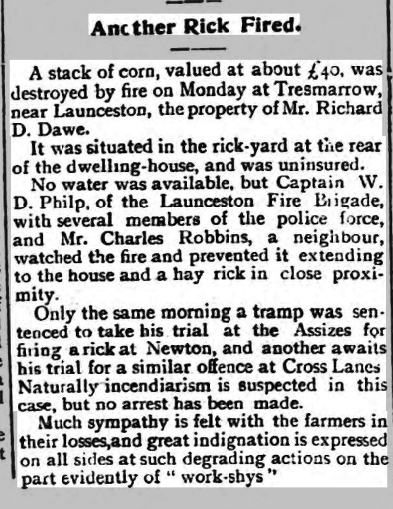
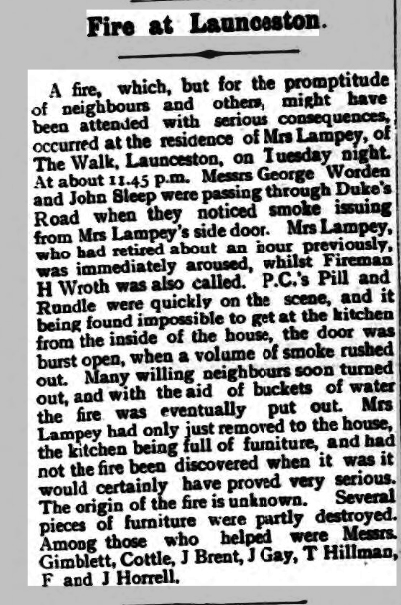
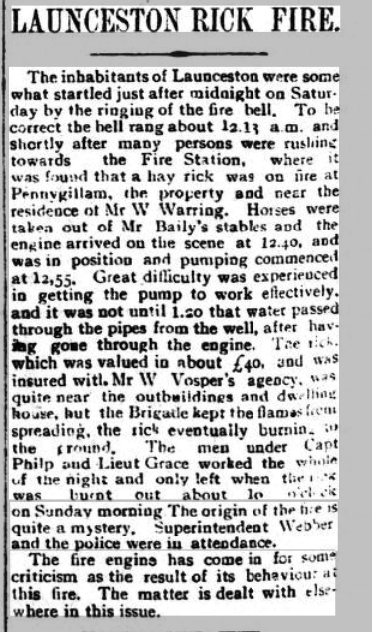
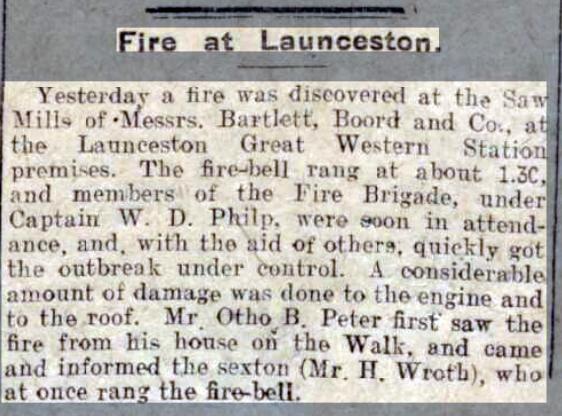
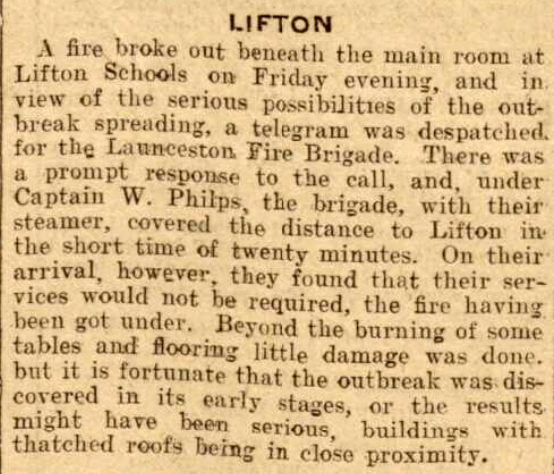
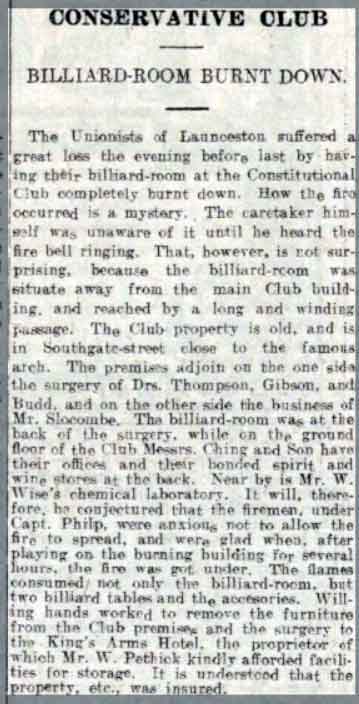
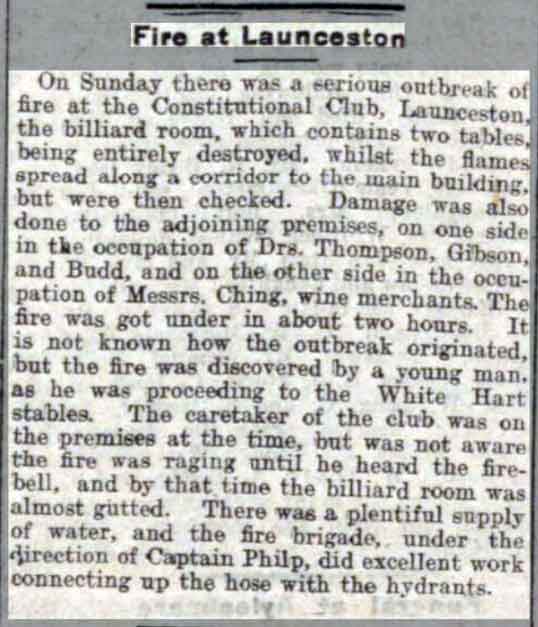
C & D Post, 17 May, 1913: FARM FIRE. Buildings Destroyed at Tresmeer.
A disastrous fire, resulting in the destruction of outbuildings and machinery, corn, etc., occurred at Church Town Farm, Tresmeer, about eight miles from Launceston, on Tuesday morning. The farm, tenanted by Mr JM Kittow, a well-known agriculturist, stands some distance off the main road adjoining Tresmeer Church, and among a few cottages, and the whole place was practically deserted on Tuesday morning, most of those from the neighbourhood having either gone to the market at Launceston, or being engaged in work away from the buildings. This probably accounts for the fact that the outbreak, which started in the straw-house, was not discovered until about 10.30 am. Then all available assistance was obtained and all the neighbours turned out and immediately organised a water-carrying party, whilst messengers were despatched to the railway station with instructions to telegraph Launceston for the Fire Brigade and Steam Engine. After some delay this was done, and the officials were informed at Launceston about 12 o’clock, the fire bell calling the men together being rung a few minutes later.
Meanwhile the men, ably seconded by the women, were carrying water from a very small stream which ran along outside the farmyard, whilst the others kept the pump, situated near the building, working, one of the gentle sex keeping the handle going with great vigour for a lengthy period. It was quite impossible, however, to stay the progress of the flames, and the live stock and as much corn, straw, etc., as it was possible to move in the time, were got out. The fire spread very rapidly and devoured a thresher, and completely destroyed an oil engine and other machinery, nothing eventually remaining but the bare walls.
The Fire Brigade got off smartly, and in exactly an hour from the time of the ringing of the alarm bell they were on the spot, eight miles from Launceston, and quickly got the engine into position near the stream, which had been damned back, forming a decent pool. The fire was lighted, and although it did not take at first, steam was got up in about 12 minutes by which time Captain Philp, who was in charge, was able to report the hoses were all connected, and a start was made. Two jets were put into use and the streams directed on to the flames, soon extinguished them.
Fortunately a large stack, which was quite near, escaped untouched, whilst the wind was not blowing in the direction of the dwelling house, and no harm occurred in that direction. Mr Kittow, who was at Launceston at the time, immediately drove off on receipt of the news, and the sight of the smoke seen from St Stephens Down must have been a distressing one to him. He arrived some time before the engine and assisted in making preparations for its arrival.
The men and women from the neighbourhood worked in a highly creditable manner prior to the appearance of the steam engine and no doubt did much to preventing the flames from spreading to the other buildings. The structure destroyed was a fairly large one, and the damage has been variously estimated by outsiders at about £1,000. It is stated that Mr Kittow was to purchase the farm from the Rev Hart-Smith Pearse, but it was not to take effect until Michaelmas next. The machinery, it is also rumoured, is not insured. Several spectators came out from Launceston on wheels, among them being the Rev TH Bailey (Wesleyan).
May 24th, 1913: The Tresmeer Fire. Since going to press last week we have been informed as to how the slight delay took place in sending off the wire from Tresmeer Station, asking the Fire Brigade to attend. The Station Master (Mr B Callaway) rightly refused to take the responsibility of sending for the Brigade on the information of two lads, but when the Rev Hugh Massey arrived, a few moments later, the wire was despatched (11.40) and within twelve minutes had been handed to the Fire Brigade officials, at Launceston, which was fairly quick work.
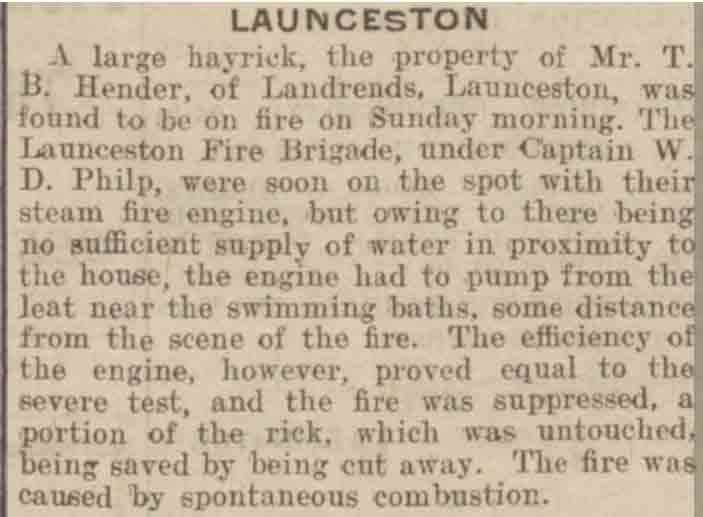
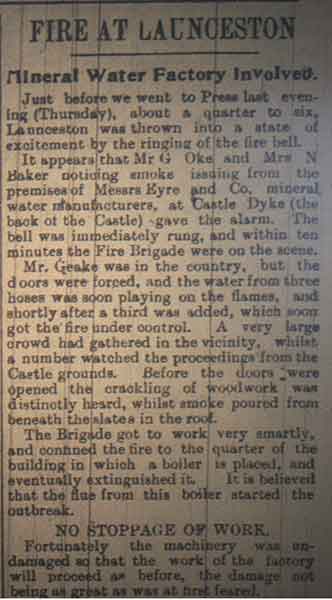

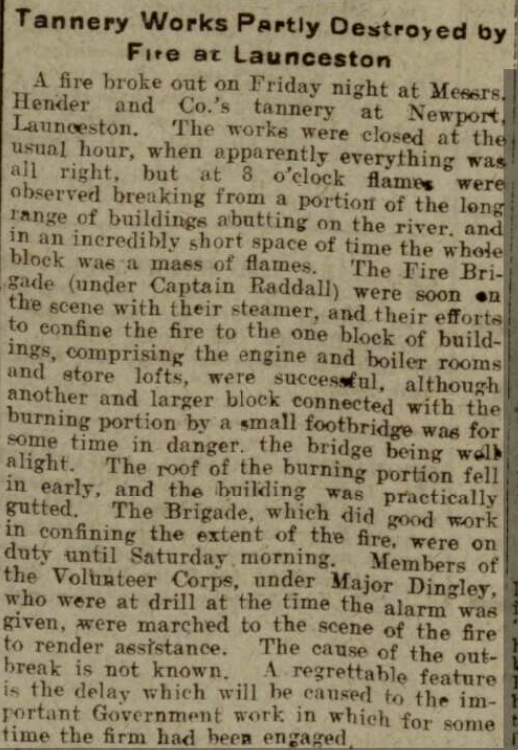
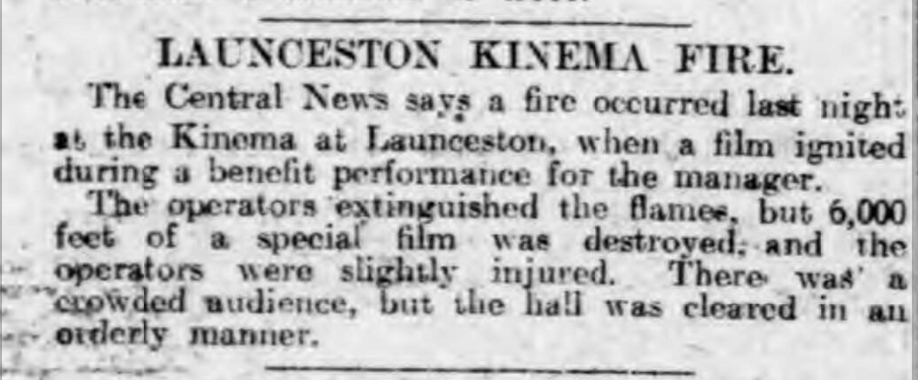
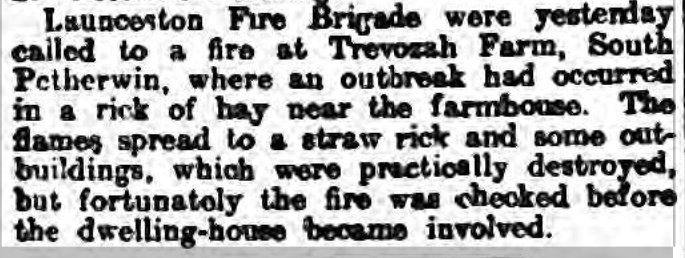
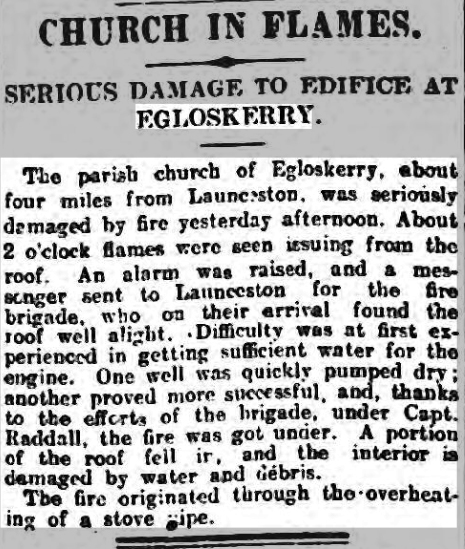
Cornish & Devon Post, February 14th, 1920: Fire At Egloskerry Church.
(Our Correspondent writes}: Consternation prevailed at Egloskerry on Sunday afternoon when the news spread of a serious outbreak of fire at Egloskerry Parish church. In a short space of time, streams of people were hurrying to the scene from all directions and on arrival no time was lost in procuring all available buckets, baths, and water carrying vessels, and immediately putting them to use whilst waiting the arrival of the Launceston Fire Brigade which had been telephoned for as soon as the discovery was made.
some members of the fire brigade arrived in advance of the main body with the fire engine and joined the many willing helpers from the village and neighbourhood who worked with a will carrying water from every available pump and well in the vicinity. Men, women and children alike put great efforts in assisting to subdue the flames and to particularise any special mention would be individeous as all worked like Trojans to save the building from destruction. But it may be said that the Wesleyans gave up their Sunday School and with many others assembled rendered praiseworthy services. Fire extinguishers were lent by Messrs G R Vowler (Penheale) and F A Bate (Moor View), Egloskerry.
Rev J H Thomas (vicar) was taking the afternoon service at Tremaine Church and was informed of the occurrence by special messenger. Openings in the roof were made in advance of the flames, and here constant streams of water were poured from buckets carried over ladders. Inside the building also a large quantity of water was thrown, which no doubt saved the seats (of pitch pine wood) from becoming ignited. All the available church furniture was removed into neighbouring dwellings.
Near the seat of the origin of the fire was the Norman font and this happily appears to be undamaged, and as far as can be ascertained little or no damage had been caused to the seats, windows or walls. The pulpit and organ being at the opposite end of the seat of the fire also escaped damage.
The fire was well under control on the arrival of the fire brigade, but a considerable amount of work was left to be done as there was a large quantity of unsubdued fire under the roof. An adequate supply of water for the fire engine was urgent after utilising all the available water in the well in Mr W S Jenkins’ orchard (from which a large quantity had been carried by buckets previously). The fire hose was placed in the main water supply of the village, which provided a constant supply. This happily did away with the necessity from the River Kensey, over a quarter of a mile distant, and the brigade , under the command of Captain F Raddall and Lt WT Mills, soon had a steady supply of water playing on the burning building and speedily extinguished the flames. The police in attendance were Sgt Cleave, of Launceston, and PC Warren, Egloskerry, whilst Mr G R Vowler, representing the Royal Exchange Assurance Company (with whom the building was insured), was also present.
The fire originated in the west end of the church, where there was a slow combustion stove used for heating the church, and the fire was probably caused through the over heating of the pipes igniting the pitch pine woodwork of the roof. Fire was lit in the stove between 6 and 7 in the morning. Services were held at 8 and 11 am, and when the vicar and his warden left the building about 12.30pm. everything appeared safe. The church was restored in 1887 at a cost of £1,000, and the Registers date from the year 1575.
Mr G. H. Ellacott of Badharlick, whilst assisting in removing the church furniture had the misfortune to injure his finger which necessitated medical aid.
The news was received at Launceston about half-past two and the fire bell at St Mary Magdalene Church was soon in motion. Some of the members of the fire brigade were at the time attending Divine worship, which they immediately forsook and made for their post. A full brigade mustered and the horses borrowed from Mr J B Smith, Castle Temperance Hotel, were driven by Mr Pethick; Captain C Raddall, with two or three men left immediately by car for Egloskerry, and were followed shortly afterward by the engine, the steam for which was got up in an incredibly short space of time.
When the brigade arrived at the scene they found that part of the roof was well afire and a corner of the second gable in danger. After the fire had been extinguished the brigade left, arriving home at about 7 pm.
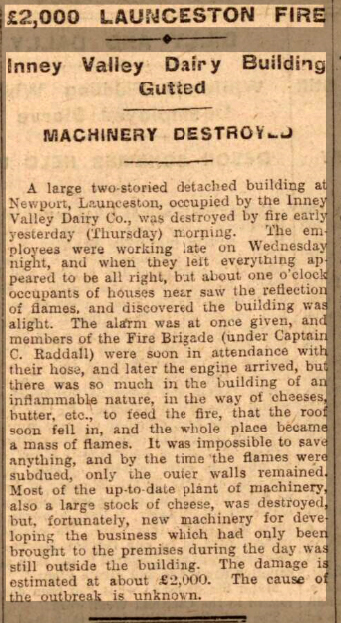
Cornish & Devon Post, 14 May, 1921: (as above) DISASTROUS FIRE AT LAUNCESTON.
Inney Valley Dairy Gutted: A Midnight Discovery.
A disastrous fire at Launceston in the early hours of yesterday (Thursday) morning, resulted in the total destruction of the Inney Valley Dairy at Newport, the property of Mr H Dawe. The premises, together with the machinery, were valued at several thousand pounds.
The factory was covered by insurance, the contents with the London Insurance Company (Messrs Peter, Peter & Sons, agents), and the buildings with the Commercial Union.
Only portions of the four walls of the building are standing. Fortunately, no life was involved and nobody was injured. Luckily, the building stood isolated on the bank of the river; and there was no wind, so that the Fire Brigade experienced little difficulty in preventing the conflagration from spreading to the houses close by. The cause of the outbreak is unknown. Hundreds of people foresook their beds and hastened to the scene. The first person to observe the outbreak and to raise the alarm was Mr F J Donan, an engine cleaner on the GW Railway, who told our reporter that he was standing outside the engine shed at about 12.45 when he saw a huge glare in the direction of Newport Bridge. At first, he thought it was the lights of a motor car, but presently observed that it was a flame, accompanied by smoke issuing from the roof of the Inney Vale Dairy. He hurried to the gas works to see if there was a telephone there. There being none available, Mr Fred Bickle (an employee of the Gas Company) ran to the Police Station and also informed PC Money, when he met him. Mr Bickle also rang the fire bell.
The fire had now got quite a terrible hold on the premises and the reflection of the blaze in the leaden sky was visible from any part of the borough. When the roof gave in, soon after, the flames leaped to a great height, enabling a person standing in Dunheved Road or Race Hill, easily to read a newspaper. So intense was the glare that residents in the centre of the town at first thought the fire had broken out in the vicinity of the Wesleyan Church. By this time the fire bell in St Mary’s Tower – a totally inadequate alarm – was sending up its sharp note. All the firemen who heard the alarm were soon at their posts, and quickly set to work under Captain Claude Raddall. The hose reel was the first despatched, followed very closely by the steam fire-engine. The hoses were connected to the hydrant in Newport Square, and in a very short time the men were playing a volume of water on the blazing building, which was now hopelessly involved. This was supplemented by the efforts of the engine, which was abundantly supplied from the river. The brigade battled with the terrific flames constantly for over three hours. The fire had such a hold on the building on there arrival, that the brigade were quite unable to remove anything from the premises.
At about 2.15 the second floor of the building gave way with a tremendous crash, and charred beams, red hot girders, and distorted milk cans, fell to the base, adding considerably to the already smouldering mass of fallen structure. The spectacular effect of the collapse will not easily be forgotten. Myriads of sparks shot upwards, like so many meteors. The firemen manipulating the hose stood in imminent danger of a collapse of the – – – walls, and the fall of a live electric wire which led to the premises, but fortunately neither occurred. One electric wire which fell was immediately thrown into the river, so as to obviate the possibility of its fusing, and so causing further damage. By 4 o’clock the flames were completely subdued, and the engine returned to the fire station. Capt Raddall, Lts W Mills and J Burford, and some firemen remained on the spot until 6.30 am., when they also retired from the scene.
In the course of conversation with our reporter yesterday morning, Capt Raddall lamented the inadequate method of raising fire alarms in the town. The church bell, he said, was totally inaudible in some parts. That night several of the brigade did not hear the bell, and there being no more time to warn them, consequently, they were absent from their posts. No fault lay with the bell-toller; the bell was lustily tolled. “The present method,” he said, “is a very severe handicap to the waking of the Brigade.” Capt Raddall’s remedy is an inexpensive one compared with the damage its absence might at some time cause. He favours strongly the installation of electric bells, to be rung from a central control.
It is hoped the Town Council will give the matter careful consideration. It is a long felt want.
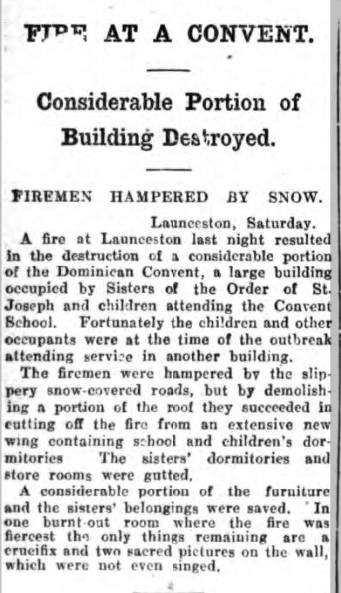
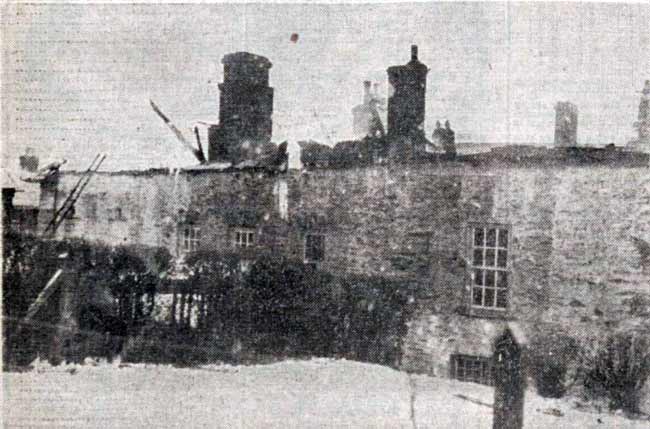

The Post, January 29, 1927: £5,000 DAMAGE AT LIFTON.
In the early hours of Saturday morning a fire was discovered in the three-storey flour mill, the property of Mr S Cole, opposite Lifton Railway Station, and so fiercely did it burn, that in a very short space of time the roof fell in and the whole place was gutted. The photograph shows the building as it was on Monday morning; the huge quantities of grain which the building contained were still burning.
People living quite close to the premises did not notice the fire until their attention was called to it. It appears that Mrs S T Lane, about 1.15 am., noticed a smell of smoke and she roused Mr Lane, who in turn called Mr Williams and Mr Martin. They discovered that the mill was on fire and called Mr Cole, the owner. There was soon a general stir, and efforts were at once made by the many willing helpers who congregated to prevent the fire spreading to a bakery and shop, and the stables at the back. Mr F O Morris (of the Ambrosia Milk Factory) telephoned to Launceston for the Fire Brigade, and loaned two hoses, which were at once connected up to the water supply to the house and shop. A motor car was procured at Launceston and several of the members of the Fire Brigade, with some equipment, arrived within half-an-hour and rendered assistance, the engine arriving about two hours later. The delay in getting the engine out is easily understood. Horses had to be procured from Messrs Smith’s stables, and a blacksmith called to “frost” them, owing to the slippery state of the roads, which was so bad that they had to be led a great part of the way.
The fire burned so fiercely that the roof fell in in about three-quarters of an hour, and it was impossible to attempt to save the contents of the building. The machinery included the flour mill, barley stones, crusher, wheat cleaner and engine, a 4 – ton Thornycroft motor lorry, and about £1,500 worth of grain, the total loss being from £5,000 to £6,000. Fortunately it is covered by insurance.
The employees, Police Sergeant Barnacott, PC Davis, and others worked with a will and removed everything in the shop and bakery in the event of the fire spreading, and Mr Martin released the horse from the stable. Fortunately the equipment of the Fire Brigade included an adapter by which means the Brigade were able to make use of the fire hydrant near the spot, and the engine pumped water through two hoses from the leat about 700 to 800 feet away. Water was played on the burning mass for many hours until there was no possibility of the fire spreading, although the huge quantity of grain in the building went on smouldering for some days. Eventually nothing but a tangled mass of machinery, wheat and debris remained inside the four bare walls.
The cause of the outbreak is a mystery, the only reason that can be suggested being that possibly a bearing of the machinery became overheated. Local sympathy is extended to Mr Cole in his loss of business and property.
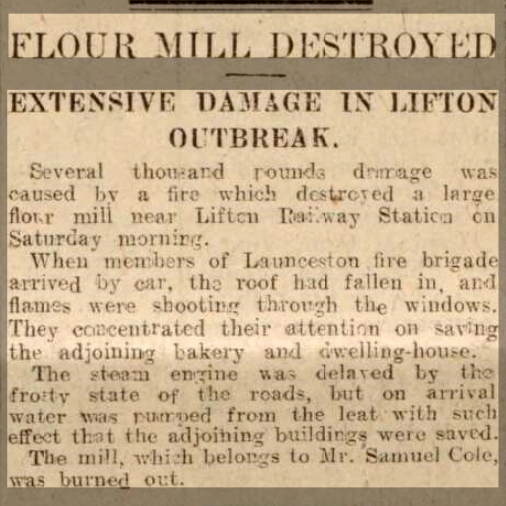
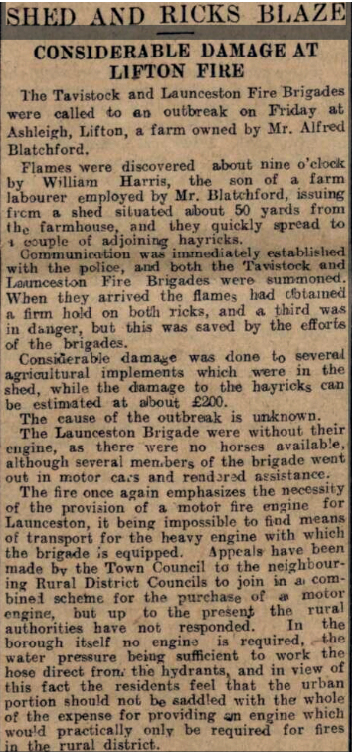
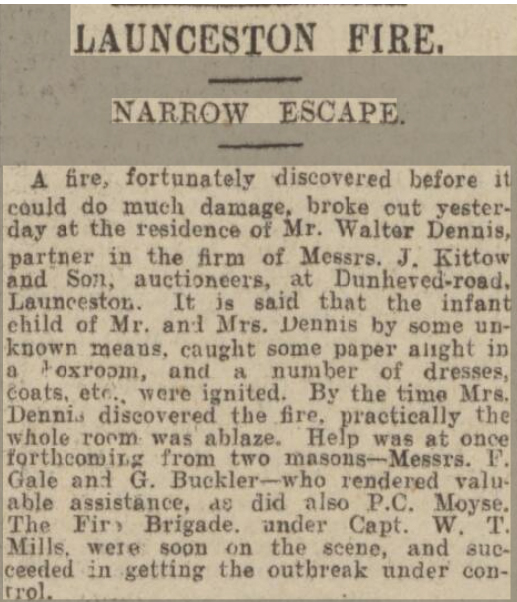
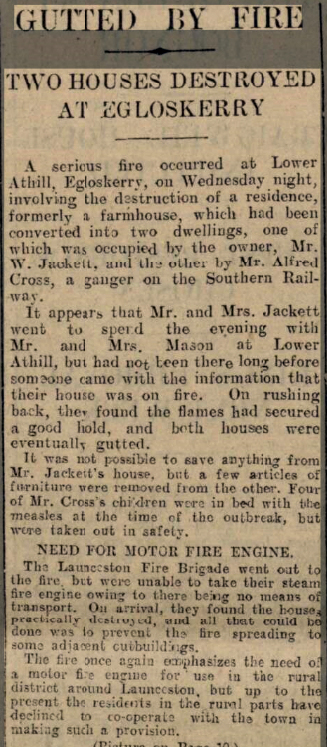
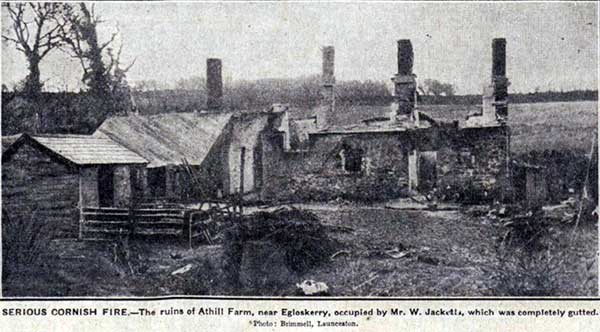
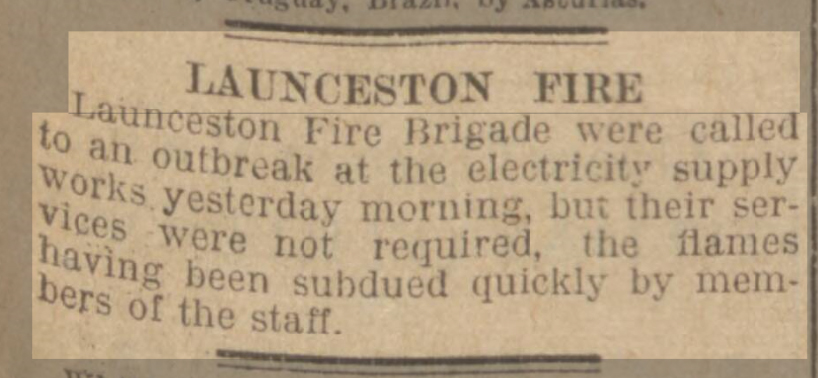
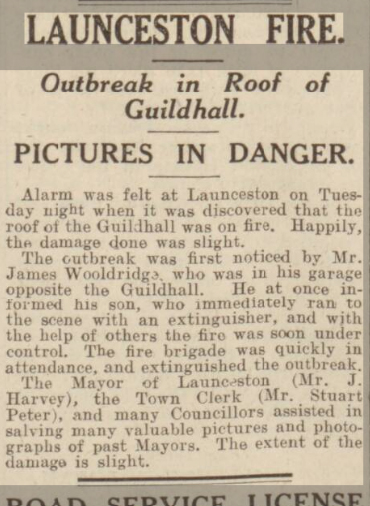
Post & Weekly News, 22 October, 1932: LAUNCESTON’S BIG FIRE
THREE-STOREY BUILDING GUTTED. DAMAGE OF £3,000 TO £4,000.
The ringing of the fire bell from the tower of St Mary’s church, Launceston, on Friday, brought hundreds of residents of the town to the scene of the fire, which threatened to be one of the most disastrous in the history of this ancient borough. The building in which the fire broke out was the large three-storey one at the junction of Broad Street with Church Street, formerly the site of Lloyd’s Bank, but for some time occupied on the ground floor as a cafe, the proprietor being Mrs Wilcocks, of Saltash. On the floor above were offices and above that a flat, which at the time of the outbreak, was unoccupied, but which was to be engaged the following day.
It was about eight o’clock in the evening, and the weather was such that most of the residents had retired to their homes or other places of shelter. Judging by all accounts the signs of fire were first noticed by Mrs Meager, who at once sent out the signal, and very soon the streets were thronged with excited spectators. So quickly did the fire obtain a hold on the building that the residents were in great fear of what the results would be. From the windows of the upper portion of the building thick smoke issued, and soon the seat of the fire could only with difficulty be reached by reason of the fumes. The Launceston Fire Brigade were quickly on the scene, by which time flames were leaping from the top of the roof and the windows of the building. The way in which the Brigade got to work, however, has brought forth many remarks of commendation from residents, for many of the men fought the fire with hose pipes from very dangerous positions. Despite the great efforts of the Brigade, the flames seemed to hold the upper hand, and, spreading across the roof, endangered the premises of Mr T Smale’s boot shop.
As one time the situation looked so dangerous that the Tavistock Fire Brigade were sent for. The Captain of the Launceston Brigade has since told our reporter that although he and his men were quite convinced that they could master the situation, they thought that by calling in the help of Tavistock they were adopting a safety measure and also to a certain extent relieving the anxiety of the residents. It was evident that there was little hope of saving the building, but as there are business premises and offices on both sides, the firemen directed their efforts to confining the outbreak to one building. Eventually the roof crashed through the floor and the flames spread. Meanwhile those concerned with the adjoining premises engaged themselves in carrying valuable contents of their shops and offices to places of safety.
The crowd showed admiration for the daring manner in which Mr G Adams climbed a ladder to the top of the building and played water on the spreading flames. In spite of the blinding smoke which at times caused the people below to move away, he stuck to his post, whilst other members of the Brigade also climbed ladders and fought the flames through windows. The Launceston fire engine was pulled into the Square by twenty or thirty people, but was not made use of.
By about ten o’clock the firemen obtained a firm hold on the flames, and although the Tavistock Brigade showed great promptitude in arriving, their services were not needed. Had the wind been blowing in the opposite direction no doubt the other buildings, which are much older, would have quickly caught and the results would have been disastrous. The damage done to the building is very extensive, and a “Post & news” reporter was informed by Mr C A S Hall, of Messrs Harris & Co .Ltd., Exeter, who is Mrs Wilcocks’ assessor, that the extent of the damage ranges between three and four thousand pounds. He considered that the fire was greatly aided by the large amount of pitch pine which was used in the structure.
The cause of the outbreak is unknown. The top and the second storey are almost gutted and the confectionery and other commodities of the cafe completely ruined by the fire and water. The office of the tax collector was also damaged.
Post & Weekly News, 22 April, 1933. BIG FIRE NEAR LIFTON.
Farm and outbuildings gutted: sparks from chimney catch roof.
A disastrous fire which broke out at Five Acres Farm, Lifton, on Wednesday morning completely gutted the farm house and a barn. The house, which is one of the oldest farm houses in the district, is the residence of Mr and Mrs L Kneebone. The building consists of the dwelling house and a barn, which are both under the same roof; one part of the house has been rebuilt and is of red brick.
The fire broke out about 8.30 and was first noticed in the thatch roof. Mr Kneebone at once went to Lifton, where he telephoned to the Tavistock and Launceston Fire Brigades. There was only a small blaze when first noticed, but after half-an-hour, when Mr Kneebone returned, the fire had obtained a firm hold on the barn, and was spreading rapidly towards the dwelling house. With the help of people from adjoining farms, under the direction of Sgt Derges, and PC Godfrey, the furniture in the downstair rooms was practically all removed, together with a steel safe and valuable papers. All the live-stock were promptly removed and fortunately none was destroyed. Efforts were made to save the contents of the bed rooms, but although some valuables were saved, the smoke gradually became too great an obstacle, and the efforts of Mr L Kneebone, and his brother Mr A Kneebone, had to be abandoned.
A stiff breeze which was blowing fanned the flames to a fury and the thatch, which was old and dry, soon fell through. The barn contained about a ton of artificial manure and when the thatch fell through a great blaze was set up. Very soon the heat became too great for anyone to get near. The Fire Brigade arrived from Tavistock about 9.20, but by that time the fire had a firm hold on the dwelling house and all the furniture not removed was burnt.
Difficulty was found in obtaining water owing to the length of drought. The only water obtainable was from a stream at the bottom of a field, and although it was damned up, it was not enough to keep the supply going for more than about fifteen minutes at a time. Owing to the steepness of the field, it was only with difficulty and a certain amount of danger that the engine was able to proceed to the water.
Great attempts were made to check the flames, but the buildings were almost gutted before the firemen could commence their work. Fortunately the wind was blowing the flames away from the other buildings, but every precaution was taken and the live-stock were all turned into fields. Mrs L T Kneebone to a “Post & Weekly News” reporter that she was frying breakfast about 8.15. To the kitchen fire there was no chimney, but only an iron pipe, and she though that some sparks must have gone on the thatch roof. When her husband came in to breakfast he told her the roof was on fire. So rapidly did the flames spread that the buildings were gutted in less than an hour.

The Post & Weekly News, Saturday, July 14, 1934: LIFTON’S BIG FIRE.
THE WHOLE VILLAGE ENDANGERED. FIRE FIGHTERS BATTLE FOR THREE HOURS.
Shop and Dwelling House Burnt to the Ground. (by our own Representative)
Seldom, perhaps never, in the history of Lifton has the pretty little village been in such grave peril as it was on Monday, when what threatened to be a most disastrous fire broke out. The fire first caught a thatched roof covering the dwelling house and general stores of Mr and Mrs J Brimmacombe, situated in Fore Street, and to such an extent did the flames obtain a hold, fanned by a stiff breeze, that the Arundell Arms on one side and the dwelling house of Mr P Ellacott on the other were in great danger. Three Fire Brigades were called – Launceston, Tavistock, and Okehampton – and their combined efforts averted damage, the extent of which can scarcely be imagined.
The first alarm was given by a school boy, Master Fred Jones, who, when visiting the shop, calmly remarked, “There’s a fire on top of your roof.” Little did he think, perhaps, that what he had seen was a preliminary to a fire which endangered the homes of a large number of the inhabitants. The alarm soon spread, and the cries of “Fire!” And the smell of smoke brought many to the scene. The fire, which commenced on the lower side of the thatched roof, spread until inside of five minutes it was a mass of flame. The Lifton police, Sergt Burroughs and PC Godfrey, with great promptitude, arrived, and from then until the danger was subdued, they played a great part in fighting the flames. PC Coombe, of Boyton, and PC Pollard, of Milton Abbot, also rendered great assistance.
SCHOOL CHILDREN ASSIST. A large number gathered, and although helpless as far as putting out the flames was concerned, they dashed into the building to save all the furniture and articles possible from the shop. So well did they work that practically everything, including a fairly large stock from the shop was brought out. At considerable risk the bedrooms were ransacked, and although many plucky rescuers were almost overcome by smoke and fumes, they succeeded in their object of clearing the house, although some of the furniture was damaged in the efforts. School children joined with the adults, and played a great part in the work. After fifteen minutes it was evident that there was no hope of saving the building, but the Arundell Arms, that hotel of which Lifton is so proud, stood in great danger, especially as the wind was blowing the flames towards it. It seemed, however, that there was nothing to do but to stand back and wait the arrival of a fire brigade, and hope that the flames would not reach the buildings on either side. Minute by minute the position was getting more serious, and it was expected that flames would be seen issuing from the building on the lower side, which would more than likely mean the destruction of practically the whole side of the street.
AMBROSIA EMPLOYEES’ GALLANT EFFORTS. Shortly after one o’clock the employees of Messrs Ambrosia Ltd dashed to the scene with their large hose pipe. This brought a little relief to the almost panic-stricken villagers, but little did they think this band of amateur fire-fighters were going to play such an important part in averting much more serious destruction. Their hose was connected to the village water supply, but unfortunately there was not sufficient force of water to be effective on the top of the roof. Ladders were placed against the wall, and climbing to the top men played their hoses on the burning thatch nearest the endangered Arundell Hotel. Their efforts were worthy of the highest commendation. With great determination and pluck they worked from the top of the ladders amidst suffocating smoke and a blistering heat, until, practically overcome by smoke, they had to leave their posts for other members of the staff.
After strenuous efforts it seemed that the danger to the hotel was overcome and efforts were concentrated on the other side of the building. The large number of spectators who lined the streets watched with breathless anxiety the heroic battle, the shortage of water giving the fire a great advantage. Everyone who was able played a part, chief amongst them being Mr Ralph Arundell, who, in spite of his increasing years scaled the top of the ladder, and set an example which the villagers were not slow to follow.
THREE FIRE BRIGADES. By this time it was fully expected that the adjoining house of Mr Ellacott’s would be the next victim, and all possible articles of furniture were removed. At 1.30 the Launceston Fire Brigade arrived, and in spite of their great handicap of being without a fire engine they proved of great assistance to the almost exhausted Ambrosia employees. The thatch on a building at the back of the rapidly burning premises, which had up to recently been used as a slaughter-house, was the next to catch alight, and flames commenced to spread rapidly. Attention was drawn to this, but almost immediately the roof of the dwelling-house and shop collapsed, sending the flames many feet into the air. By this time the Fire Brigades from Okehampton and Tavistock had supplemented the forces of the fighters. Their engines pumped water from the river at Tinhay Bridge and Leat, and fortunately a good supply was kept going. There was now no possibility of the disused slaughter-house being saved, and anxiety was felt regarding the ancient cock pit, an octagonal building with a thatched roof, one of the few relics left in the country of the cock-fighting days. The contents of this building were quickly cleared, but whilst the workers laboured at full speed the roof caught, and within ten minutes the top collapsed. Fortunately the walls were saved, and it is possible that the valuable structure will still be preserved.
In spite of the great attempts being made to save the Hotel the fire was still keeping its hold, and the position looked extremely dangerous. Frantically the Hotel staff worked, and they were assisted by many of the guests, who formed a chain to carry water to the danger spots. Part of the commodities on one side of the Hotel were placed ready to be moved, and all carpets were taken up. No less was the anxiety felt on the village side, and it was extremely fortunate that the wind was not blowing in the opposite direction. As it was the fire found its way through, but the splendid efforts of the Fire Brigades prevented it spreading, and damage, although serious in itself, is comparatively small.
ARUNDEL ARMS HOTEL INVOLVED. Then came the alarming cry, “The Hotel has caught.” Firemen and their many helpers dashed up the stairs and were met by clouds of smoke. In a fairly large cupboard the fire was blazing away. The heat could be felt and the smoke was almost blinding, but the men stuck to their posts, and almost as quickly as the fire had taken its hold, water was being thrown on to it, and it was subdued. This proved a great relief, for not only was the valuable Hotel at stake, but the adjoining Police Station and Schools which were in line of fire.
THREE MEN INJURED. In the midst of this excitement, two employees of Messrs Ambrosia Ltd., were hit by falling slates. The first, Mr Barrett, had to be taken to Dr Nockolds, and soon after Mr George Crossman had to be attended to by the Launceston Ambulance, and then taken to the Doctor, where several stitches had to be inserted. We are now able to state that fortunately neither accident was of a serious nature. Mr Ted Sage, of Messrs Ambrosia Ltd., collapsed when he returned to the works, and had to be treated by the members of the Launceston Ambulance and conveyed home.
After about 2.20 it could be seen that the fire-fighters were getting a real grip on the situation, and great relief was felt. By three o’clock it was practically certain that the flames were beaten by plucky and skillful opponents. From the time the fire started until after 7 o’clock all the main road traffic was held up, and was diverted to the by-road entrance, where big lorries had much difficulty in proceeding.
At about 4 o’clock, after about three-and-a-half hours of acute anxiety, the residents of Lifton breathed almost normally again, although the possibilities of a renewed outbreak were not beyond question. The Fire Brigades, however, were leaving no stone unturned, and they worked on the smouldering debris for a considerable time, and did not leave until a late hour. After that there were night watchmen from the Hotel, who remained on duty until the following morning, accompanied by a few firemen.
THEORY AS TO OUTBREAK. The cause of the outbreak is unknown, but a theory is that a spark from a steam engine which went up through the village about five minutes before the fire was noticed, caught the thatch. Some school children are said to have seen sparks flying from the funnel of the engine, and it is understood that the police are anxious to trace the locomotive.
Mr J Brimmacombe told our representative that he was in the sitting room of his dwelling house, reading, when he heard the engine pass up. It was a familiar engine, he thought, but he would not say that that was the cause of the trouble. Mr F O Morris, proprietor of the Hotel, was away from home at the time, but he was made acquainted with the fire and the danger to the building by ‘phone, and he at once returned, arriving about 2.30 pm. We understand that the property involved was insured.
Some of the older inhabitants of Lifton will remember a serious fire in the opposite building, now the Post Office, at that time a shop containing much oil and chemicals, the property of a Mr Prout.
An amusing story is told of the helpers, who, endeavouring to save the bottles and their contents, they threw them from the shop window to the road below, where they were, of course, smashed.
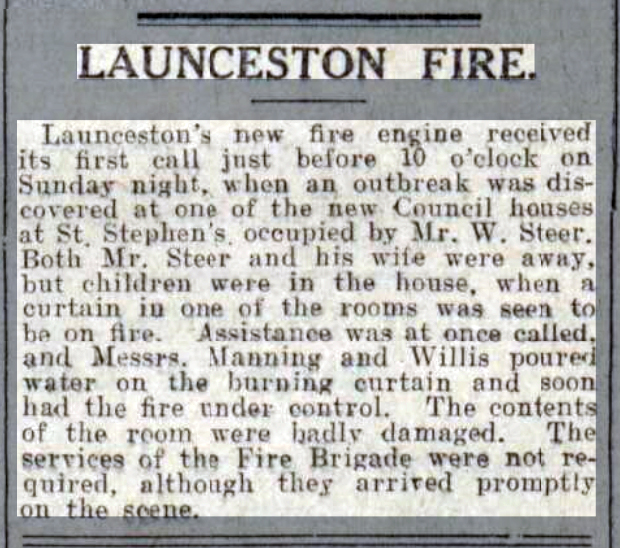

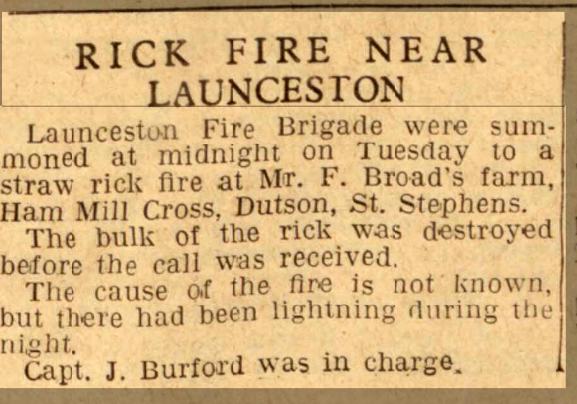
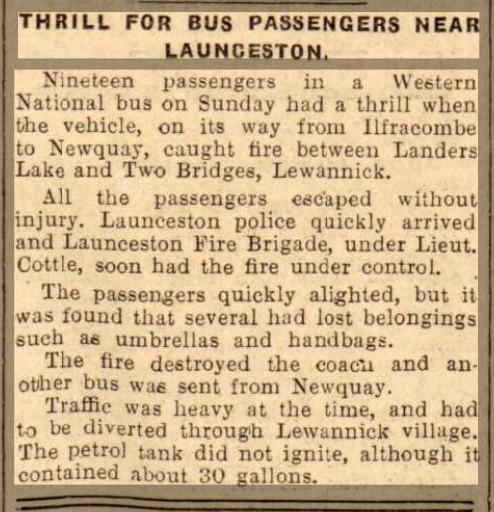
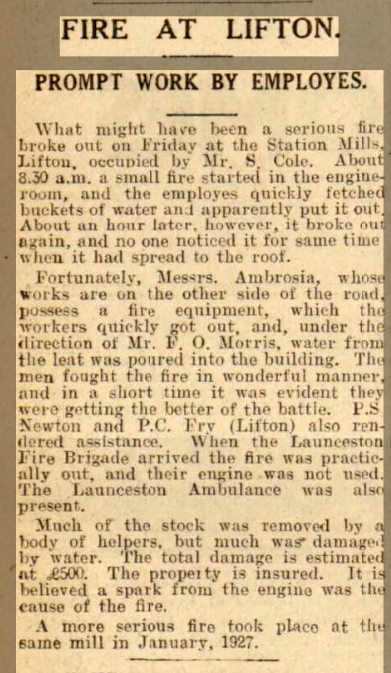
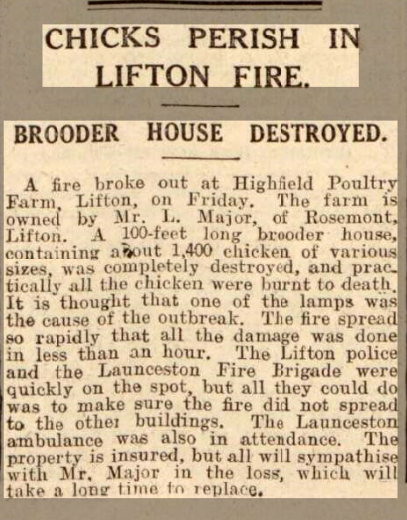
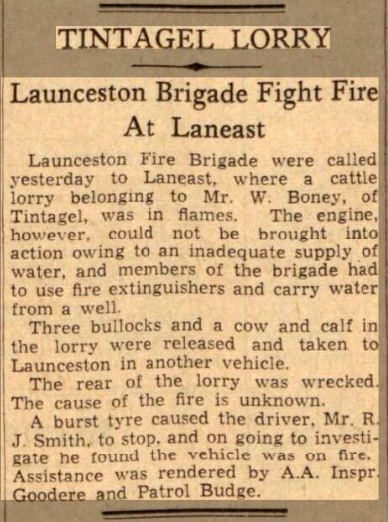
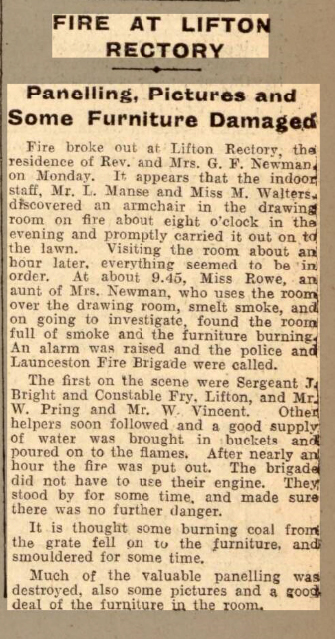
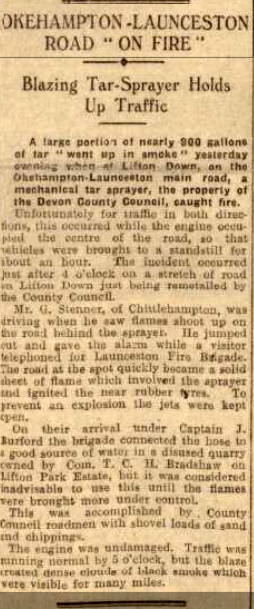
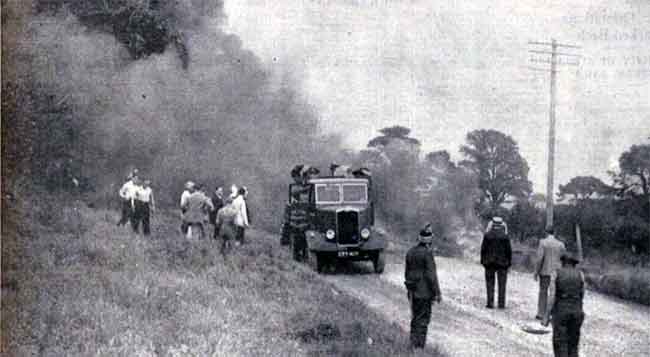
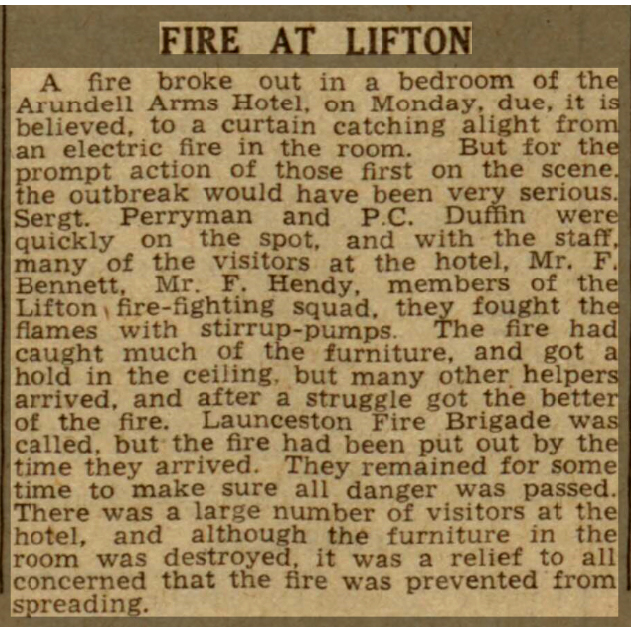
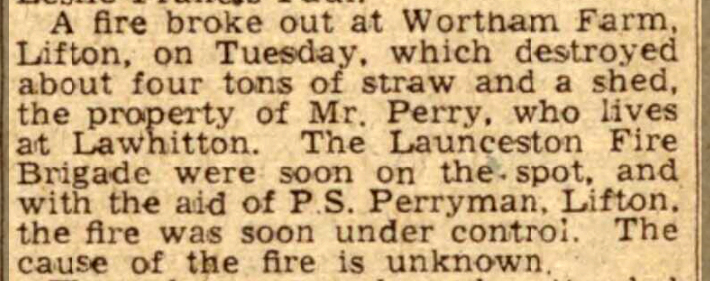
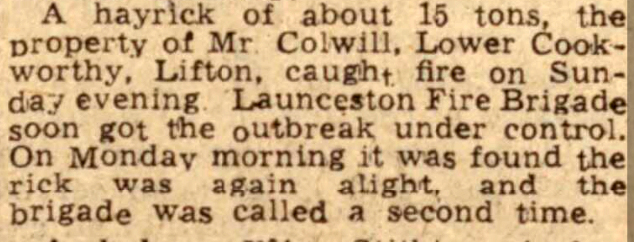
RICK FIRE AT SOUTH PETHERWIN.
A destructive fire occurred at Trevozah Barton, South Petherwin, owned by Mr C Gillbard, Wednesday, whilst barley was being put into a rick. A lorry had just unloaded and was about to move away to make room for another, when a spark from the lorry started a fire in the rick. The outbreak spread so rapidly that those engaged on the top of the rick scarcely had time to reach the ground before the rick was enveloped in flames. With buckets of water those on the spot were able, prior to the arrival of the National Fire Brigade, to prevent the fire spreading to baled hay.
P & WN, 9th September, 1944. OUTBREAK OF FIRE.
Between £3,000 and £4,000 Damage at Launceston: Damages estimated at between £3,000 and £4,000 has been done as a result of fire which broke out in a store at the rear of the White Hart Hotel, Launceston, and occupied by Messrs Reckitts, the well-known wholesalers, and in which the hotel, garage, and the Post Office might easily have been involved.
About 2.15 pm on Tuesday smoke was noticed coming from the store, and as soon as the doors were opened it was found that that part of the building was enveloped in flames. The National Fire Service were immediately summoned and were quickly on the scene, In the meantime, members of the Post Office staff, hotel guests and staff, and several willing helpers from the general public, worked hard with the Post Office hose, and with buckets of water, to prevent the fire from spreading to the hotel, garage and Post Office.
The National Fire Service men and pump from the Launceston Station were quickly on the scene and got to work with two lines of hose, one from the reservoir near the Memorial in the Square, and the other from the hydrant in Madford Lane, and were able to tackle the outbreak from two sides. In less than a quarter of an hour they had established very satisfactory fire “breaks.”
Fighting the fire in that manner undoubtedly prevented a very serious situation developing. The store occupied by Reckitts, and four staff bedrooms and bathroom were gutted. Fortunately, most of the stock in the store was salvaged. To our representative, Mr E Miller spoke in high praise and appreciation of the very prompt services rendered by the local N F S, and members of the Post Office staff, Police and the general public, and also for the very efficient manner in which they had dealt with the situation. In addition to the local N F S, the N F S from Liskeard also attended, but their services were not required as the outbreak was under control before their arrival. The cause of the outbreak is unknown.
April 6th, 1946: FARM FIRE AT TRESMEER: Three Ricks Destroyed.
Nearly sixty lengths of hose – nearly three thousand feet – and an extra pump were required to provide an adequate supply by the Launceston Fire Brigade in order to fight a fire which broke out on Mr Kittow’s farm at Tresmeer, near Launceston, on Monday. The Brigade made a prompt response to the call.
In the yard were four ricks – two of straw, one of wood, and one of unthreshed corn. In the yard adjoining were the outbuildings and two Dutch barns. Stirrup pumps were used to keep the outbuildings and ricks from catching fire, and through these means they were certainly saved. The Brigade was also assisted by the wind blowing away from them. However, the two straw ricks and the wood rick were destroyed, and a part of the corn rick was saved by cutting around with knives. Liskeard Fire Brigade arrived, but there services were not required. The Mobile Canteen from Bodmin were also in attendance. The Launceston Fire Brigade arrived home about Nine pm.
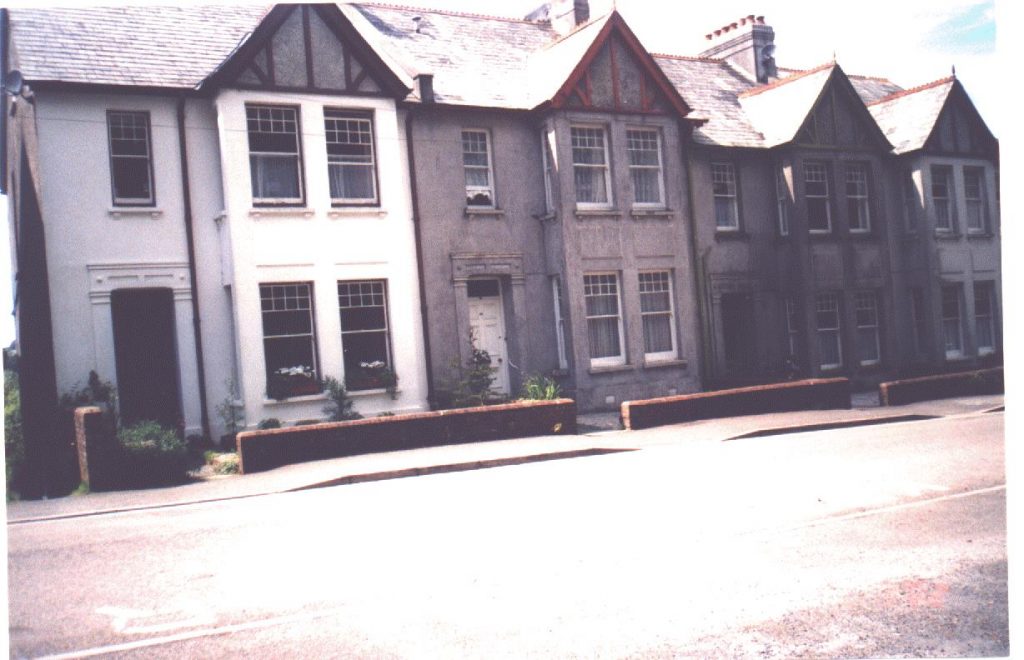
Cornish & Devon Post, 1st March, 1947: ON A FROZEN ROOF: Firemen’s Successful Fight.
Launceston Outbreak of Fire:- For over three hours Launceston Fire Brigade, under Section Leader P J Lampey, fought successfully on a frozen roof to prevent a fire from spreading to the other houses in the block, when a sudden outbreak occurred at ‘Pentor’, Dunheved Road, Launceston, the residence of Mrs F M Cook, on Monday evening.
The Brigade with its usual promptness, arrived on the scene within three minutes of receiving the call at 9.35. They found the roof of the house well alight and the staircase on the second floor enveloped in flames. A second pump was called, and was soon in attendance. The difficulties were added to by the extremely cold weather, the water from the hoses freezing as it was played on to the roof, making the roof very slippery and dangerous for the men, but they succeeded in preventing the fire spreading to the adjoining house. The Police, under Supt W H Millett, were in attendance, and many willing volunteers helped to save some of the furniture in the down stair rooms, Mr Stewart Fitze bringing along his van to take it away for storage. In addition to the furniture damaged by fire in the bedroom, that in other rooms naturally suffered damage by water which came through the ceilings to the basement. The roof, the top floor, and the staircase leading to it were completely destroyed. Three other pumps from Bodmin, Saltash, and Tavistock also arrived, but their services were not required. Fire Force Drury (Plymouth), and Divisional Officer Murden (Bodmin) were also present.
It is understood the outbreak originated in the attic.

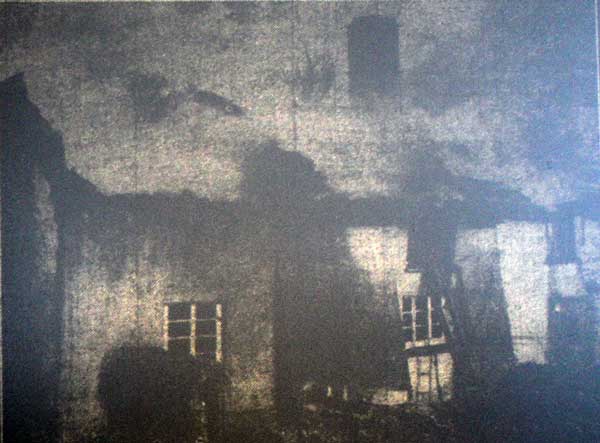
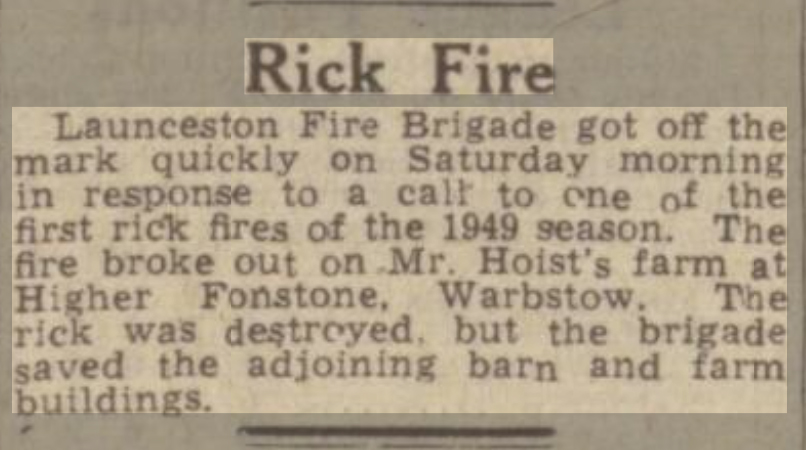
Post & News, 10 April, 1954: LAUNCESTON FIRE: In Boiler House of Wesleyan Church.
Launceston Firemen, under their Leader, Station Officer W Vague, fought for nearly four hours on Saturday night and early Sunday morning, a fire which had broken out in the boiler house of the Wesleyan Methodist Church, Launceston. They were on the scene of the outbreak in less than five minutes of receiving the call.
It appears that about 11 pm on the Saturday, the caretakers of the church (Mr and Mrs R Searle) discovered that about a lorry load of timber. Which had been stored in the boiler house, was ablaze and had set alight about thirty hundredweights of coke. The heat was so intense that the firemen were unable to enter the boiler house for about an hour after their arrival and were compelled to fight the flames from the top of the boiler house.
Some railings, about six feet from the boiler house door, also felt the force of the heat. When the firemen eventually entered the scene of the outbreak they had to wear asbestos gloves and aprons. They succeeded in confining the fire to the boiler house and the usual church services were held on Sunday. In fighting the flames before the arrival of the Brigade, Mrs Searle received burns to her face, while Mr Searle collapsed from the heat, but soon recovered. After the flames were extinguished the firemen had to wade waist deep in water in the boiler house to pump out several thousand gallons of water. Valuable assistance was also given by PC’s Powel and Jordan of the Launceston Police.
Divisional Officer P Haynes, of Bodmin, was also in attendance. The boiler was considerably damaged and the timber was destroyed.
Post & Weekly News, 12 April, 1958:
THEIR HEROISM IS RECOGNISED: four boys awarded certificates.
Four Launceston boys, three of the age of ten years, and the other a year younger, were presented with framed certificates in recognition of their heroism and prompt action in a fire at Launceston last November.
In asking Mr E R Barriball (chairman of the Launceston Borough magistrates) to make the presentation, Inspector CP Cole, of the Cornwall Constabulary, stationed at Launceston, said it was his privilege to bring to his (Mr Barriball’s) notice as chairman of the magistrates, the meritorious conduct of the four boys.
They were William John Clifton, Tor View House, Tower Street, Anthony Charles Dixon, 4 Tower Street, Launceston, Christopher David Woodward, 24 Broad Street, Launceston, and Terrance Robert Hawkins, also of Tower Street.
The circumstances were, that at about 12.20 pm on 20th November, 1957, the boys were returning home from the National School. On going up Tower Street, the boy Clifton saw that there was a fire in the downstairs room of 45 Tower Street, which is occupied by Mr and Mrs Wadland and their two little children. It was seen that the room was filled with smoke. Clifton told the other boys of this and Woodward placed bicycle beneath the window and used it as a step to look inside. At this stage Dixon looked around and saw a Mr Wheeler coming up the street and they shouted to him. Mr Wheeler was carrying a load at the time and he shouted to the boys to go in through the front door. The boys opened the door, went into the house, and entered the smoke-filled room where they saw the two small Wadland children.
One boy carried out the smaller child, and the other child was led out by the other boys, and thus they prevented any harm or serious injury befalling the two young children. There was no doubt that their prompt action resulted in the fire being detected and got under control without harm or injury to the two young children. The Chief Constable of Cornwall was made aware of the meritorious conduct of the lads and saw fit to bring it to the notice of the Society for the Protection of Life from Fire, who had rewarded the lads with a framed certificate.
Making the presentation, Mr Barriball said he was pleased and delighted to see the lads there that day. The townspeople and their parents were very proud of them on doing a fine job of work. They heard a lot today about boys and youths which was not always good, but their bravery had filled the townspeople with pride. He hoped they would grow up to be useful citizens. They had started right. The certificates were something they could feel proud of all their lives.
On behalf of the Launceston Unit of the Cornwall Fire Service, Station Office W Vague added his tribute and commendation. The ceremony at the Guildhall Committee Room was watched by the lads parents and their schoolmaster (Mr W H Kinsman).
Post & Weekly News, 3 January, 1959: EGLOSKERRY FIRE. Airing Cupboard and Contents Destroyed.
When Mrs HL Glass went to the kitchen of her home at Slipper Hill, Egloskerry, on Wednesday morning, she discovered that her airing cupboard, which contained a quantity of clothes, was on fire.
She immediately summoned the Launceston Unit of the Cornwall Fire Service, who, on their prompt arrival under Station Officer W Vague, found that the top of the airing cupboard and ceiling were well alight. They soon had the outbreak under control, but they were unable to prevent the airing cupboard and its contents from being destroyed. There was slight damage to the kitchen.
Post & Weekly News, 18 April, 1959.
EARLY MORNING BLAZE AT LAUNCESTON: Chicken Perish As Shed Is Destroyed.
Flames from a shed behind the home of Mr G H Hocking at 11, Dutson Road, Launceston, were spotted by the night duty policeman, PC Tonkins, at 3.30 on Thursday morning. He roused Mr Hocking and they telephoned the Fire Brigade, in the meantime tackling the blaze with a garden hose and saving fowls from nearby wooden buildings. Mr Hocking is a noted poultry fancier, and the shed which caught fire contained three brooders and fifty young chicken, as well as an incubator with one hundred and twenty eggs, some tools and a quantity of corn, all these contents being destroyed by the fire, which blazed brightly in the night, being spotted by early risers and non-sleepers across the valley in the town and also in St Stephens.
The Launceston Unit of the County Fire Service arrived at 4.05 am but were handicapped at first by lack of water from the road hydrant, which was at a considerably lower level than the seat of the fire. When water was available, they soon brought the blaze under control, and it was confined to the one shed, a wood and galvanise erection. That building was totally destroyed. The Brigade were under the control of Station Officer W Vague.
Post & Weekly News, 11 July, 1959.
GRASS BLAZES KEEP FIREMEN BUSY. FIRE BRIGADE’S THREE CALLS.
Launceston Fire Brigade were called to a road-side blaze, between Truscott and Egloskerry, on Tuesday morning. The wastrel blaze was threatening a nearby hay-rick belonging to Mr Francis Harris, of Atway, but the Brigade were able to extinguish it before any damage was done. With the prolonged dry weather, the grass was “like tinder,” in the words of one fireman, and the blaze was running along the ground literally “like wildfire.” The Brigade was in charge of Leading Fireman G Steer.
On Wednesday, Launceston Unit of the County Fire Service received two calls. At Compass a field of grass belonging to Mr Smith, of Berrydown, had become ignited and half an acre of grass was destroyed. The firemen put out the blaze by means of water and fire beaters and prevented the flames from spreading to a nearby garage and its contents. The Brigade was in charge of Sub-Officer S Hosken.
In the afternoon they were summoned to an outbreak at Langore, where a hedge of 200 square yards had been set alight. Here again the outbreak was put out by means of beaters and water, with Fireman S Martin in control. When fire spread along the railway embankment on Tuesday, and threatened his field of corn, Mr JCM Booth, of West Dowerland Farm, Okehampton, called Okehampton Unit of the County Fire Service. The outbreak was extinguished within fifteen minutes. About three hundred yards of embankment were burnt.
Post & Weekly News, 3rd March, 1962. BUSY DAY FOR LAUNCESTON FIREMEN.
Spate of Calls After Early-morning Barn Fire. Sow and Litter Burned To Death at South Petherwin.
Launceston Firemen had a record time on Sunday in answering no less than four calls to outbreaks with the result that they were practically on duty all day. Some wore pyjamas under their uniforms, hurriedly put on after an early morning call, in which the usual Sunday lie-on was disturbed. The summons was to a barn fire at Larrick, Trewarlet, South Petherwin, near Launceston, the residence of Mr K Tucker. In the barn was a sow with two farrows, born only two days previously. The sow was so badly burned that it had to be destroyed, while the two farrows were burnt to death.
The barn was practically un-damaged, but the firemen, under Sub-Officer G H Steer, were able to prevent the flames from spreading to an adjoining barn, which contained among other implements 20 gallons of paraffin. It is believed the outbreak was caused by infra-red pig lamps of an oil type.
Divisional Officer Hitchcock was also present, while Inspector HH Lee, of the RSPCA., was in attendance. The firemen were on duty for two-and-a-half to three hours.
They had barely returned to their homes, when the siren again called them to a chimney fire at Woodvale Terrace, Race Hill. Their mid-day meal was also interfered with, for in the early afternoon, they were again called to duty for an eight-acre gorse fire at Piper’s Pool, where for another two hours they were occupied in quelling the flames.
This was not the end, for within minutes of their arrival home, they had to go over the border in Devon, to re-inforce the Tavistock Brigade in combating an outbreak in Coryton Woods. Here, too, they were occupied for another two hours. So it can be surely said that the Launceston firemen were on duty for some ten hours.
Sub-Officer GH Steer was in charge of all the fires.
On Saturday evening, the firemen were called to a fire in St Thomas Road, where a motor cycle had become ignited as a result of an accident. The motor cycle rider was Mr D Sillifant, of Milton Abbot, who sustained a compound fracture of the lower part of the leg. After receiving attention at Launceston hospital, Mr Sillifant was conveyed to a Plymouth hospital by the Launceston Division of the St John Ambulance Brigade. The machine was totally wrecked. Sub-Officer L R Olver was in charge of the Fire Brigade.

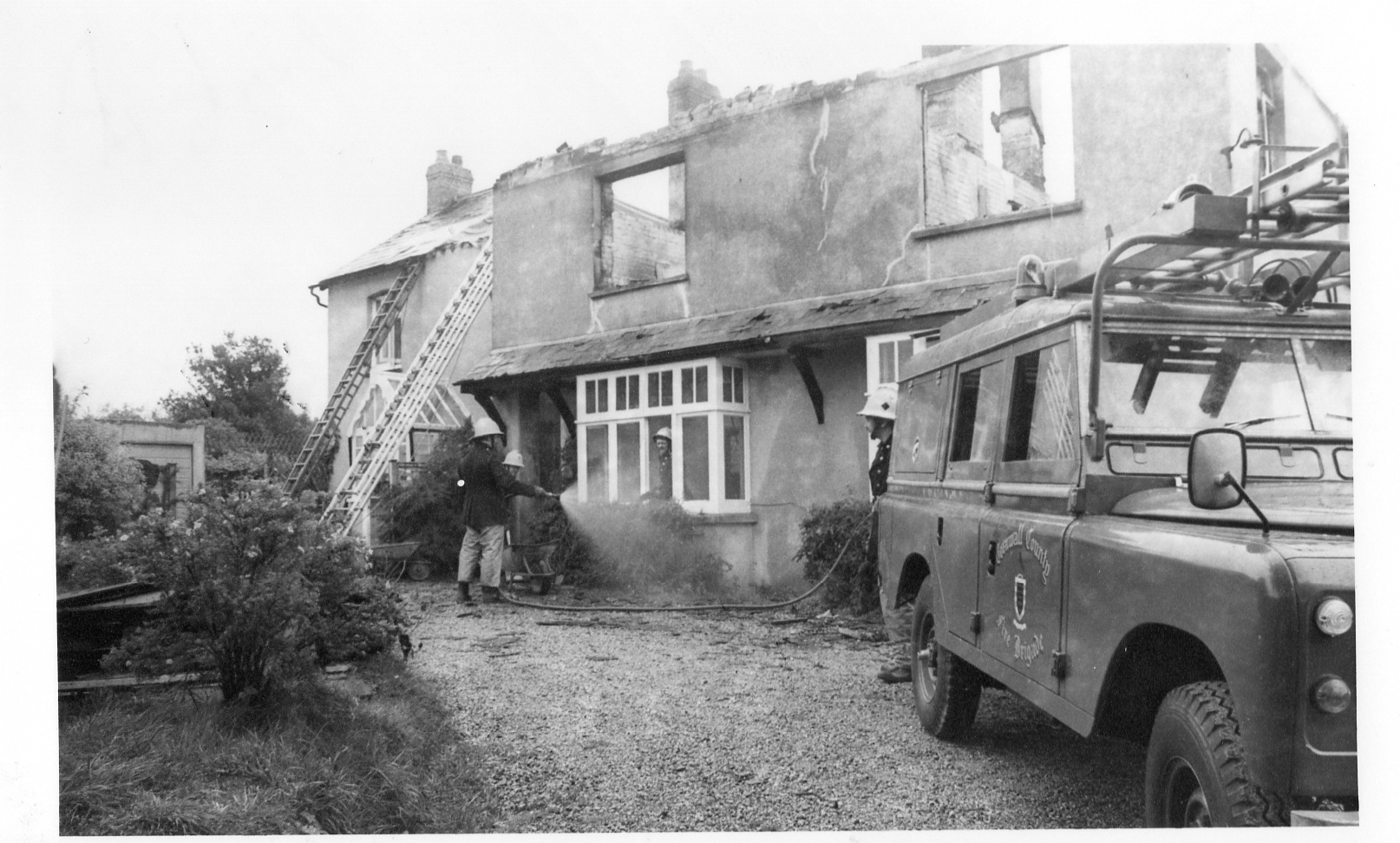

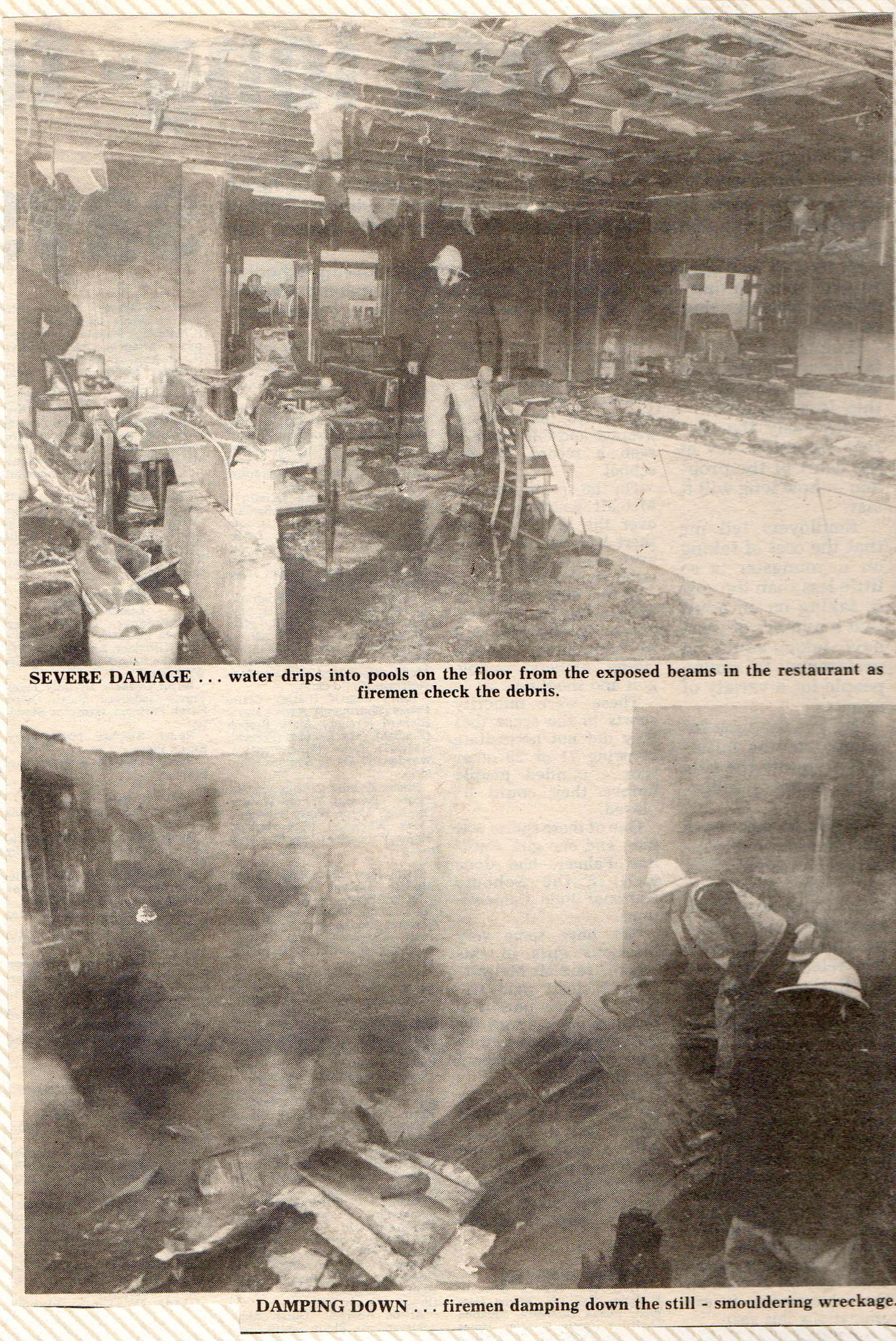
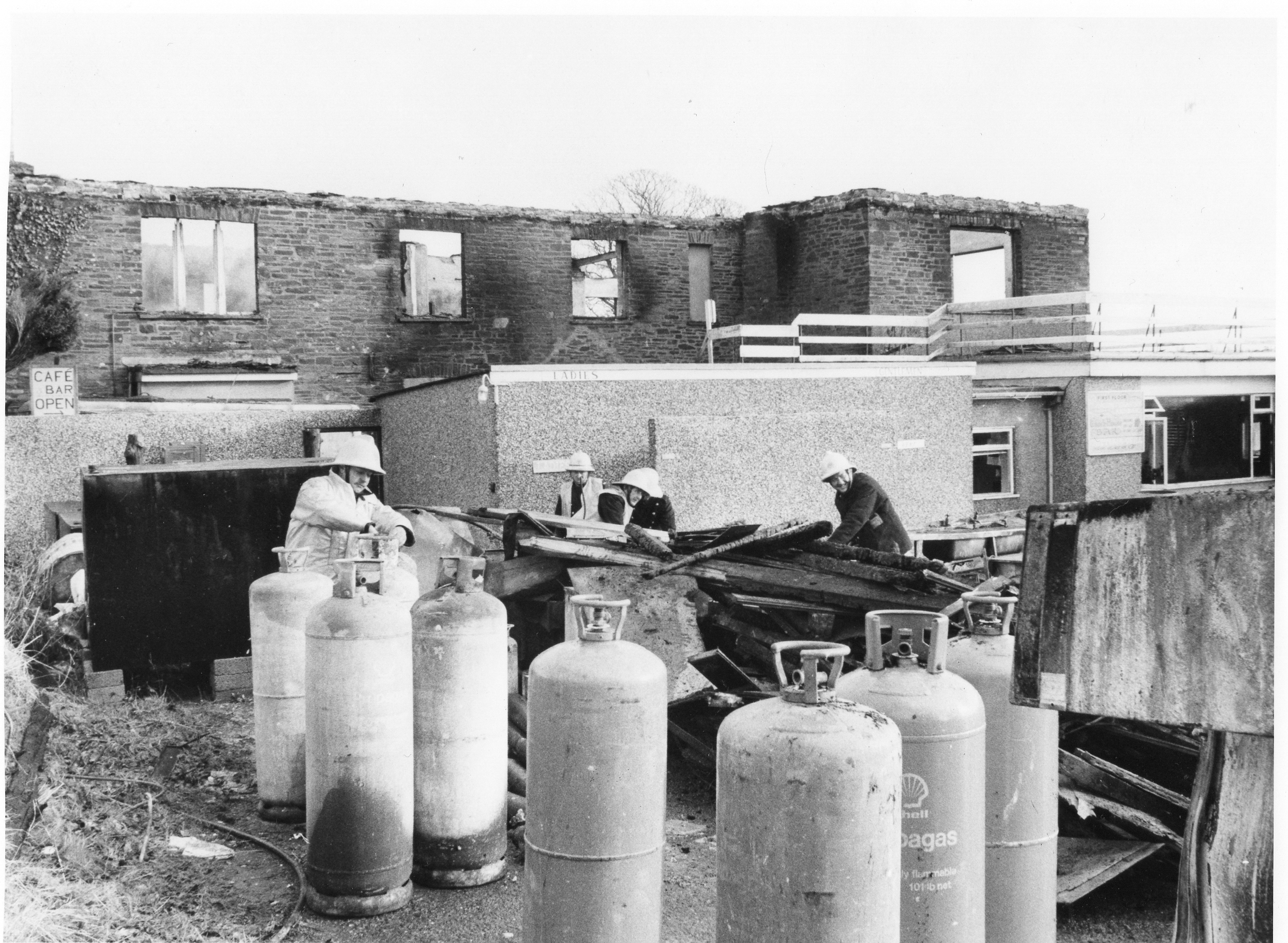
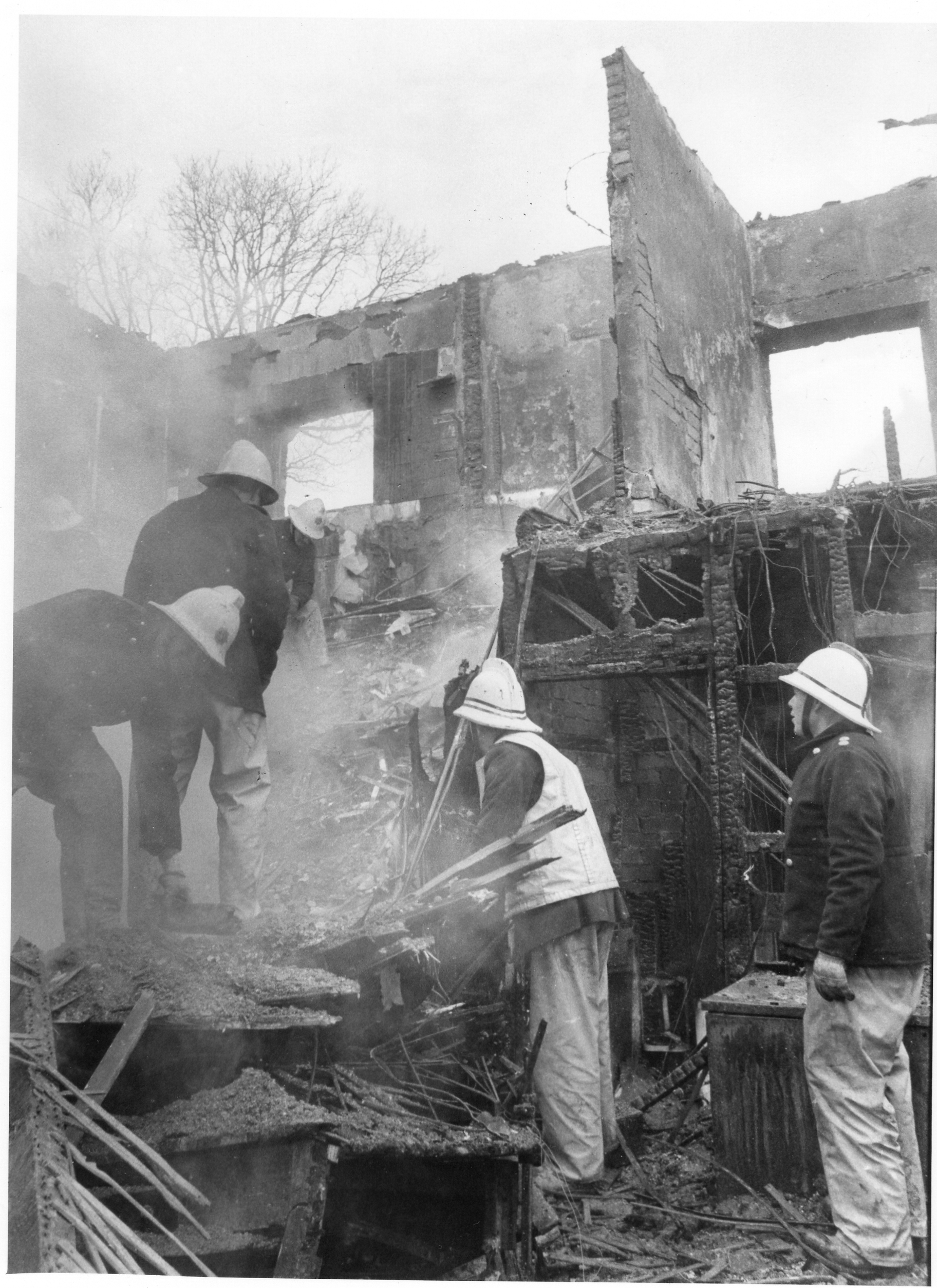
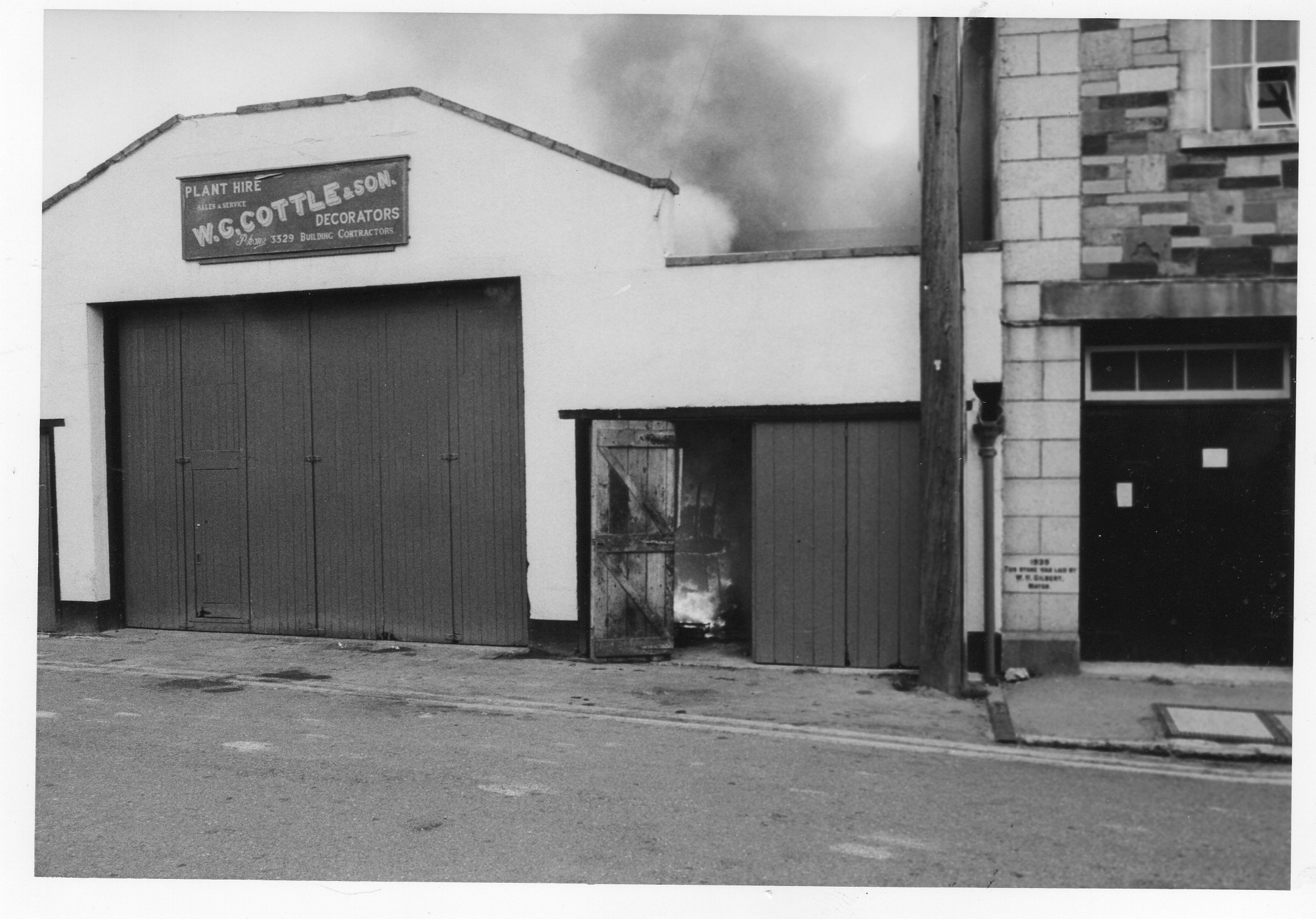
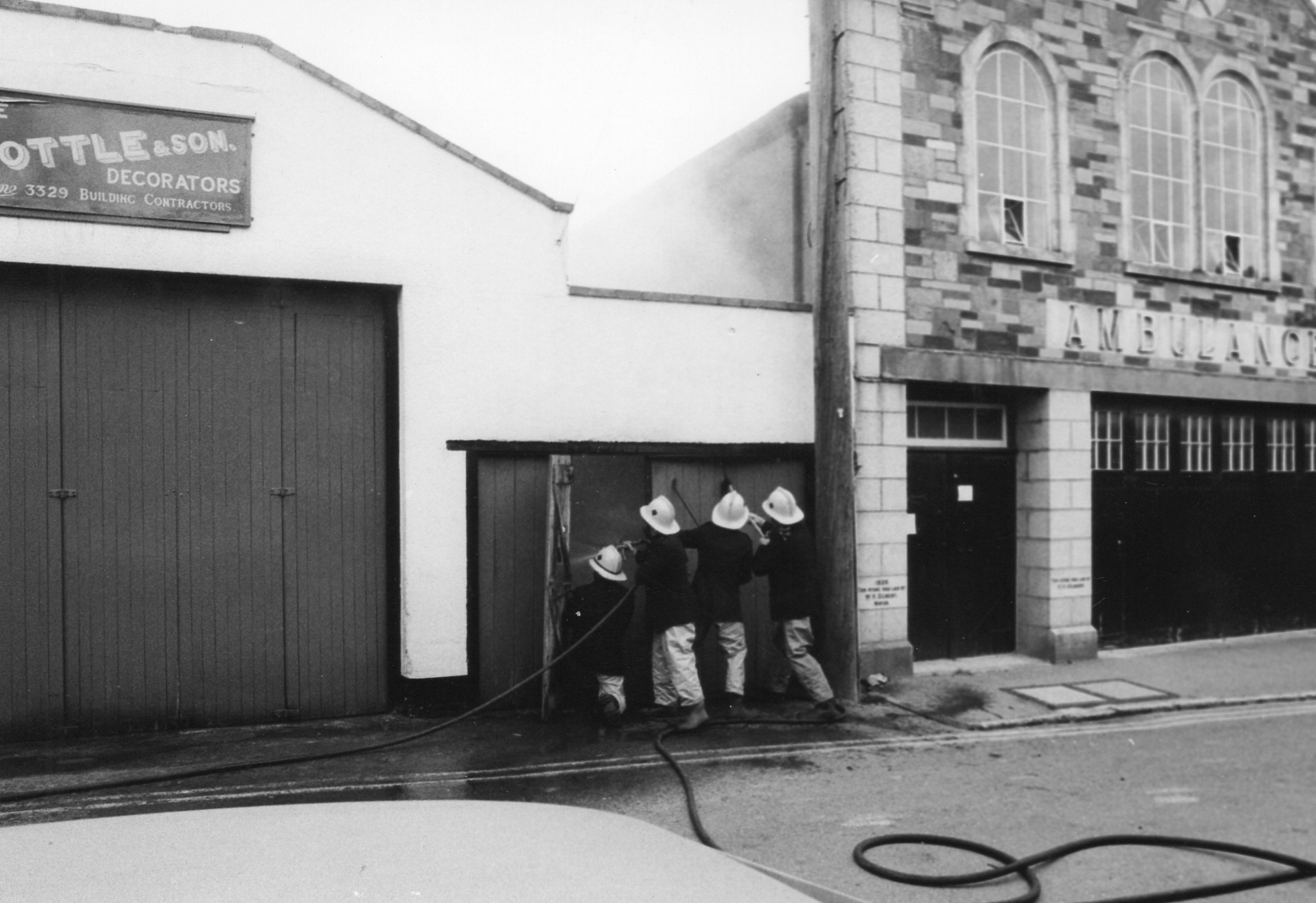

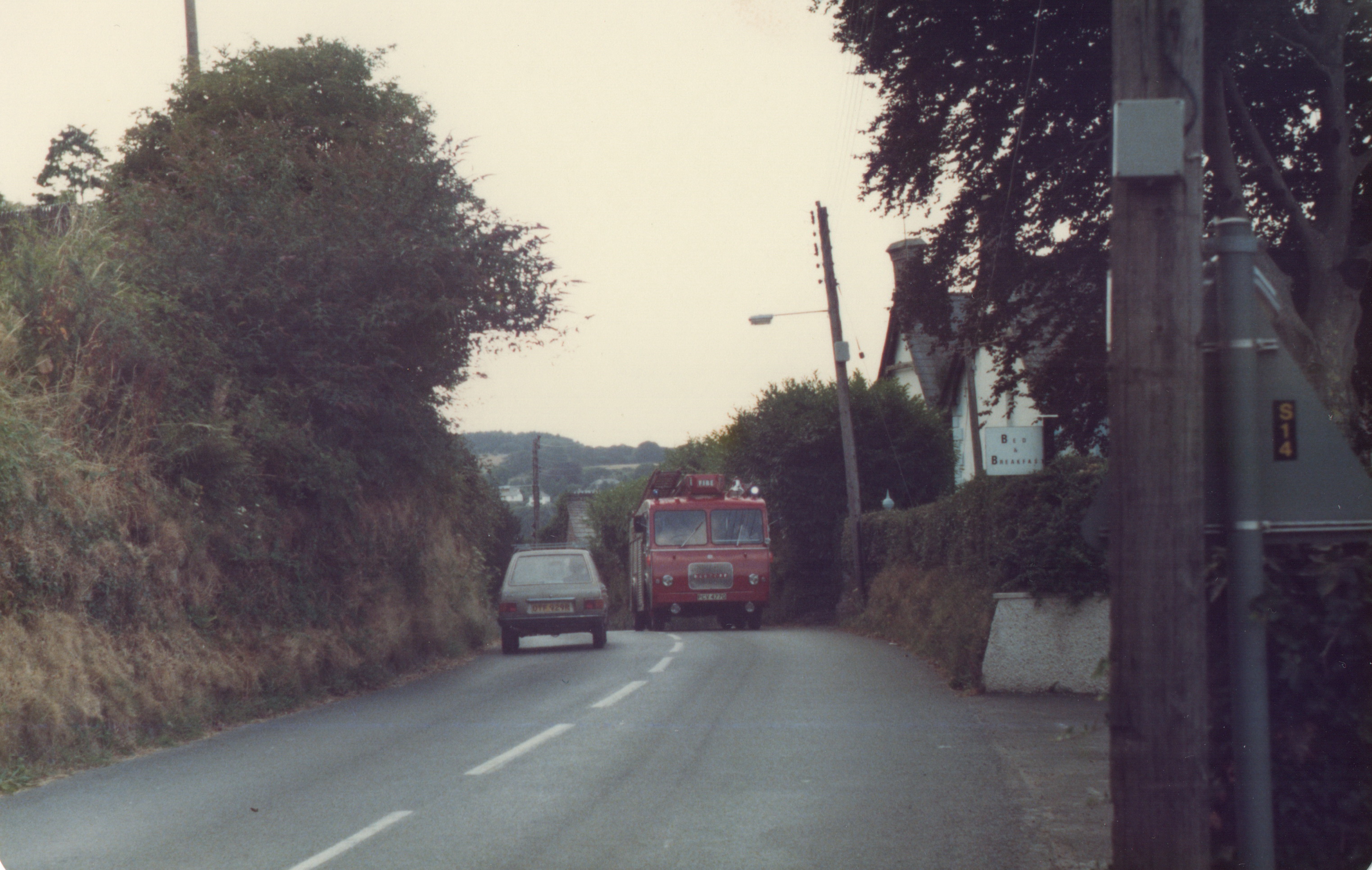
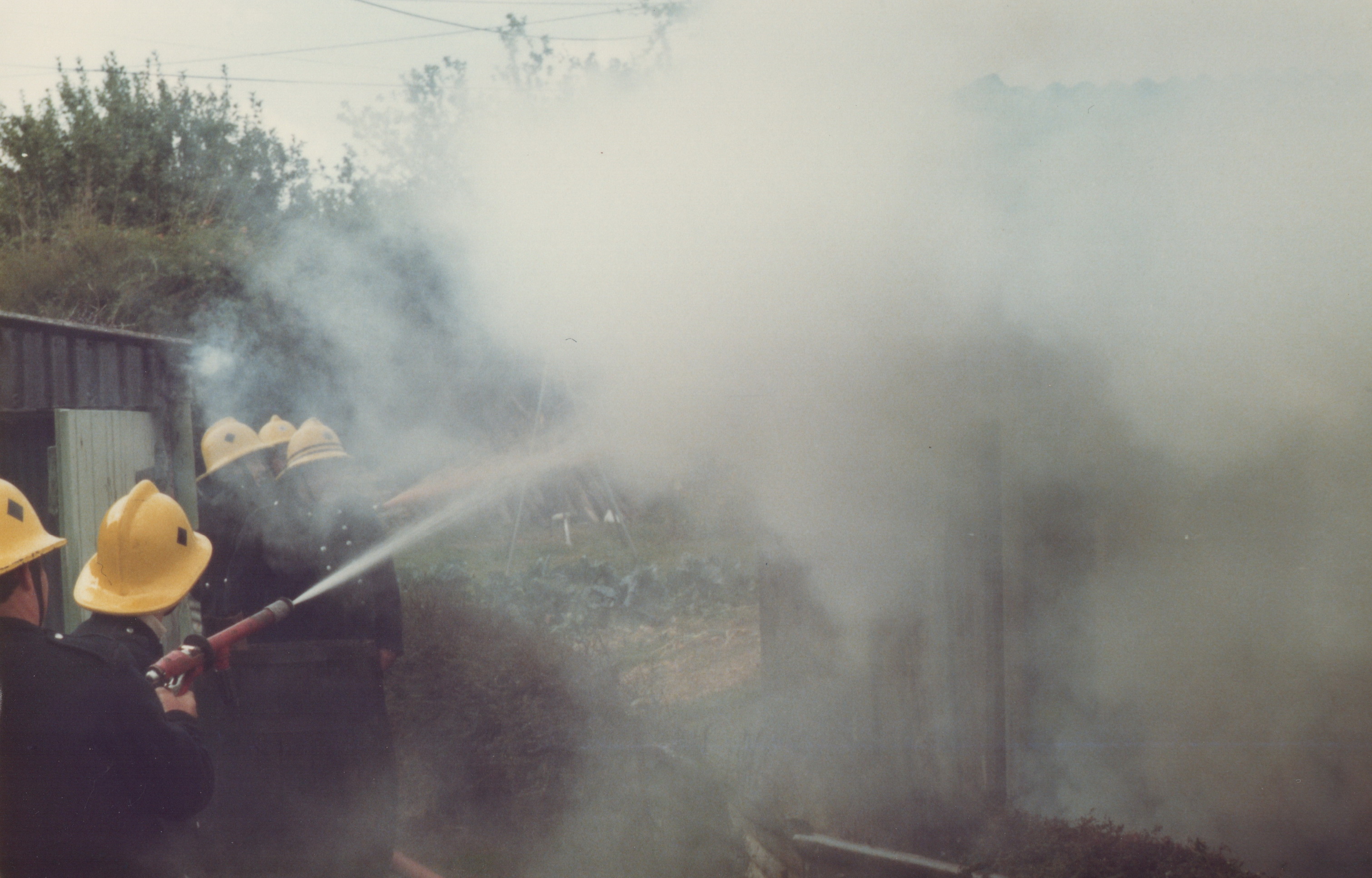
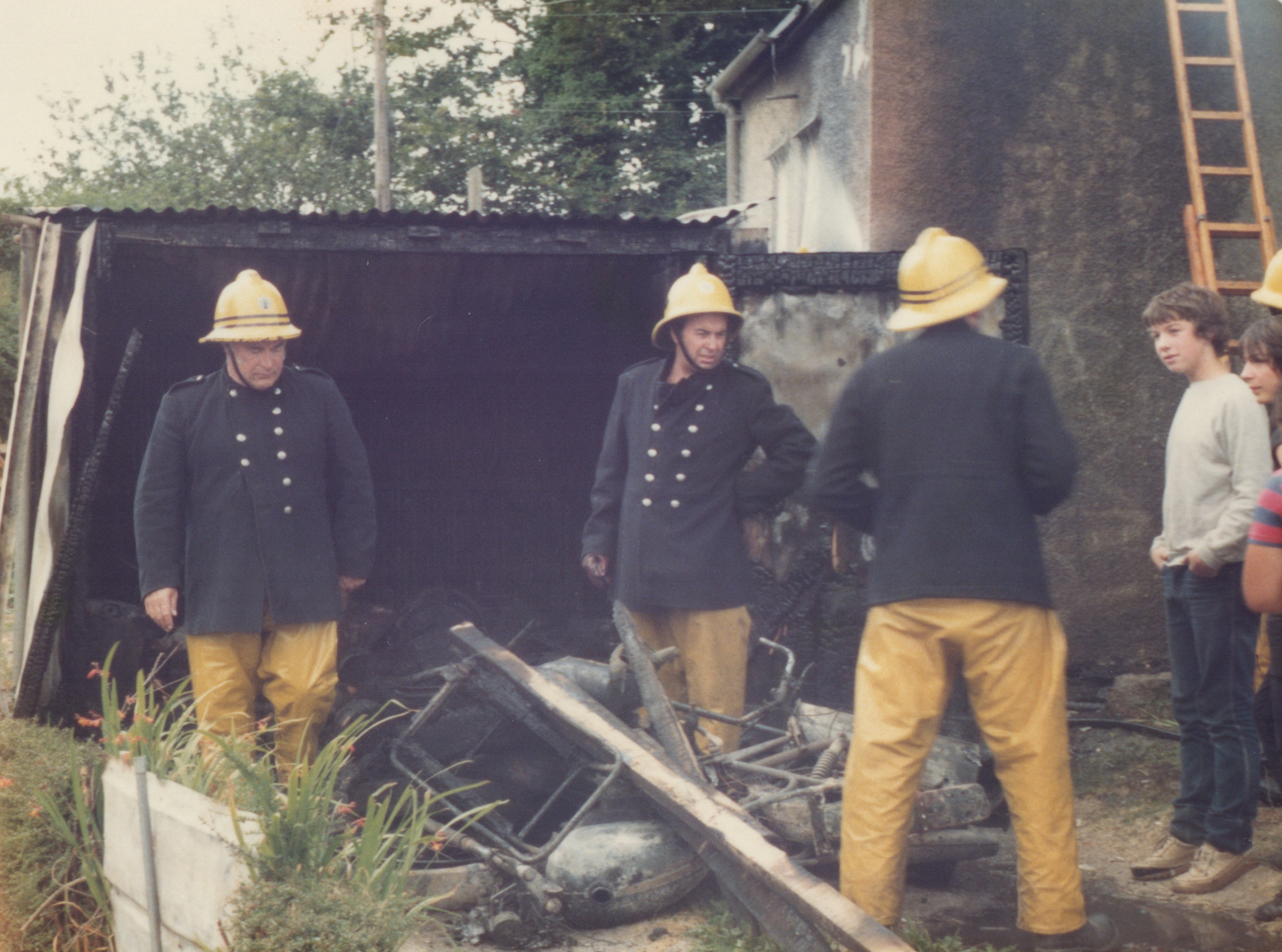

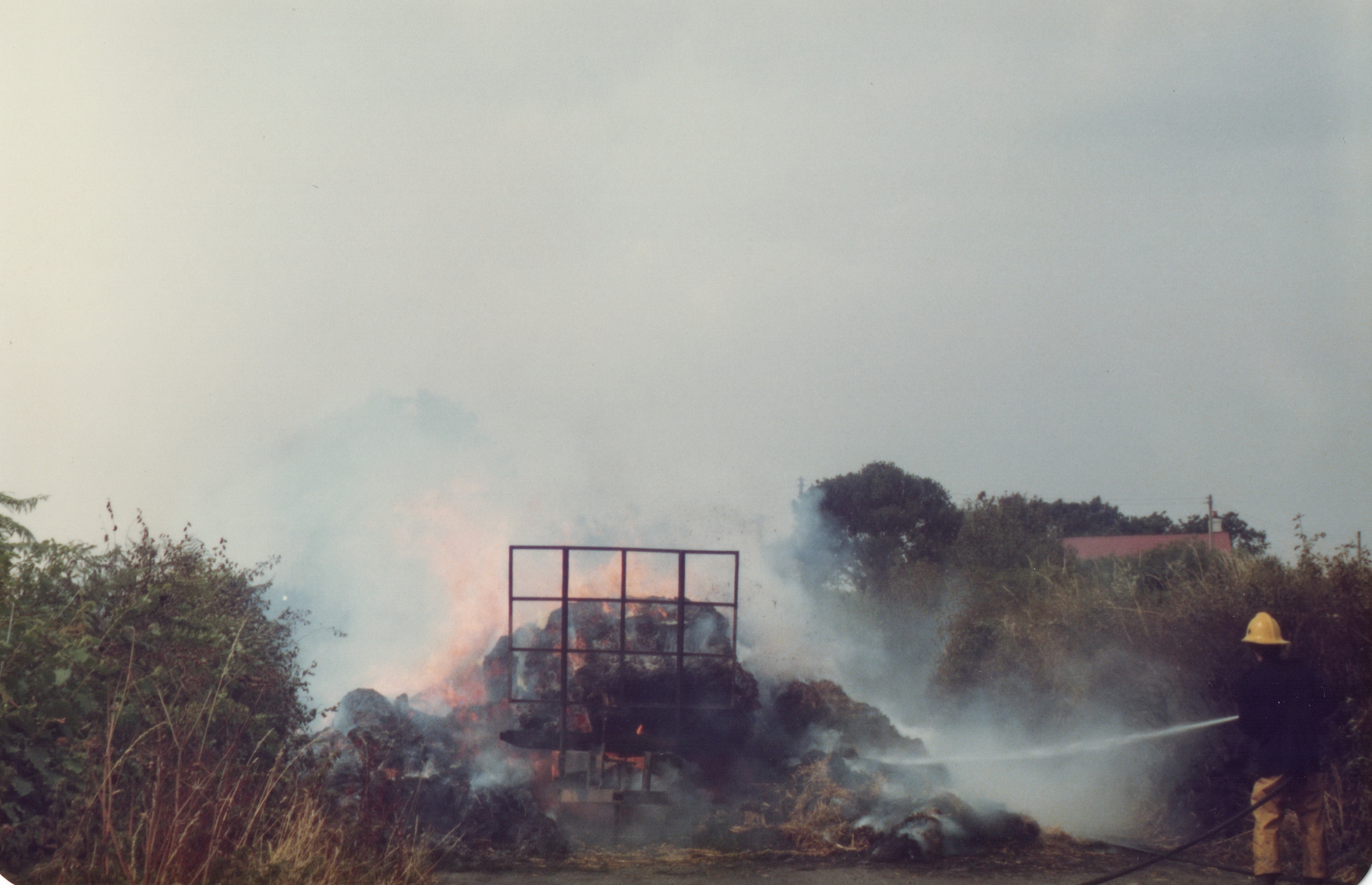
Lifton Fire August 28th, 1983. Photo’s courtesy of Gary Chapman.
Launceston Youth Club Fire, September 8th, 1983. Photo’s courtesy of Gary Chapman.

Hedge Fire on the A388 at Treburley, 1983. Photo’s courtesy of Gary Chapman.
Market Street Fire, February 15th, 1984, photo’s courtesy of Gary Chapman.
Bratton Clovelly Fire, April 4th, 1984. Photo’s courtesy of Gary Chapman.
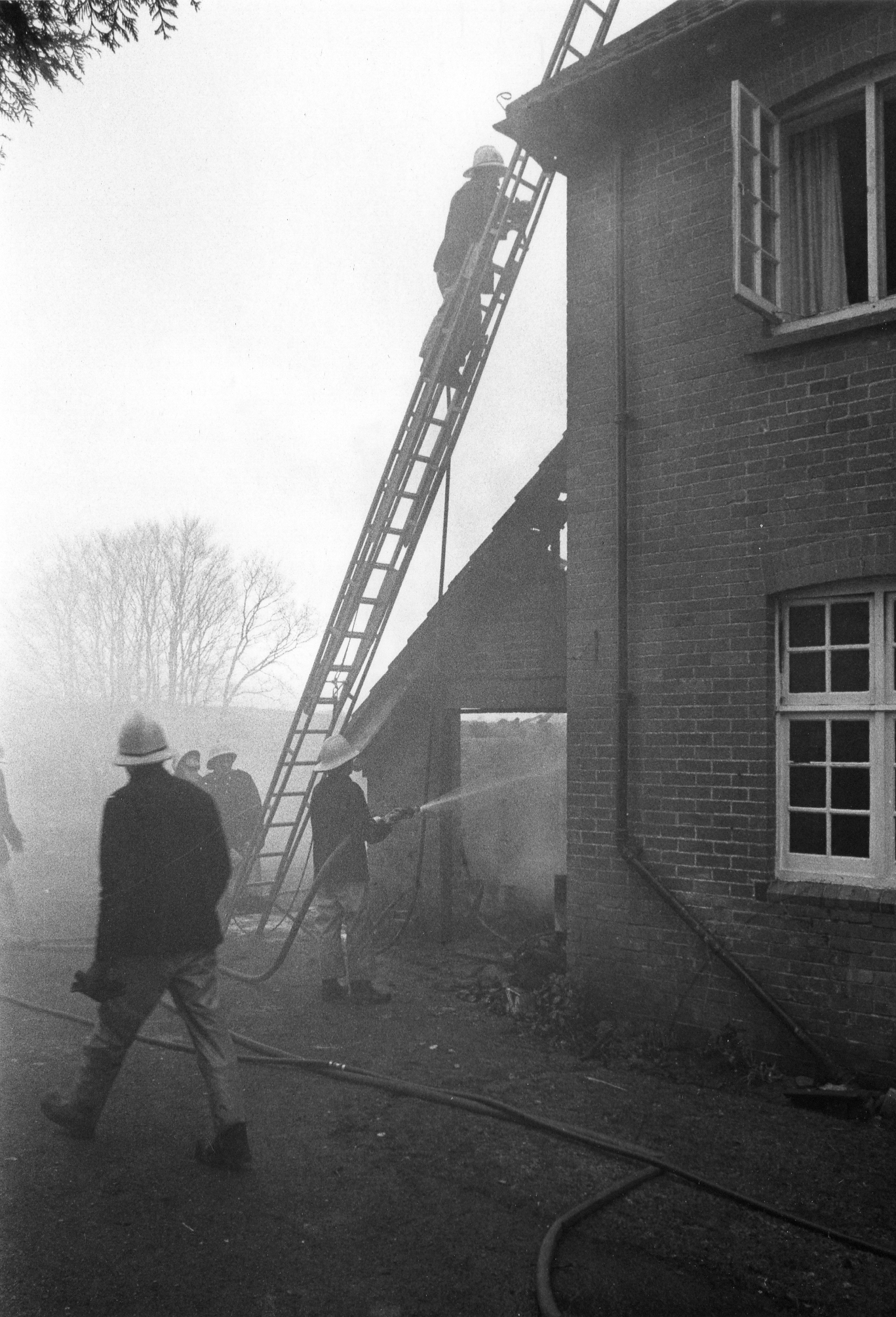
Launceston College Fire, July 30th, 1984. Photo’s courtesy of Gary Chapman.
1985 Underlanes Fire.
Broadwood Fire, May 25th, 1985.
Lewannick Barn Fire, 1986.
January 9th, 1988 edition: The Post & News. Police Wake Fire Sleepers:
Police had to break down the doors of sleeping residents when fire took hold at a Launceston house in the early hours of Monday. The son of the householder at 9 Hurdon Way, arrived home to see flickering through the sitting room window. He found the Christmas fairy lights decorating the window had fallen onto the settee, which was smouldering.
Launceston firemen used breathing apparatus before tackling the dense toxic fumes and smoke that was rapidly filling the house. Meanwhile police officers had to break down doors to flats on the floor above, when they were unable to rouse the sleeping residents. Because of the potential danger from the fumes, the entire house was evacuated.
A fire service spokesman said afterwards that damage was mainly confined to the one room, where the heat of the fire broke the glass in the window and the settee was badly scorched.
Coach Fire at Scarne on January 23rd, 1988.
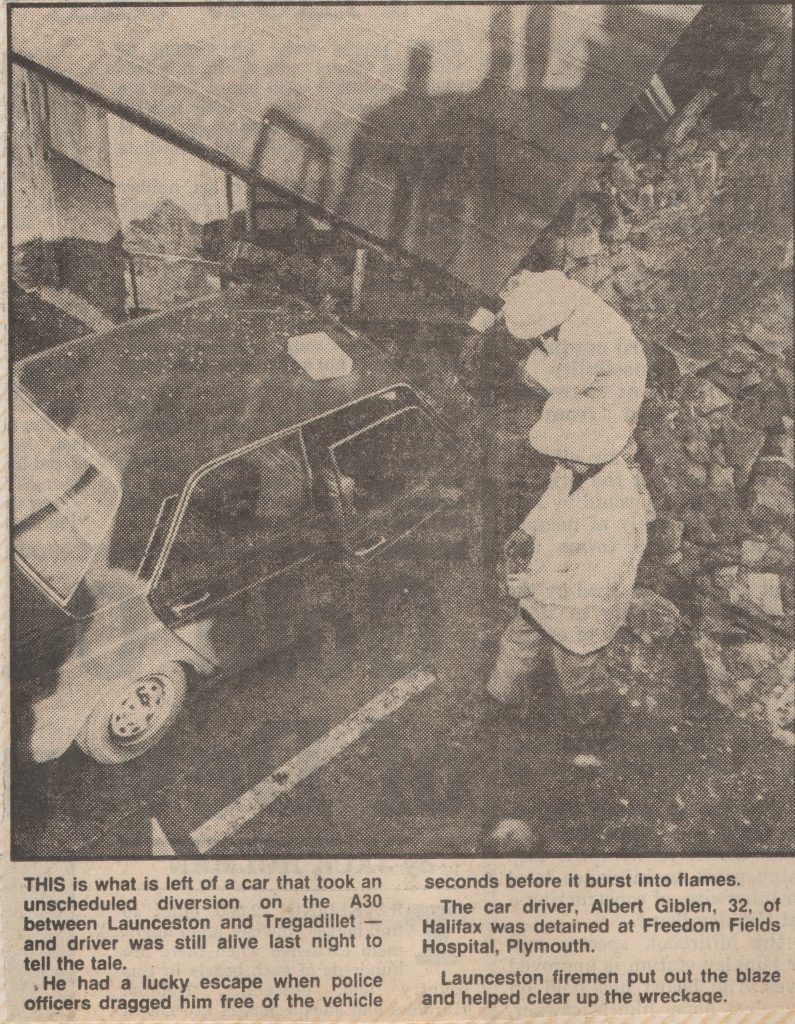

Tregaller Garage Fire, June 17th, 1988.
Launceston College Fire, August 3rd, 1988. Photo’s courtesy of Gary Chapman.
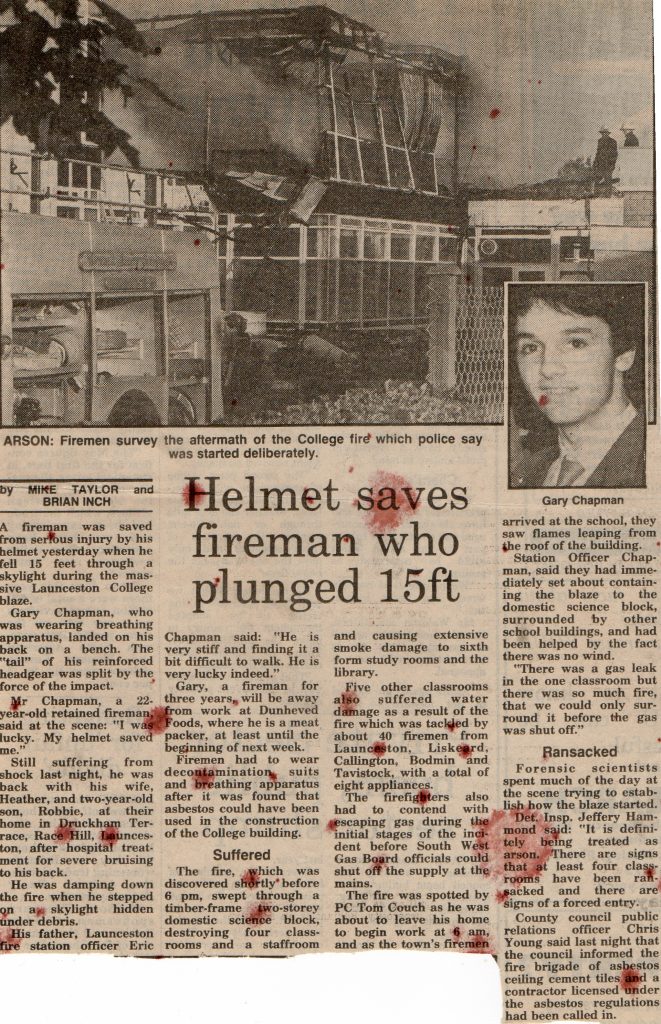
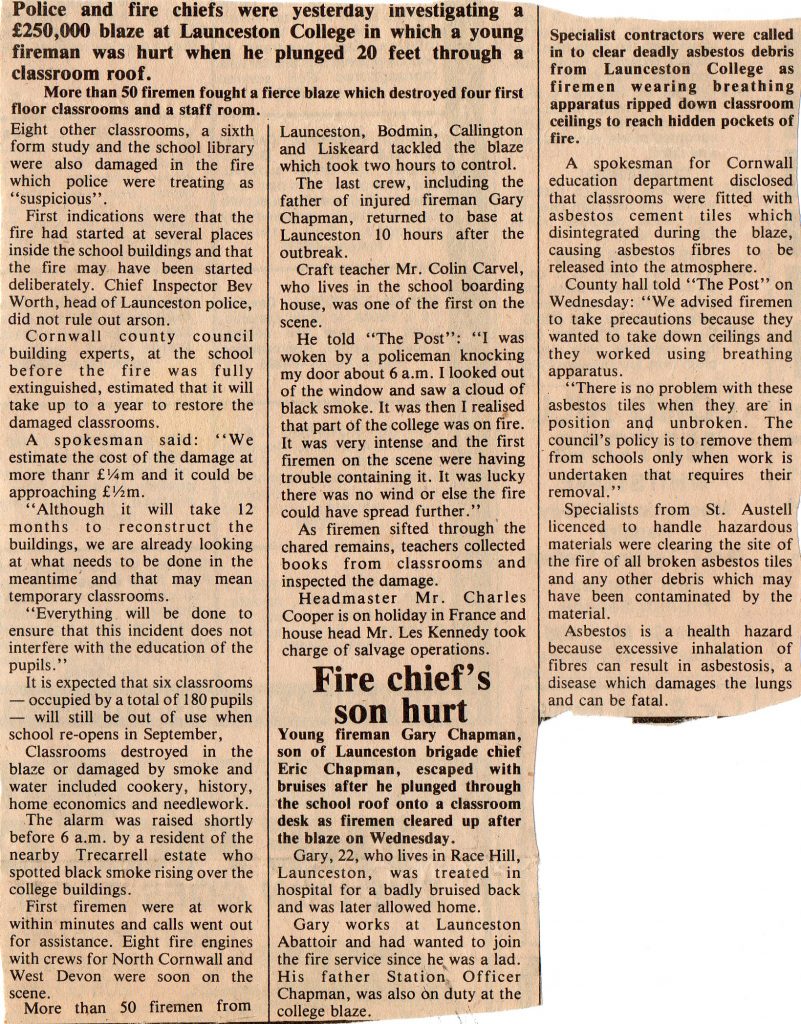
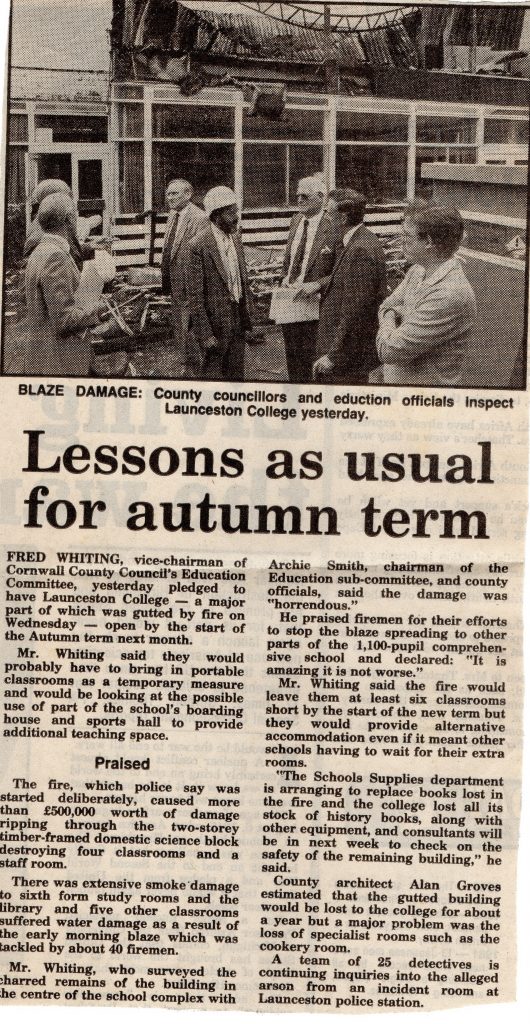
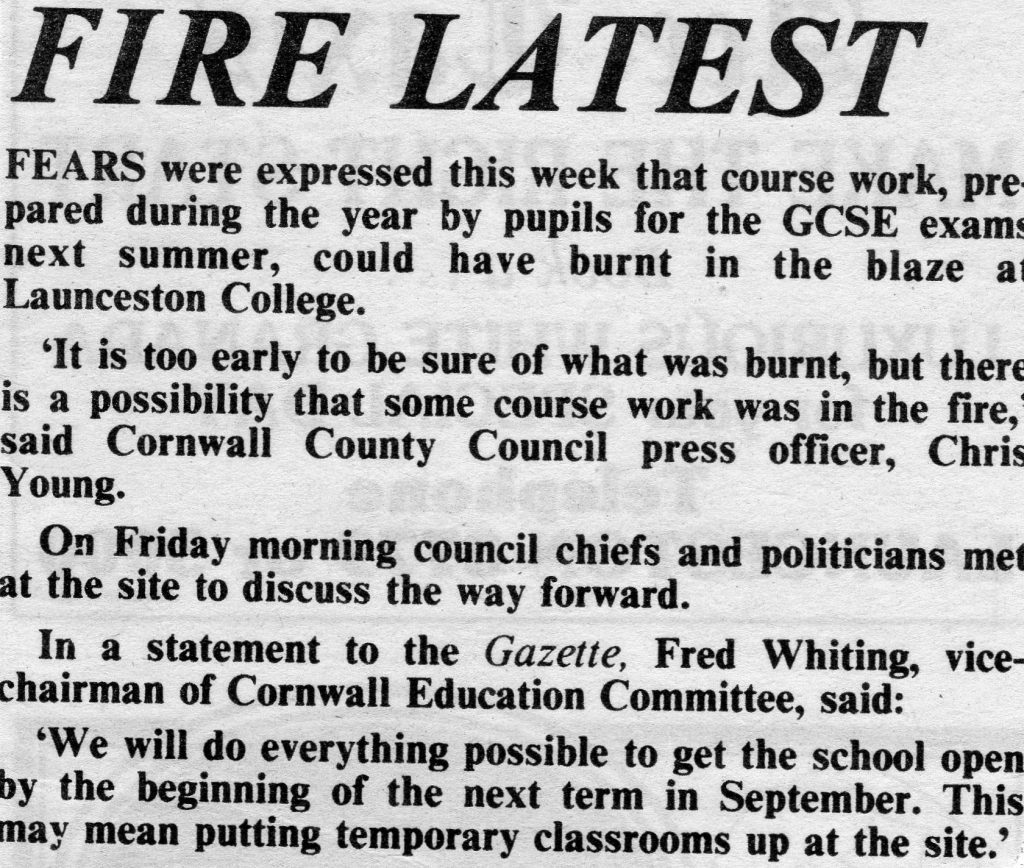
Boyton Barn Fire, August 14th, 1989. Photo’s courtesy of Gary Chapman.
Launceston Fire’s 1990-2014.
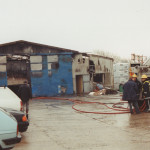

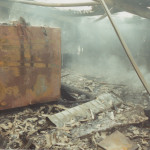
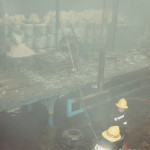
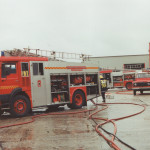
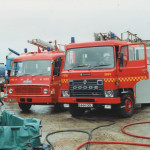
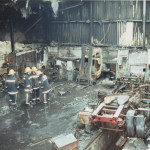
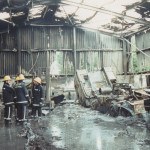
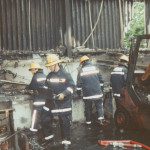
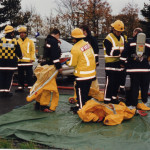
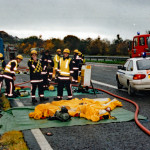
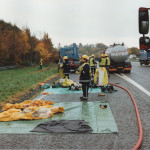
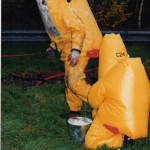
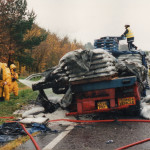
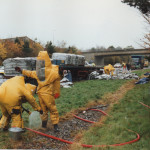
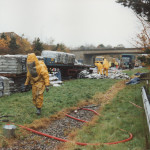
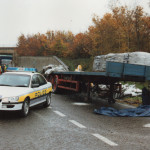

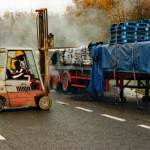
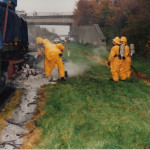
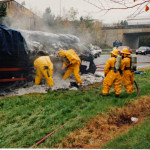
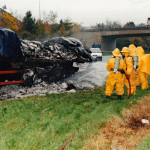
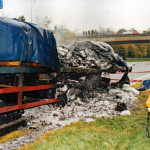
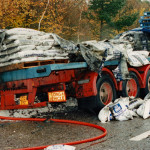
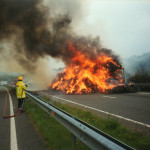
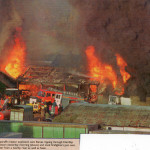
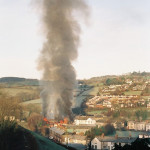
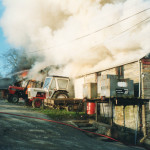
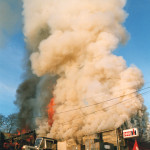

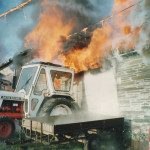

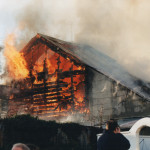
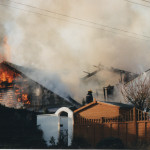

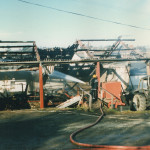
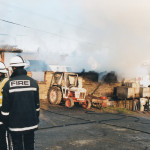
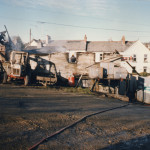
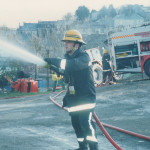
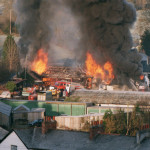
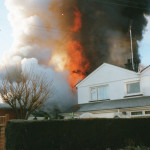
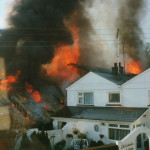
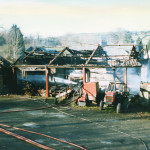
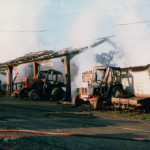
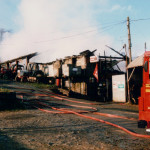
Flood Rescue, December 6th, 1995. Photo’s courtesy of Gary Chapman.

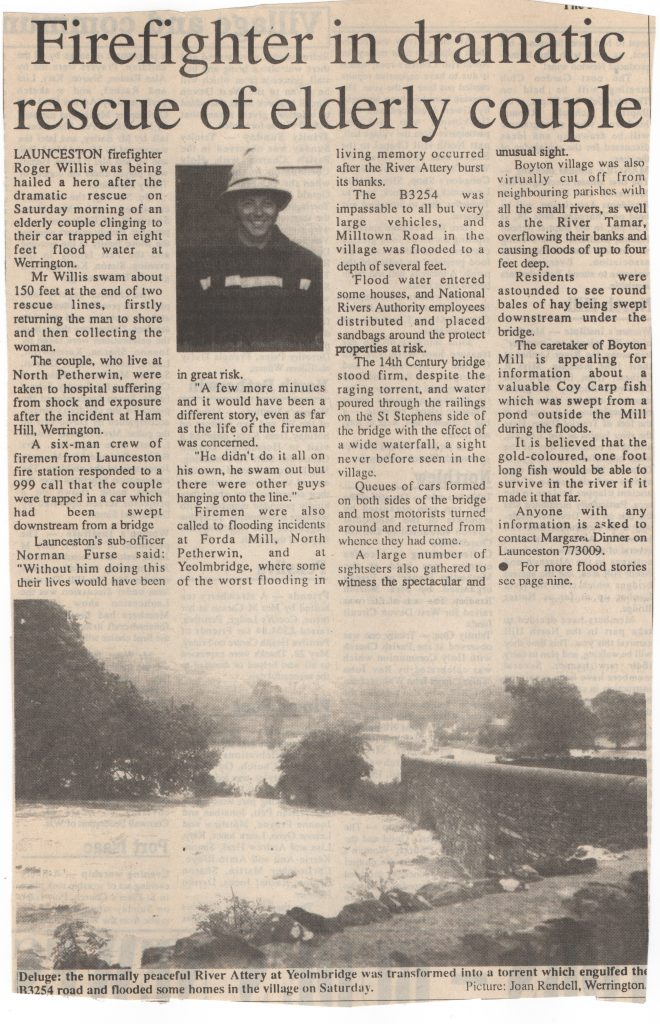

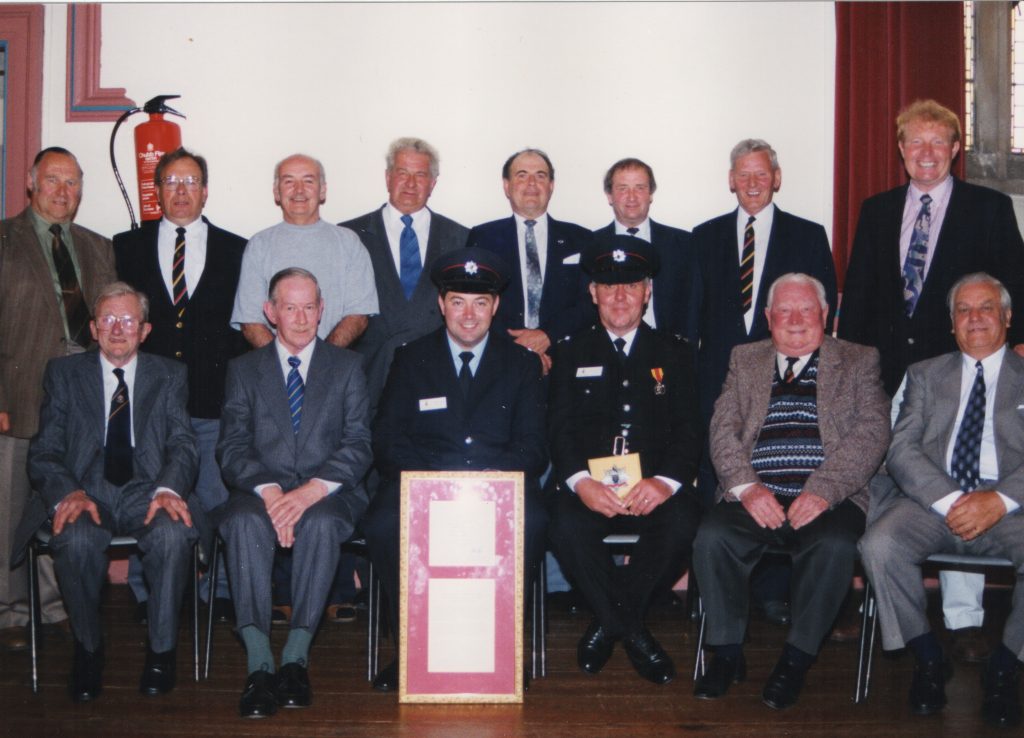
Launceston Fire’s 2001-2014.
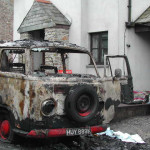
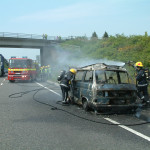
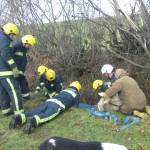
Northcott Hamlet Pallet Fire, August 2004.
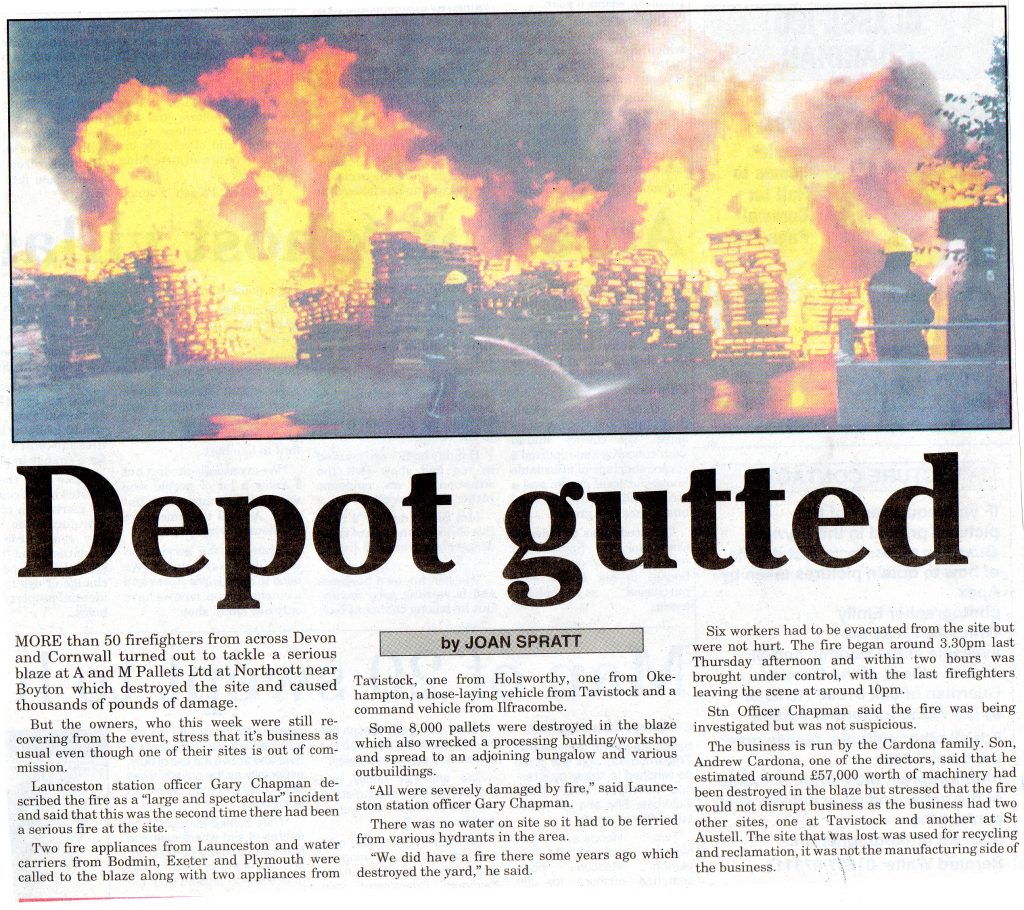
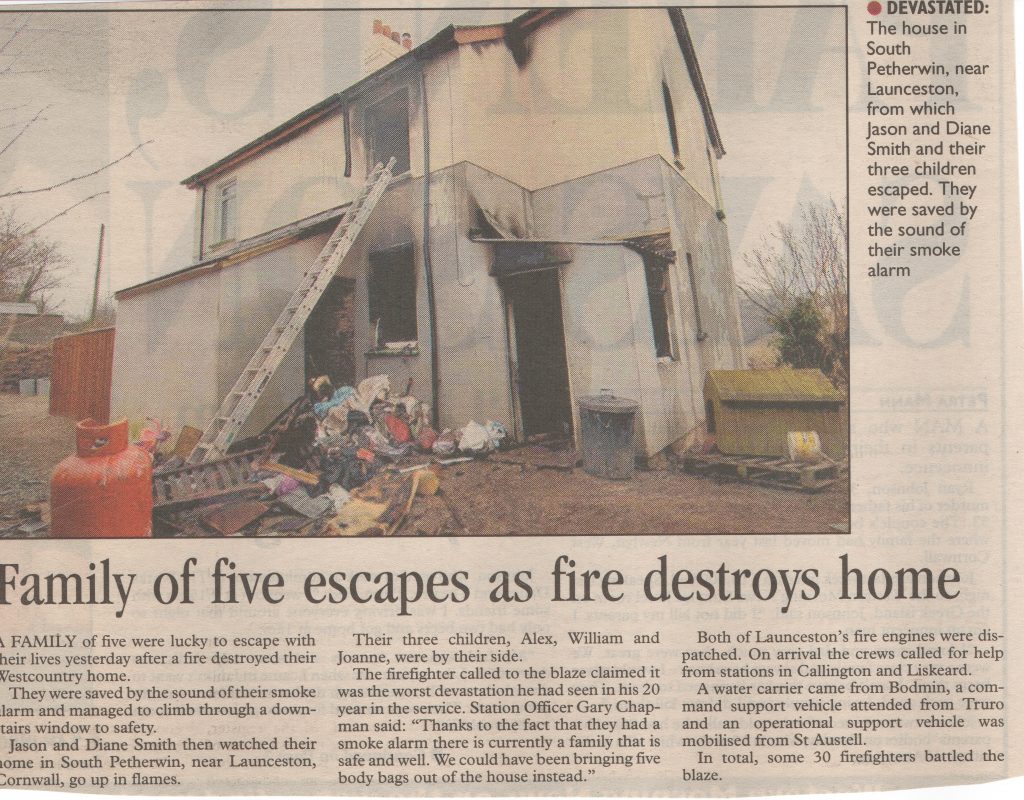
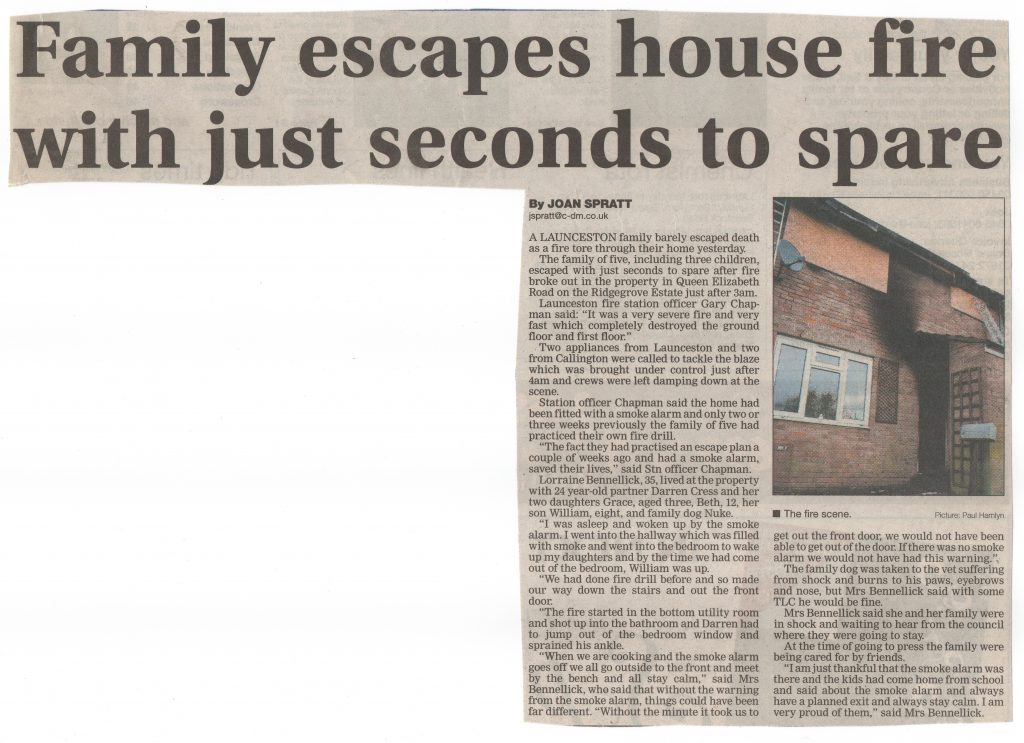
Snowfall February 3rd, 2009. Gary Chapman.
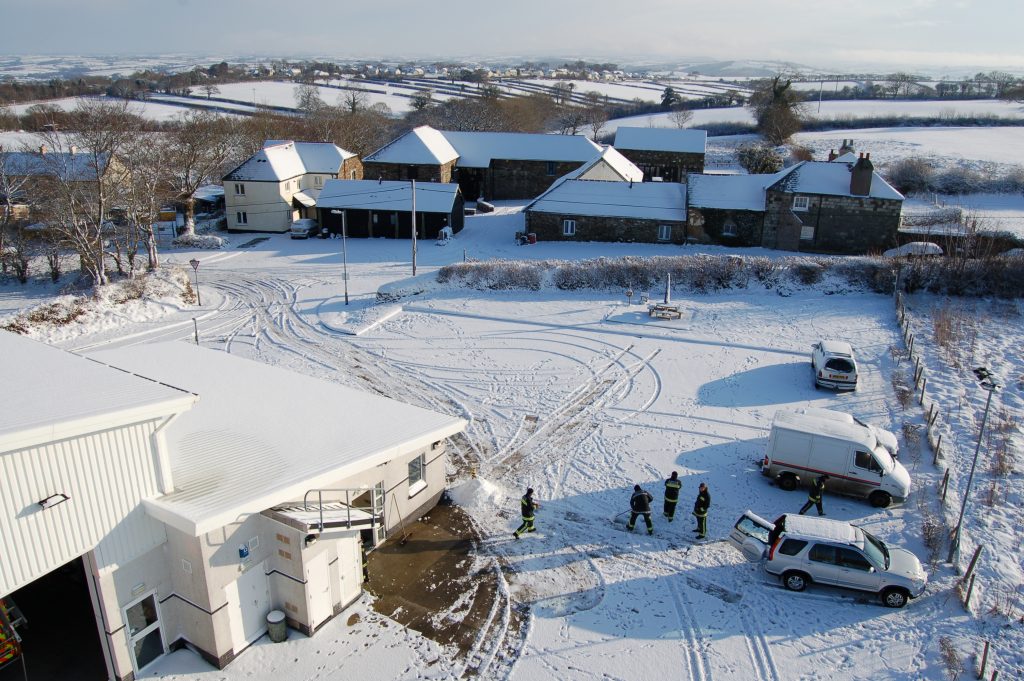
Monday 2- Tuesday 3/2/09 At 17:00 it started to snow heavily and quickly settled making for terrible driving conditions. For the next 3 hours I was in touch with control and debating getting a crew brought onto station. It is one thing getting the pumps out but quite another getting all the FF into the station as they all rely on cars due to the out of town location of our new station.
We fitted snow chains on the Atego and decided the mog would be first away for all shouts until further notice. I decided to leave it and see how things went and within 30 minutes of leaving the station was heading back to it for an AFA. This proved to be the most hazourdous journey I have ever made to the station.
We decided to see how things developed over night and review things in the morning. It was snowing on and off but the main problem at that time was the freezing conditions.
In the morning control rang at 07:30 and I said things are about the same so we will leave it at present. Within 10 minutes of putting the phone down it started to snow heavily and within a few minutes it was decided to get crew on station for cover.
Once traffic started to move around the roads turned into one big of abandoned vehicles.
We stayed on station until 11:30 when conditions became passable on the main routes to the station. No incidents were dealt with.
Thursday 5 – Friday 6/2/09 At 22:30 we were called to a chimney fire four miles out of town on the County border. On arrival we had a difficult job with a wooden beam well alight in the fireplace. I requested 2 additional personel in our van to assist us.
When the shout came in it was just starting to snow lightly, I had made the decision to take the Unimog due to the location of the farm. There were no weather warnings for the area at all.
The snow continued to fall and as we were winding down I sent the van home about midnight saying that they may not get home in all the snow (tongue in cheek).
We had a problem restowing our lighting mast on our return and were advised how to do this by disconnecting various pipes over the radio (via Brigade Engineer). This worked and it turned out the mast had froze up with the wind chill and there was nothing wrong with the mast itself.
Whilst heading back in heavy snow which was blowing across the road my mobile went and my Sub informed me he had to go back to the station in his 4×4 and pick up the 2 FF from the van as they could not get their cars out from the station. He took them both home. It seems the van very nearly did not get back and was almost abandoned at one point. This was now about 00:45.
We slowly made our way back to town in vitual blizzard conditions and by this time control informed me Devon had a major incident ongoing near Exeter due to the snow.
We made the decision to staff the station through the night due to the worstening conditions.
On getting back into town we found Police and Ambulance in attendance at a bus which had slid out of control and the passengers were being evacuated into our town hall which was being set up as an evacuation point. We stopped and asked if we could help and were asked to get supplies of food and drink for the 40 or so people.
We briefly returned to station to update control and then made our way to our 24 hour Tescos for supplies. By now the snow was very heavy and conditions were very bad.
This continued for some time. We fitted snow chains to the Atego.
We delivered the supplies to the town hall and on returning to the station found many youths playing in the streets and sledging down the hills (this was 03:00).
At about 05:00 I asked control if they could consider sending a couple additional 4×4 appliances up to us in case things did actually kick off but the duty DO said no as he did not want to get them stuck getting up to us. Bear in mind most of the county was clear of snow so additional resources were readily available and the A30 was open to 4×4 vehicles. So basically we were left to fend for ourselves.
At 07:00 I started ringing around to various FF to see if they could attend the station if we picked them up in the Unimog. By doing this we could man both pumps.
At 07:30 we set out to pick up more crew and conditions were pretty bad everywhere we went. The Mog handled it all very well with the driver making full use of the 4×4 system.
The snow stopped sometime around 10:00 and conditions started to improve. We stood down on station at 12:00 as it was now possible to get in and out of the station by car. At 13:00 the mog was sent with a crew of 4 to pick up 2 nurses and get them into the local hospital.
Fire at home of Joan Rendell at Tremarsh, Yeolmbridge, May 4th, 2010. (Warning this section does contain direct information as to her death.)
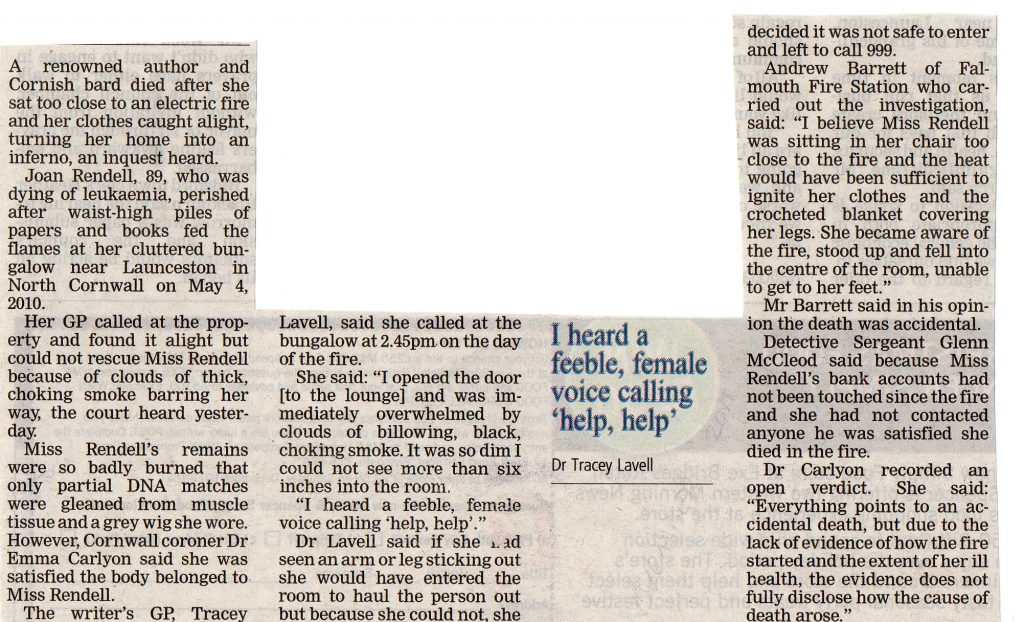
Homeleigh Garden Centre Fire December 14th, 2010.
Barn Fire at Coombe Farm, Lifton, January 18th, 2011.
Recovery of a car that went off the top of St. Thomas Road on March 24th, 2011.
Bowithick Gorse Fire March 25th, 2011.
Heath Fire, March 14th, 2012.
RTC on the A30 at Launceston, August 28th, 2012.
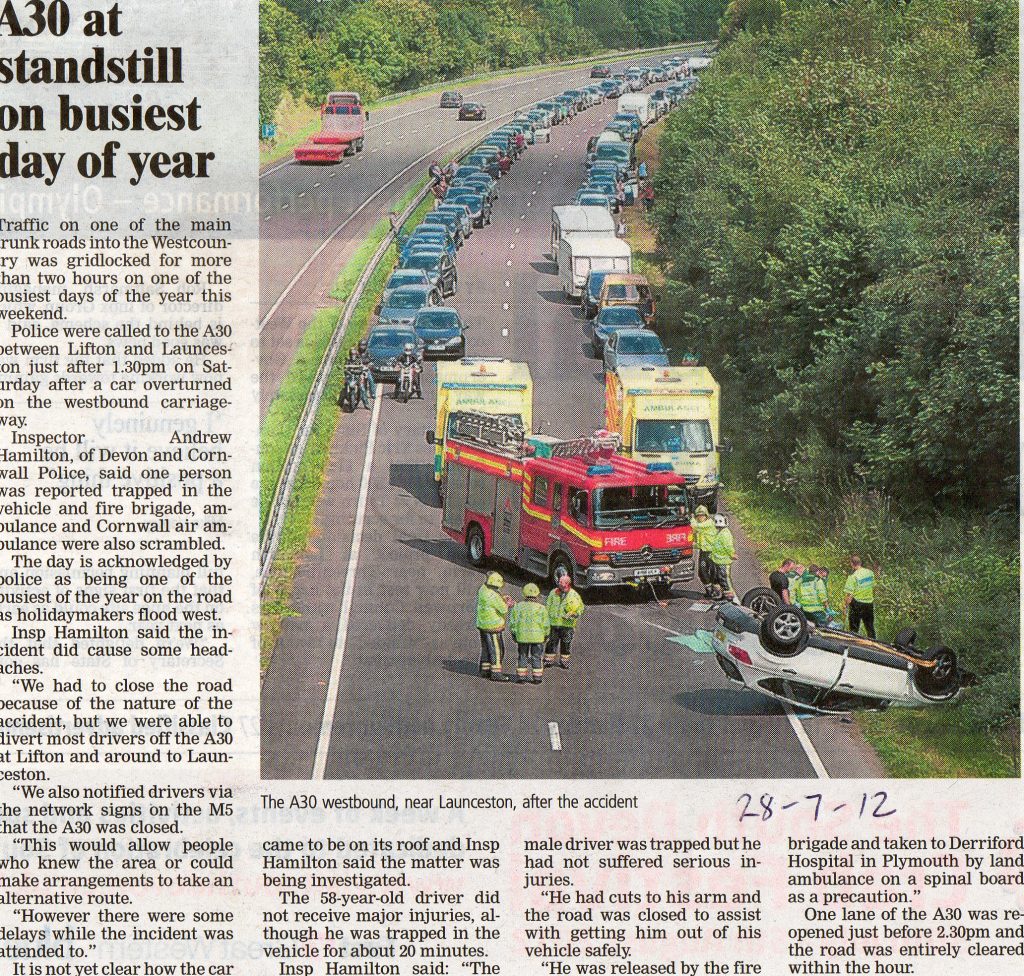
Sydenham House Fire, November 14th, 2012.
Launceston Log by Station Officer Gary Chapman.
Lewdown Area at 14/11/2012 17:00
At approximately 1600 hours this afternoon, one appliance from Launceston was requested to attend a reported property fire in Devon, on arrival further resources were requested and a further appliance from Launceston was requested. The fire involved an historical house which was well alight, the fire was rapidly developing and the incident was upgraded to fifteen pumps and two aerial ladder platforms. A further appliance, from Bodmin, which was en route to standby at Launceston, was mobilised to this incident.
Lewdown, Okehampton at 15/11/2012 08:37
Crews from Cornwall Fire and Rescue service have been in attendance at the fire scene in Lewdown. Since the fire started at Sydenham House yesterday crews from Launceston, Bodmin, Callington, Saltash and Bude have attended the scene, a total of 35 firefighters from Cornwall. Six firefighters from Saltash are currently on scene at the incident. No further details are available from Cornwall Fire & Rescue.
14/11/2012
Time: 16:02
Location: Sydenham House, Lewdown, Okehampton.
Fifteen fire appliances are attending a severe fire at Sydenham House, Lewdown, Okehampton. The historic building has four floors, 50m x 30m, the whole of the roof is involved in fire and 50% of the first floor. Crews are using 6 jets, 1 hose reel jet, and water from a river and lake adjacent to the house, and carrying out salvage. Crews at the scene include Tavistock, Okehampton, Greenbank, Plympton, Yelverton, Bere Alston, Ashburton, Hatherleigh, Crownhill, Bovey Tracey, Chagford, Holsworthy, and several from Cornwall. Part of the stately home is at risk of collapse. 18.20 The building has been evacuated and everyone has been accounted for. Eight jets in use, one aerial ladder platform in operation. Building control requested, road closures in place. Roof and fourth floor involved in fire. 19.45 Steady progress being made. Crews still at work with 7 main jets, one aerial ladder platform and 2 Light portable pumps. 20.31 The fire ground has asked for 9 pump relief crew for 2100 hrs, crews from Buckfastleigh, Moretonhampstead, Torrington, Bideford, Crediton, Plympton, Modbury, Princetown and Callington (Cornwall) are attending. This is a Stately Home consisting of four floors, whole roof involved in fire, at work with 8 jets and 2 positive pressure fans, crews carrying out salvage on ground floor. 23.28 This incident has now been scaled down to a 9 pump relief crew. Crews are still at work damping down hotspots using 6 jets and working from an aerial ladder platform. 15/11/12 03.30 Incident now scaled down to a 6 pump relief crew. Steady progress being made, crews now damping down using 4 jets and one aerial ladder platform.
09.15 Sydenham House is a three storey, 16th century, grade 1, listed historic building used as a domestic dwelling. It forms part of the Sydenham Estate which undertakes farming and shooting functions. The initial call was to a first floor bedroom fire. On arrival, the first floor bedroom and roof were well alight. The Fire Investigation is due to continue today. 09.30 Relief crews have now been mobilised to this incident from Tavistock and Yelverton. 11.00 This was a three storey building plus a basement used as a private dwelling and an historic house. The roof and top floor were severely damaged by fire, 70% of the lower floors damaged by water. Two appliances still on scene damping down. Fire investigation continuing. Following a risk assessment of stability of building by Building Control Representative areas for salvage and firefighting have been identified as safe. Crews now entering the building in safe areas for firefighting and salvage operations. 1403 Crews on scene using a 135 ladder and compressed air foam (CAFS), steady progress being made damping down rest of incident. Update 00:12 Fire crews have been in attendance throughout the evening, maintaining a fire watch at the incident. Crews have now left the scene but will be returning with officers in the morning to continue investigations.
1620 V57P1 in attendance building well alight MP 5 1622 Make aerials 1 1628 Second story of historical house well alight 2 jets HR water from river and lake 1639 MP 8 1654 6 jets salvage in progress BA withdrawn due to possible building collapse 1655 MP 12 Aerials 2 1708 MP 15
57P157P2 74P174P9 13P113P2 58P152P147P119P109P120P123P110P149P149A171P1 CFRS 50C150P201A1
RC 51P122P156P127P115P104P238P255P185P2 CFRS 47P132A148P159P150P132P1 73P584P5 CFRS
57P258P1
We were mobilised on PDA as third pump at about 1600 along with 2 pumps from Tavistock. On arrival Tavistock’s officer MP5 building well alight. We arrived about 2 minutes later and were directed into a rear courtyard where a hydrant was located [this proved to be of no use]. We found the last two first floor windows of the house to be well alight with flames blowing out at quite some rate to a height of about 1520 feet. Tavistock had run the first jet in through a side walled garden and had just got water on as we arrived. It was clear that the fire had already breached into the roof above the windows and after a quick discussion between Tavistock’s officer and myself we decided not to commit anyone inside the property at that stage.
I directed my crew to set our LPP into the lake directly in front of the house and supply the WRL. Whilst this was going on we ran out our first jet and dropped our tank supply into the first floor room. This did knock the fire back but had no effect on the fire now burning under the roof slates. Meanwhile Tavistock’s crew set their LPP into the lake and we managed to get 4 decent jets operating fairly swiftly. Following further discussions between the incident commander and myself MP8 was sent and a request for 2 aerials was decided upon. I was designated as sector commander of the lake side of the property [later known as sector 3]. Shortly after this I entered the ground floor to see if we could safely get a BA team onto the first floor. Already at this early stage one room was smoke logged on the ground floor. We decided to get a BA team in with a hose reel and thermal image camera to see if they could evaluate the situation on the first floor. Two of my crew were then committed into the building and made their way up to the first floor with a hose reel. Shortly after this the fire started to break through the roof and it was clear the area was already lost so I pulled the BA team back out. Further pumps then started to arrive at the road side of the house [ sector 1] including our WRT. Initially they were tasked with getting water onto the roof but already it was breaking through rapidly and smoke was now showing across the whole roof of the house. It was decided to start salvage operations from the ground floor as it was clear we would not be able to stop fire spread across the roof. A number of crews then worked for some time in the ground floor removing various items including valuable paintings and furniture. By this time water was flowing down into the ground floor rooms. On arrival of the first senior officer it was thought we may be able to make a stop on the first floor about halfway along the property. I had to find 4 BA wearers and ended up with 4 of my crew committed to the first floor with a hose reel. Once in position they found an access door into one of the many cavities and when opened up they found fire roaring past them. They could also see fire burning above the ceiling lights. It was clear a safe attack could not be made and they were all pulled out and it was decided on exterior fire fighting only. The fire continued to spread along the roof despite numerous jets and over the next couple of hours it spread through the whole building. The roof was far too large to commit ground ladders up to it. If we had done this firefighters would have been put at great risk of being caught up in a collapse. Only one of the two aerials could get access to the scene due to the narrow lanes and build up of appliances. This one was Crowhills ALP and he was put on the corner between sector 4 and 1. As more pumps arrived more jets were got to work and at one point I counted 10 jets working in sectors 2,3,and 4 along with the ALP above us. Crews in sector 1 had at least 7 jets working. In my sector we had 3 LPPs supplying water and in sector 4 they had a number of LPPs set into the River supplying the fire ground, water was never a problem. It was not until late into the evening that we had a grip on the fire spread but even then we had areas which continued to burn uncontrolled for periods. Access to the seat of the fire proved difficult throughout but we did prevent any significant spread from the first floor down into the ground floor over most of the property. Logistics on the fire ground proved a nightmare and never improved for all the time I was there. Personnel were stretched and no opportunity existed for rotating staff around for most of the incident. I think they should have gone to MP 20 to allow crews a break. Early evening the temperature dropped and my crews had frost forming on their tunics although this was not a problem in other sectors so we think it was due to working beside the lake. Mid evening there was a significant explosion inside the property but I have no idea what this involved. Possibly an oil fired boiler was mentioned but it caused a stir for a few minutes when the Incident Commander checked all sectors were safe and well.
Looking back this is probably the largest peace time incident Launceston has ever attended it certainly is the largest fire I have ever seen.
Gary Chapman, 2012.

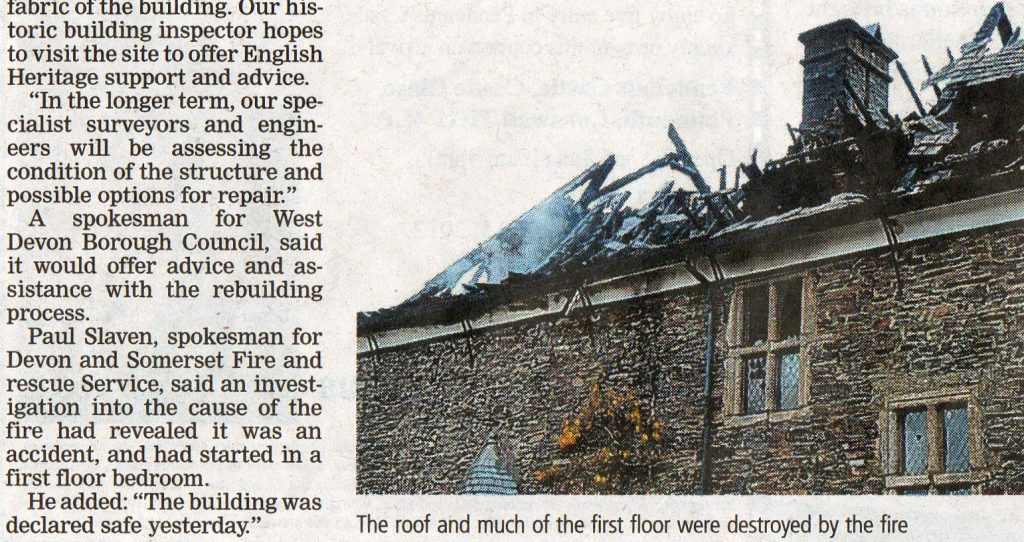
Fuel Tanker RTC at Tideford Report, December 12th, 2012.
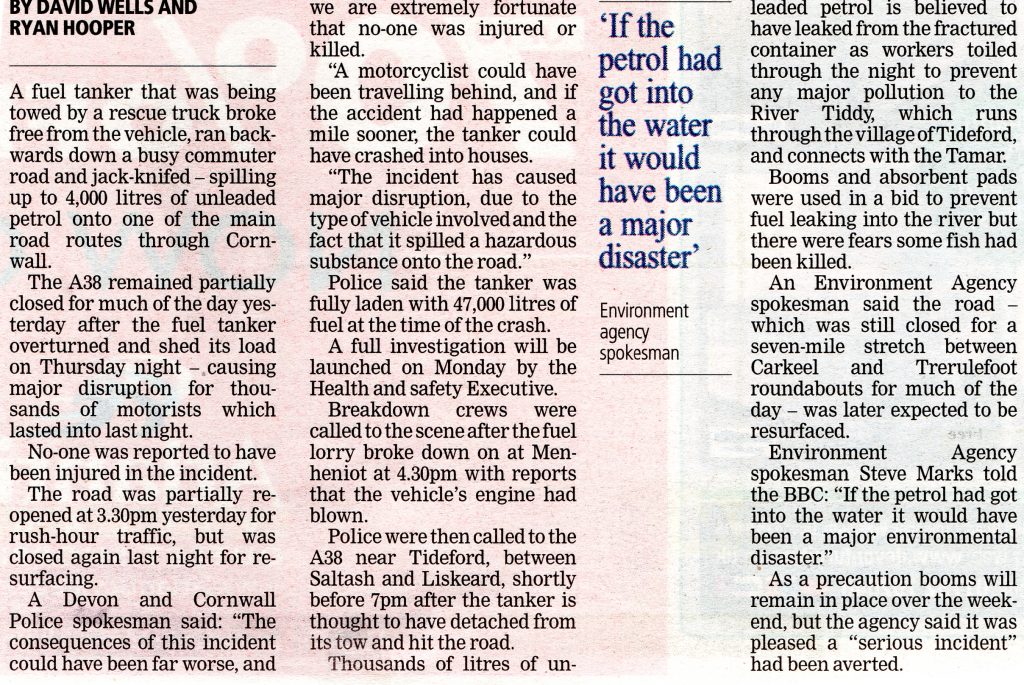
Canworthy Water Carbon Monoxide poisoning, January 23rd, 2013.
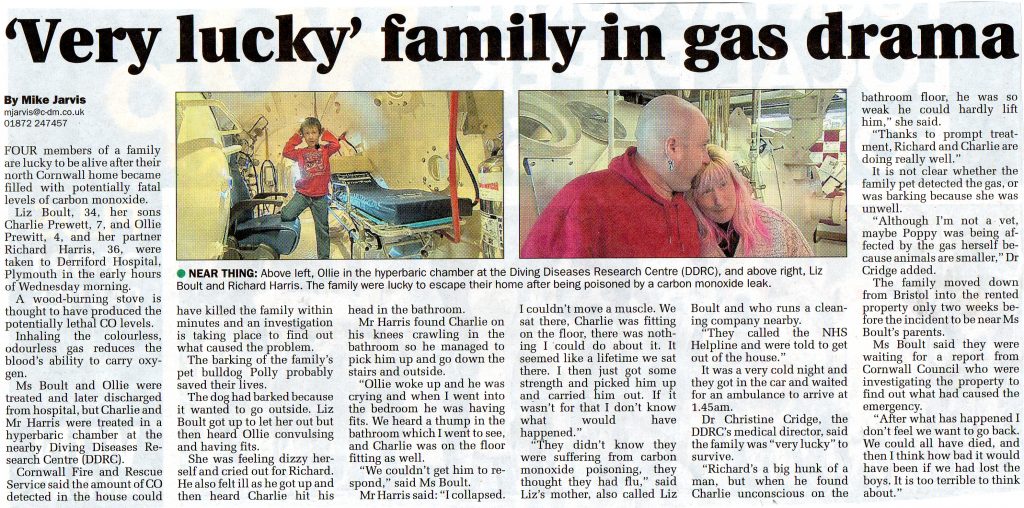

Ambrosia Chemical Spill, March 10th, 2013.

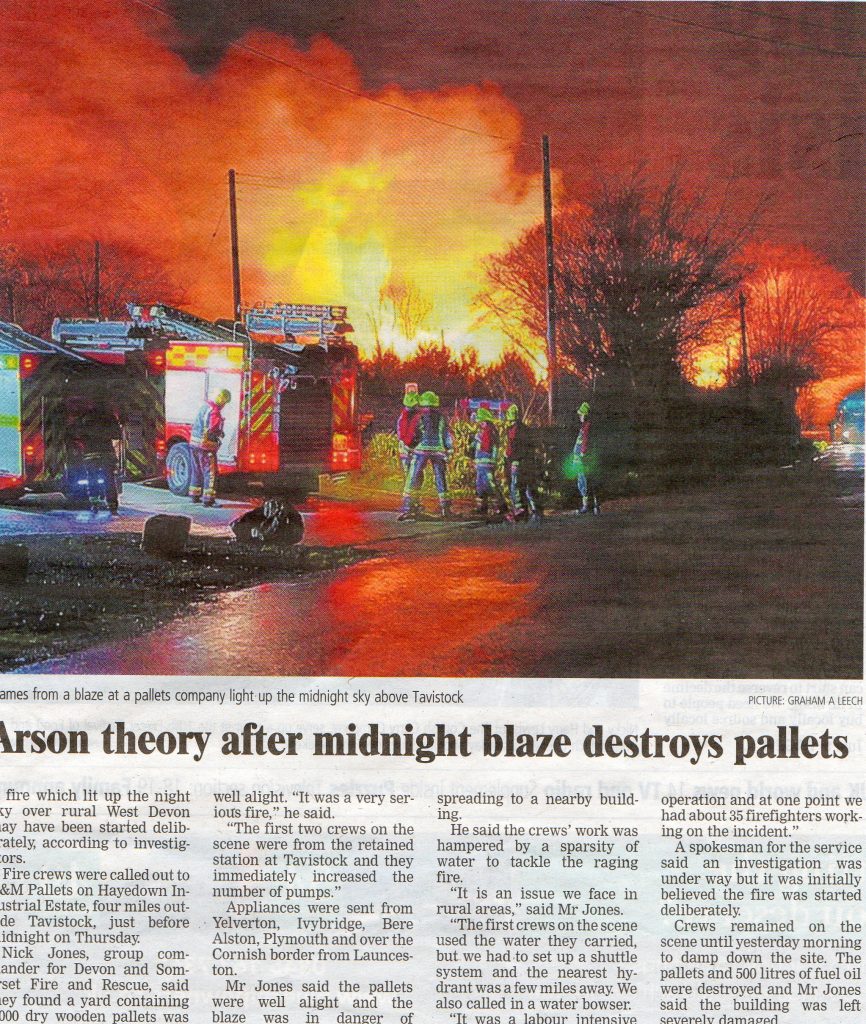
Summercourt Bus Depot Fire, May 13th, 2013.
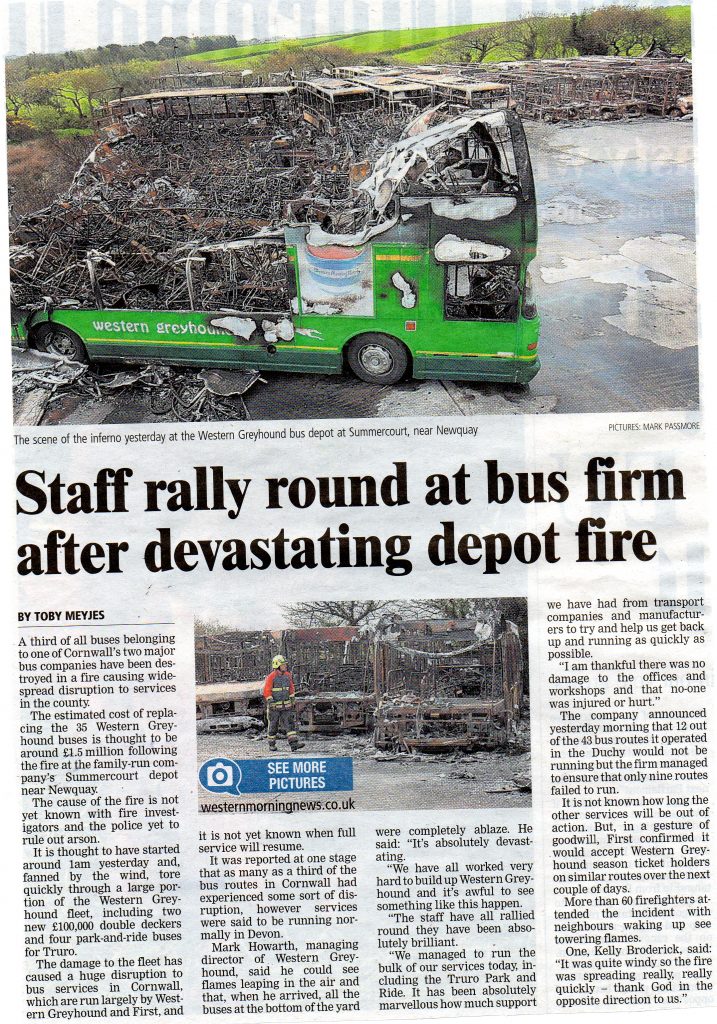
Great Trethew Hotel Fire, Horningtops, August 20th, 2013.
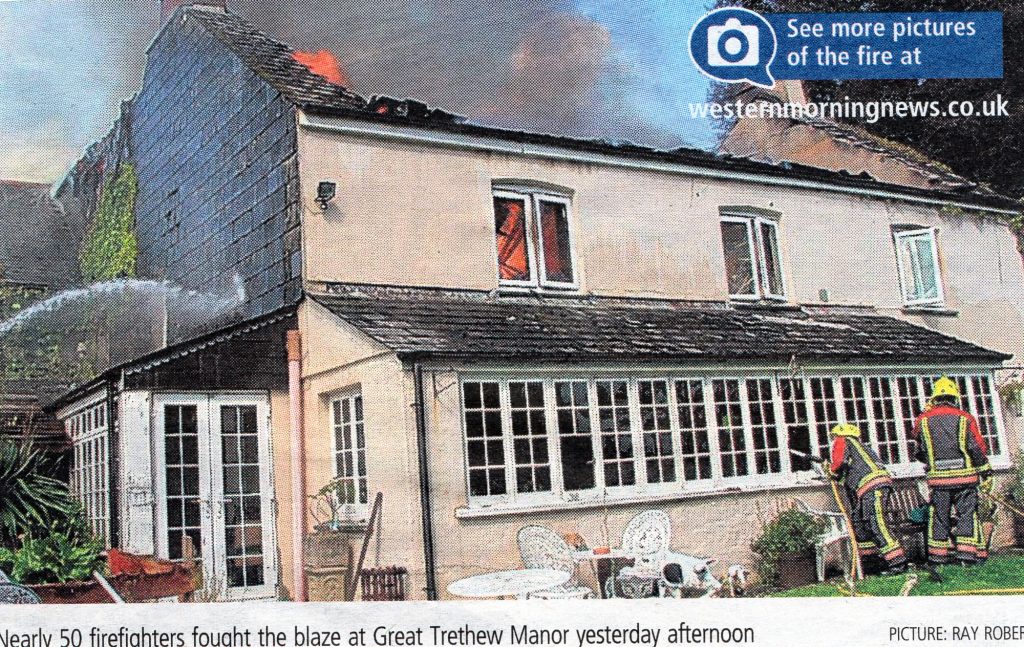
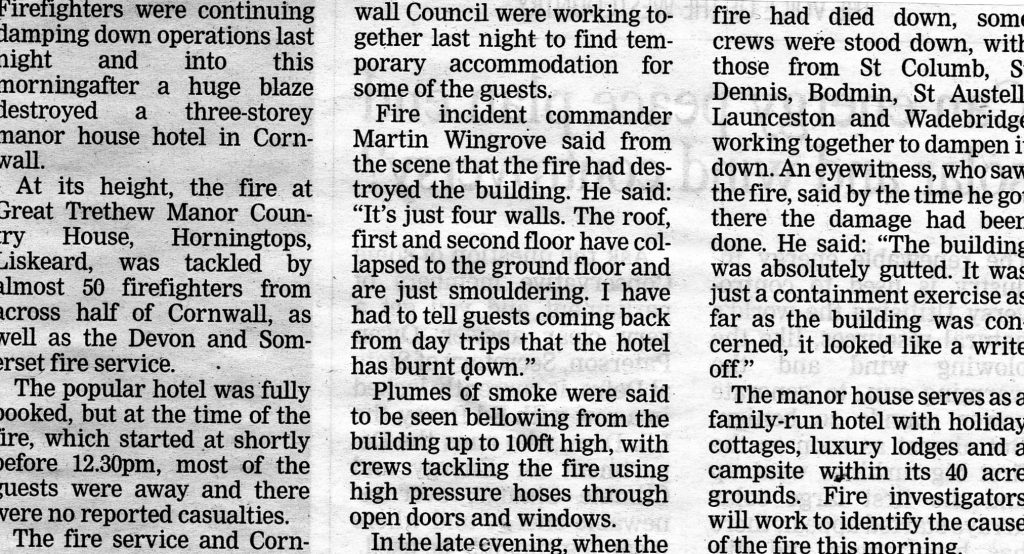
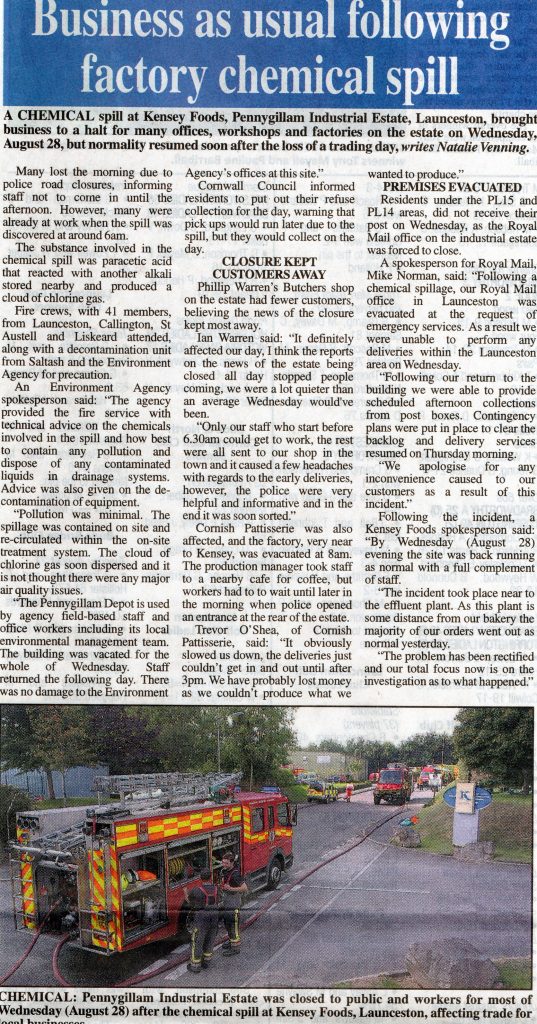
Suspicious Fire at Southern Court, Newport, September 2013.
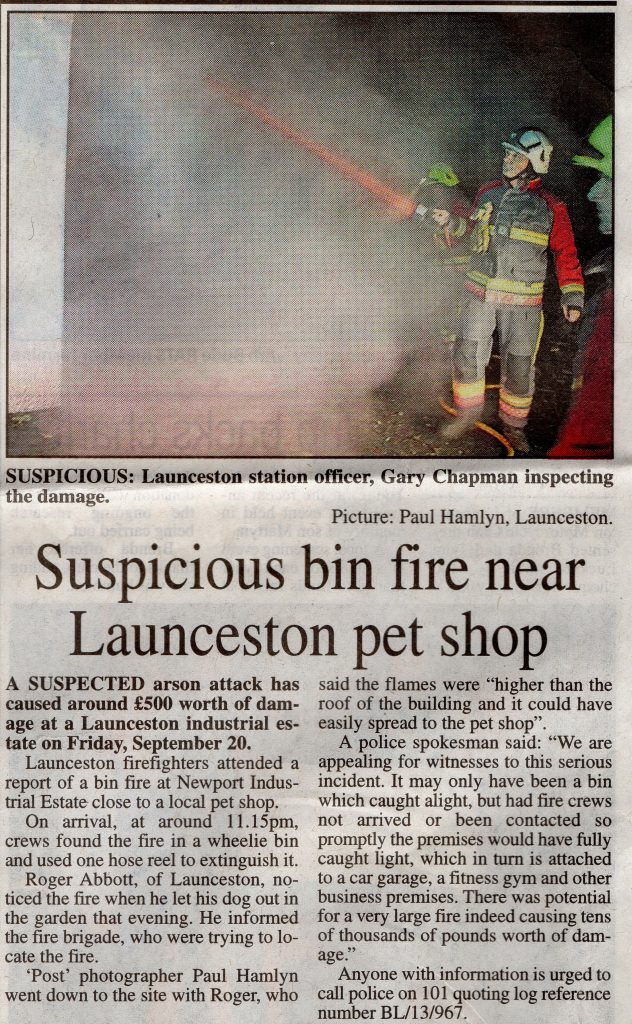
Homebase, Liskeard Retail Park Fire, September 28th, 2013.
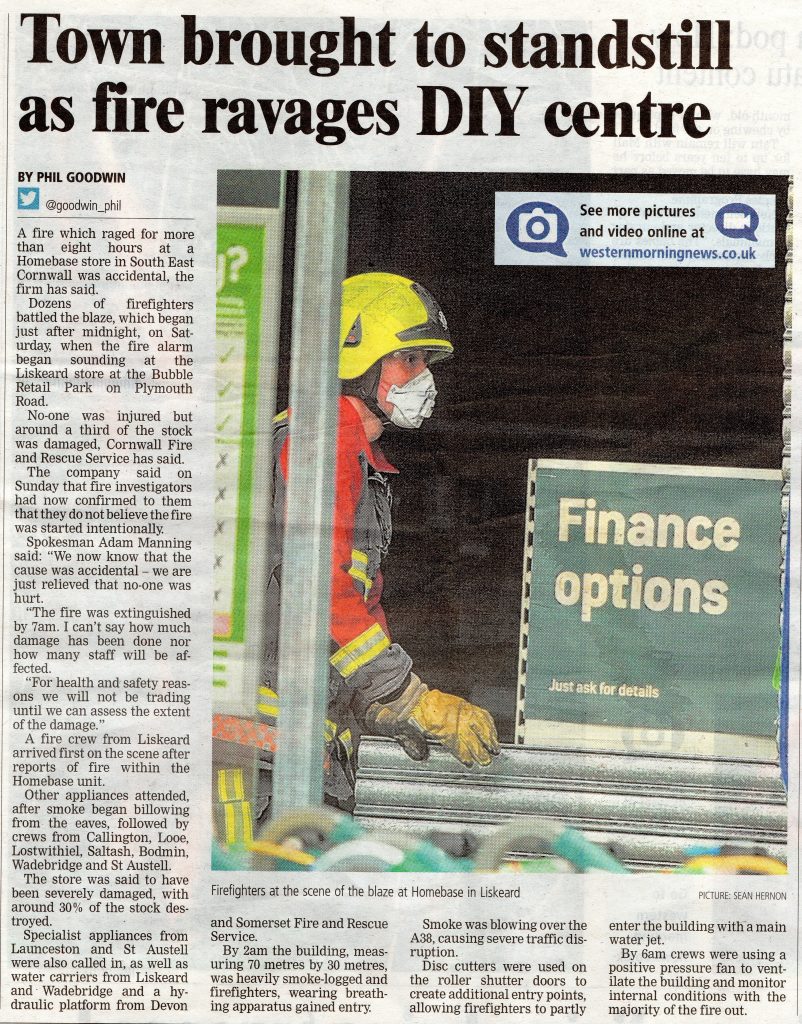
The collapse of the old Congregational Chapel, Castle Street, Launceston, November 28th, 2013.
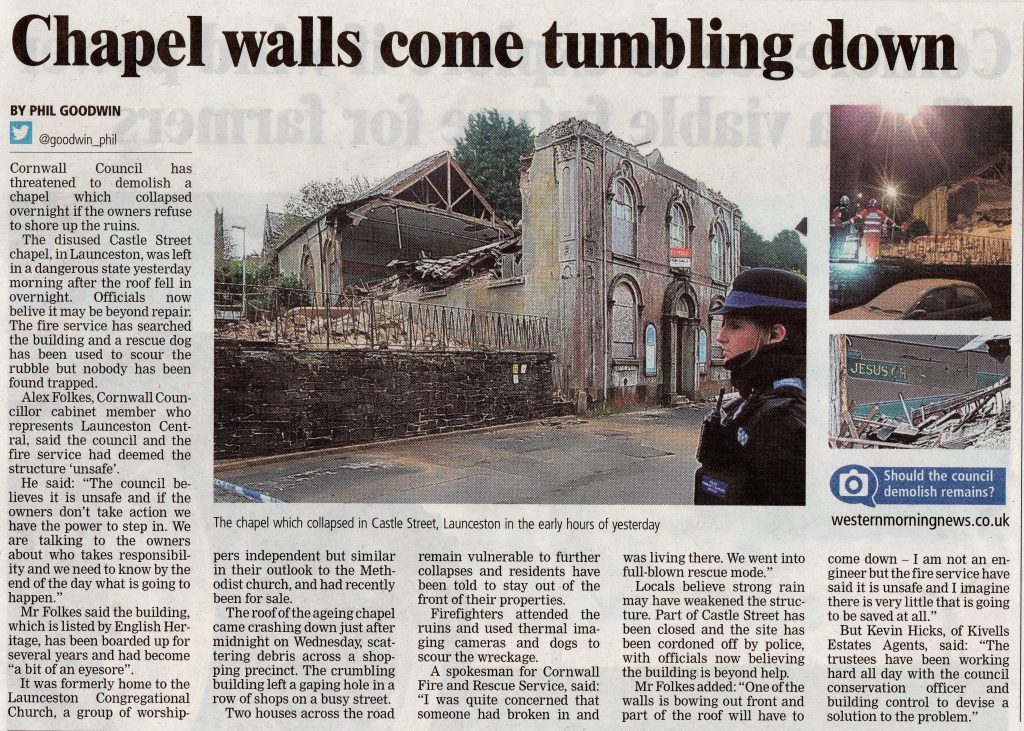

Shed Fire at Honiton Farm, South Petherwin, May 2014.
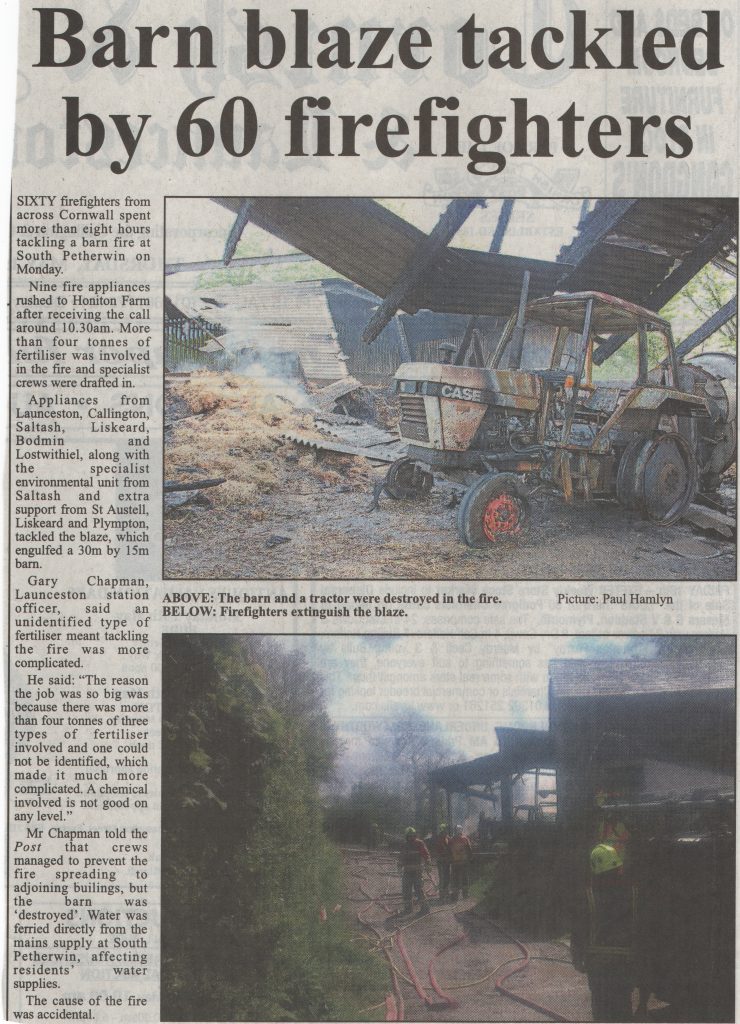
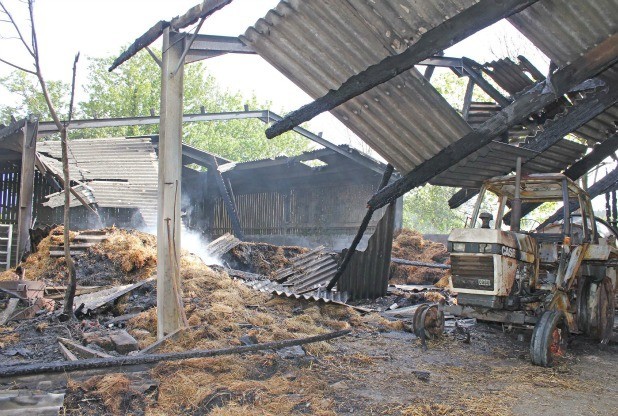
Visits: 323


